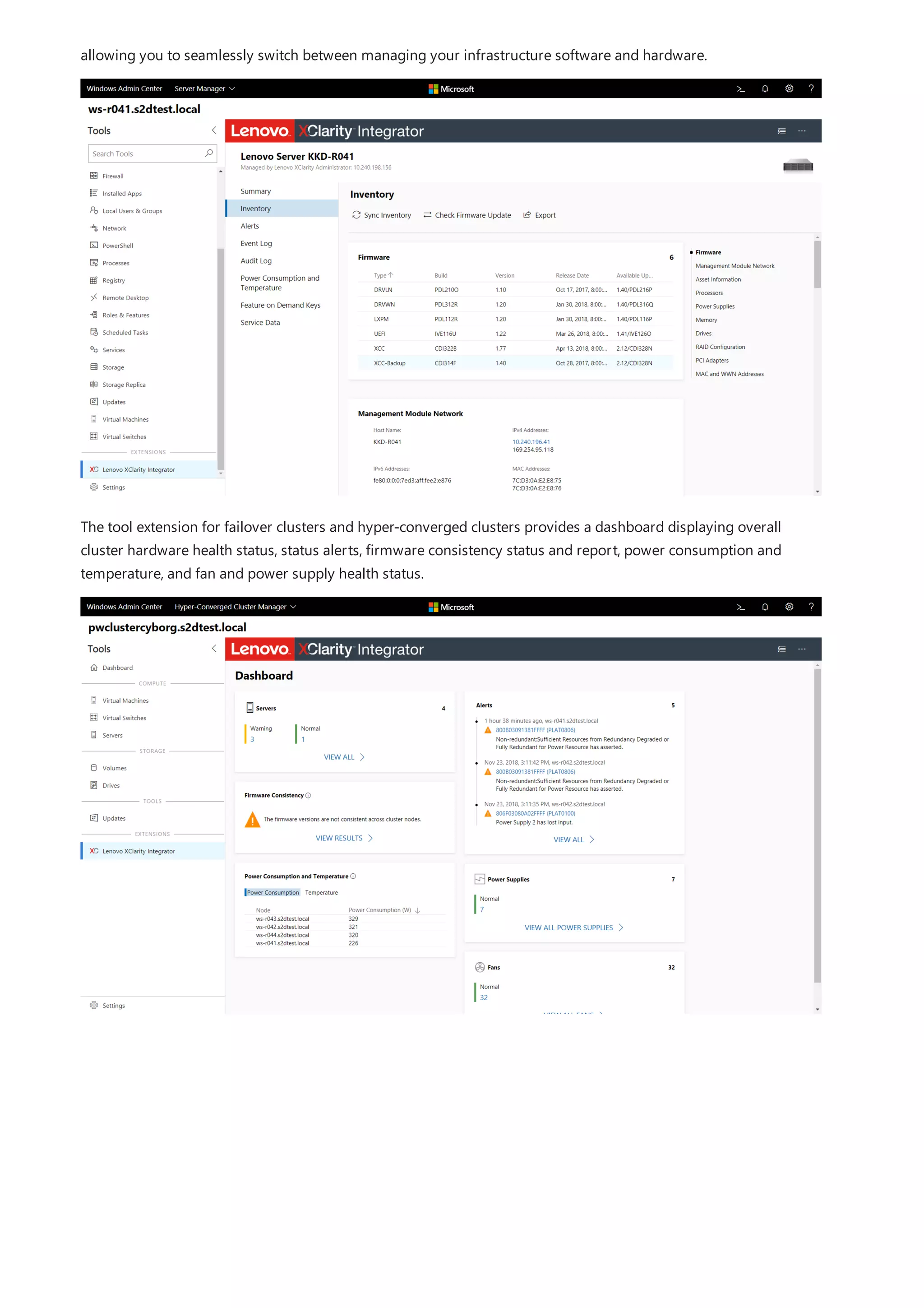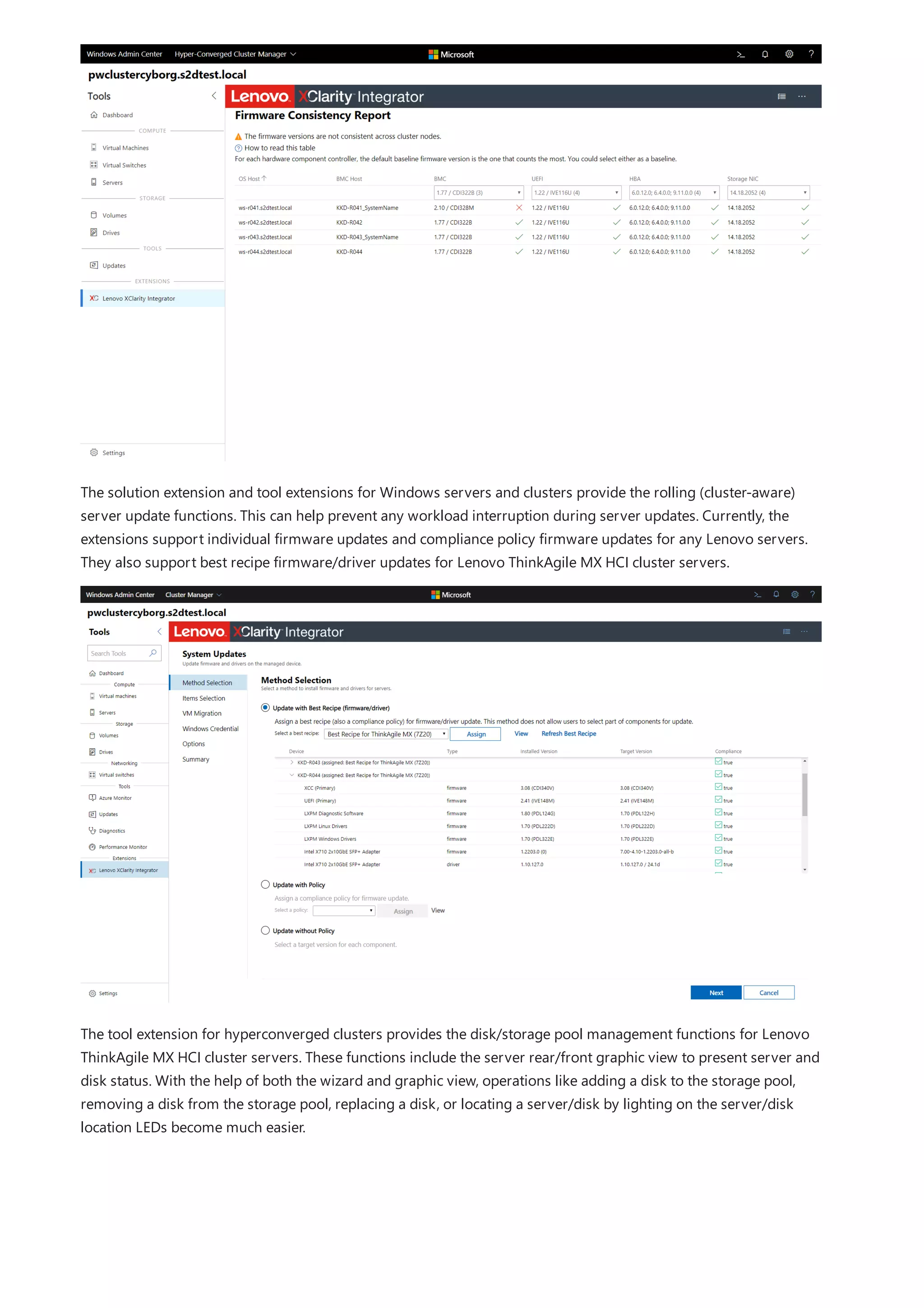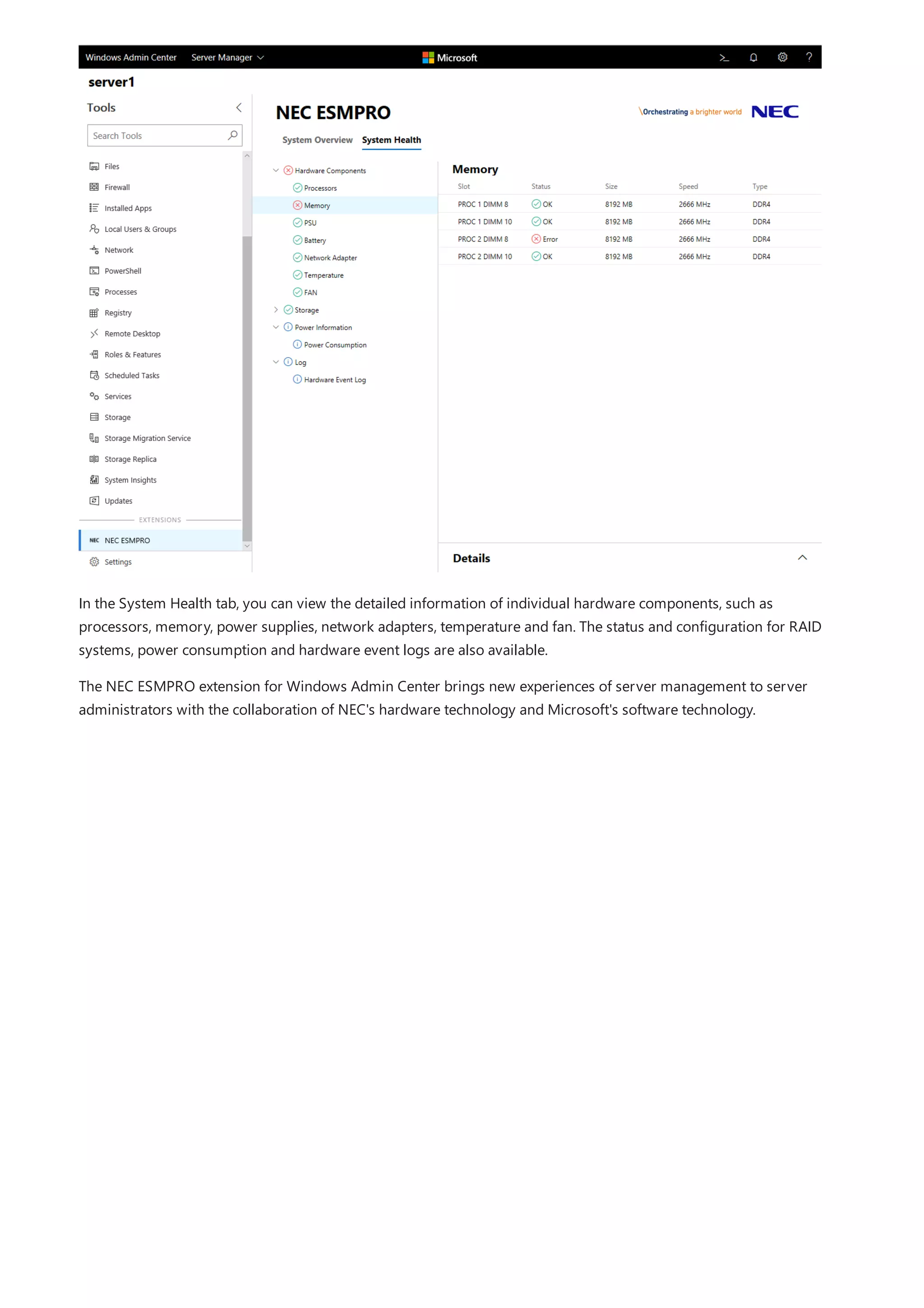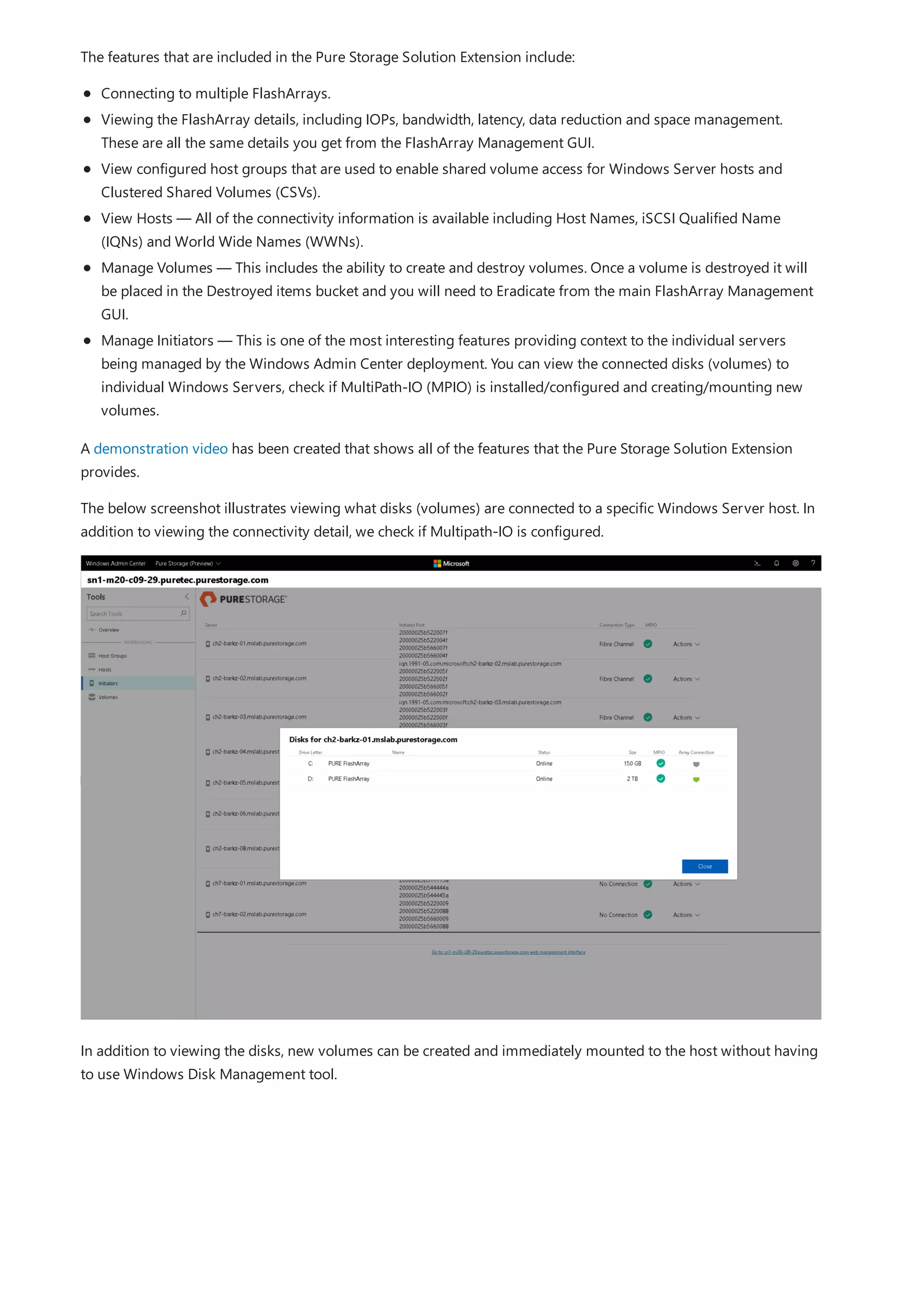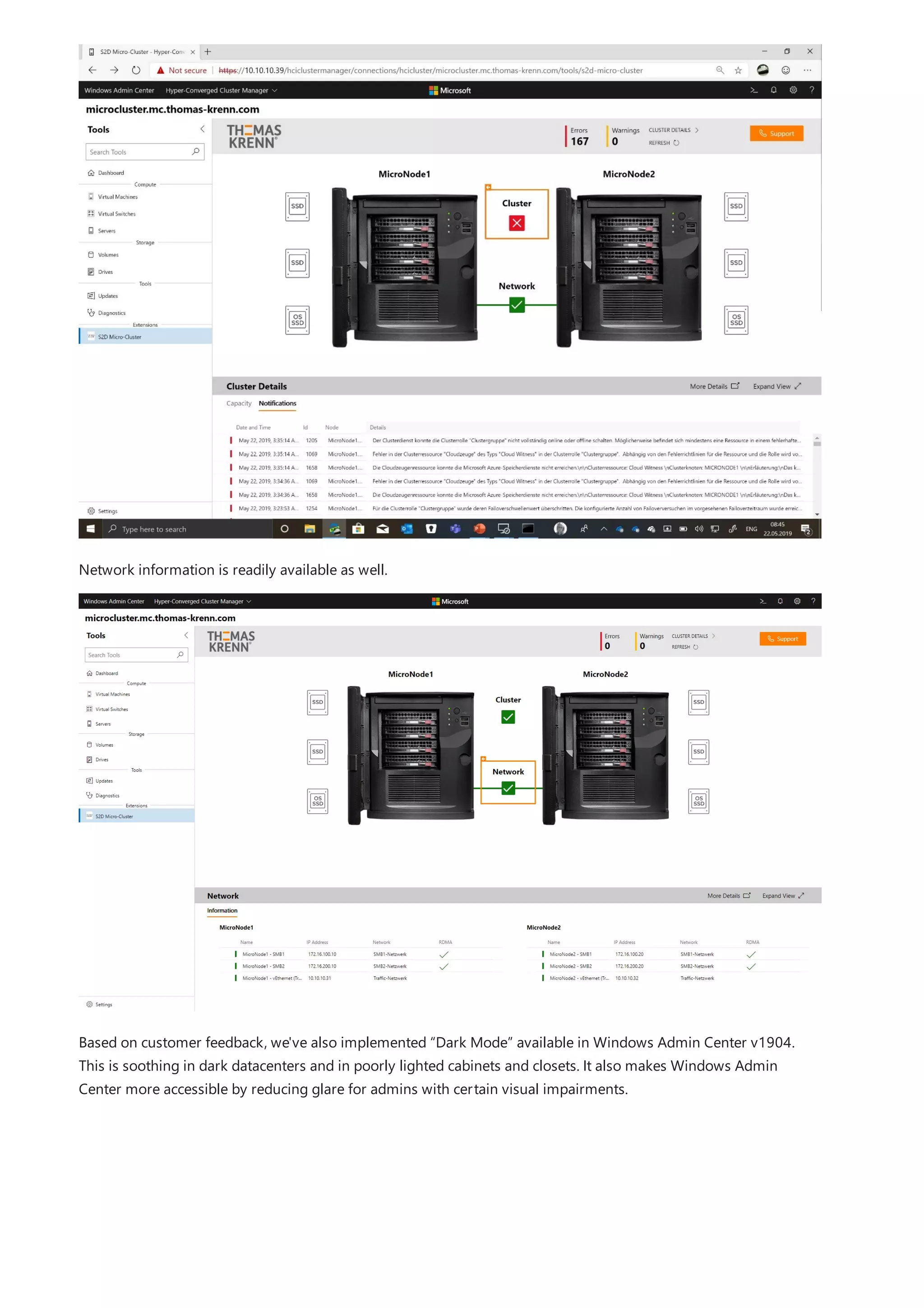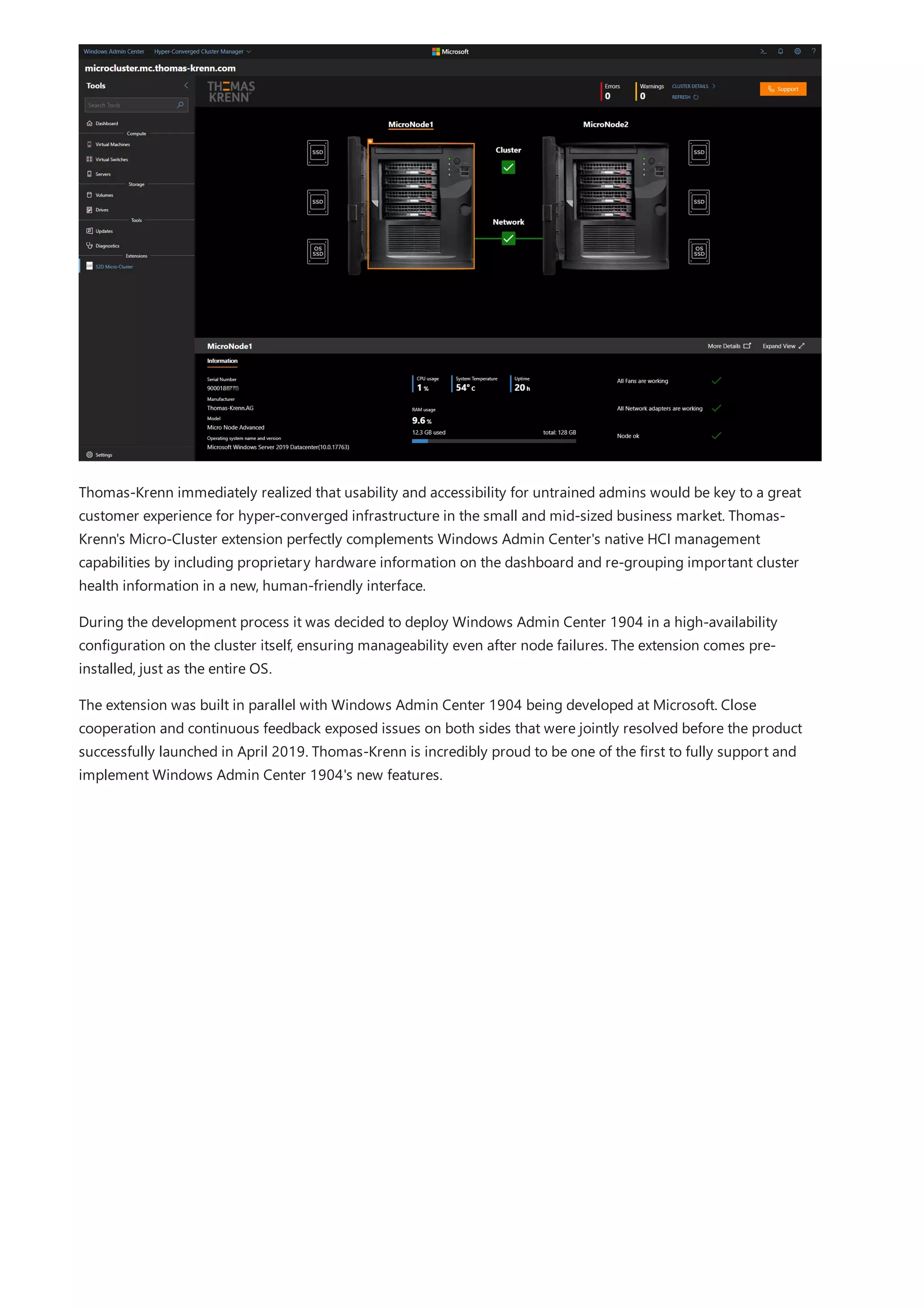Windows Admin Center is a browser-based tool for managing Windows servers and clients. It can be installed locally and manages servers through Remote PowerShell and WMI over WinRM. The Windows Admin Center gateway publishes to DNS and provides secure remote access and management from anywhere using Edge or Chrome. Windows Admin Center enhances security for management and complements existing solutions like System Center while providing familiar functionality in a modern package.

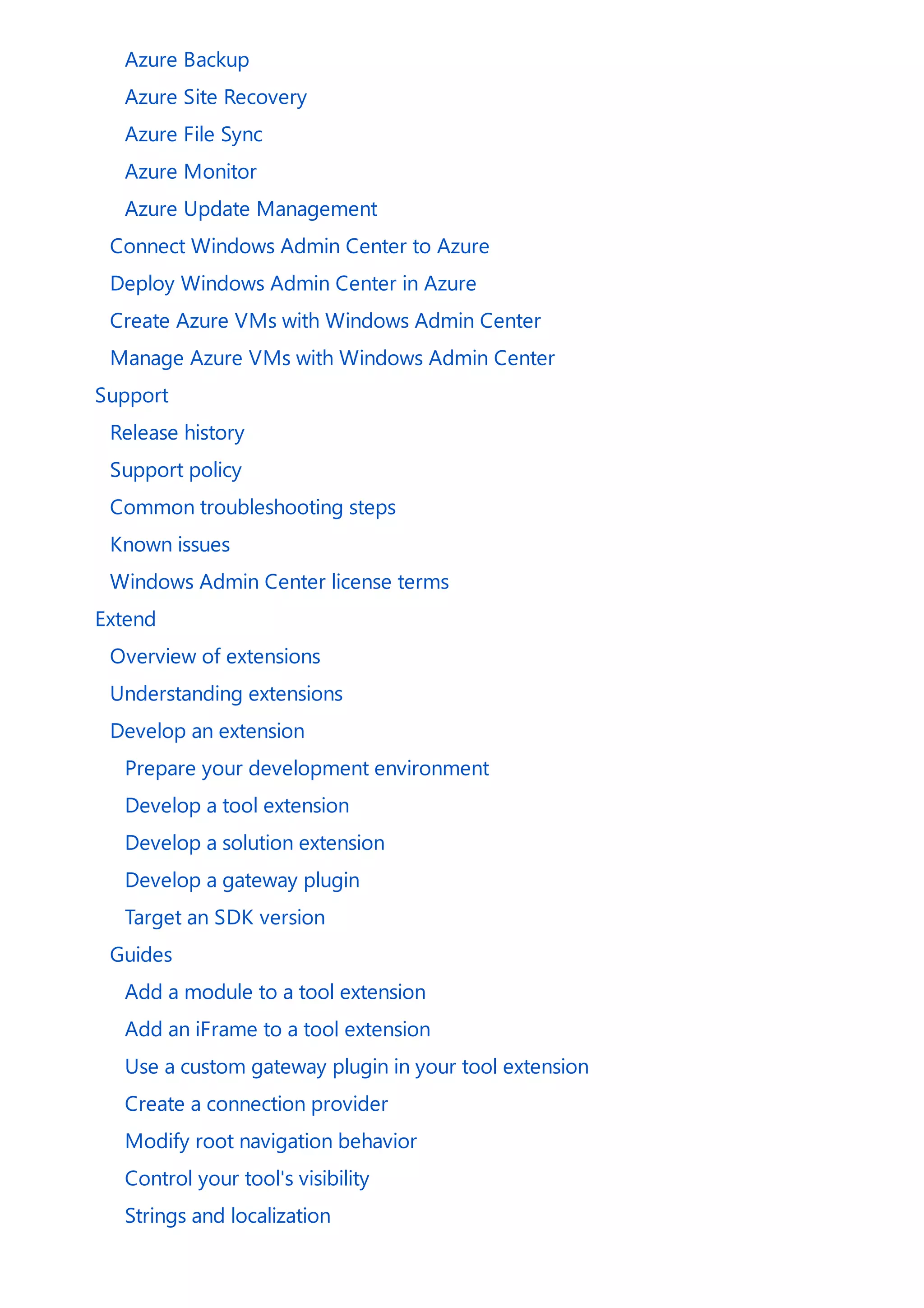



![Support Extend
Video-based learning
See how customers are benefitting from Windows Admin Center
"[Windows Admin Center] has decreased our time/effort in managing the management system by over 75%."
- Rand Morimoto, President, Convergent Computing
"Thanks to [Windows Admin Center], we can manage our customers remotely from HTML5 portal without problem and with
the full integration with Azure Active Directory, we are able to increase the security thanks to the Multi-Factor Authentication."
- Silvio Di Benedetto, Founder and Senior Consultant, Inside Technologies
“We have been able to deploy [Server Core] SKUs in a more effective way, improving resource efficiency, security and
automation while still achieving a good degree of productivity and reducing errors that can happen when relying on scripting
only.”
- Guglielmo Mengora, Founder and CEO, VaiSulWeb
“With [Windows Admin Center] customers especially in the SMB market now have an easy to use tool to manage their internal
infrastructure. This minimizes administrative efforts and saves a lot of time. And the best of it: there are no additional license
fees for [Windows Admin Center]!”
- Helmut Otto, Managing Director, SecureGUARD
Release history
Support policy
Common troubleshooting steps
Known issues
Overview of extensions
Understanding extensions
Develop an extension
Guides
Publishing extensions
Here are some videos from Microsoft Ignite 2019 sessions:
Windows Admin Center: Unlock Azure Hybrid value
Windows Admin Center: What’s new and what’s next
Automatically monitor, secure and update your on-premises servers from Azure with Windows Admin Center
Get more done with Windows Admin Center third-party extensions
Be a Windows Admin Center expert: Best practices for deployment, configuration, and security
Windows Admin Center: Better together with System Center and Microsoft Azure
How to use Microsoft Azure hybrid services together with Windows Admin Center and Windows Server
Live Q&A: Manage your hybrid server environment with Windows Admin Center
Learning Path: Hybrid management technologies
Hands on Lab: Windows Admin Center and Hybrid
Here are some videos from Windows Server Summit 2019 sessions:
Go hybrid with Windows Admin Center
What's new with Windows Admin Center v1904
And here are a few additional resources:
Windows Admin Center server management reimagined
Manage Servers and Virtual Machines Anywhere with Windows Admin Center
How to get started with Windows Admin Center](https://image.slidesharecdn.com/admincenter-201105101733/75/Admincenter-6-2048.jpg)
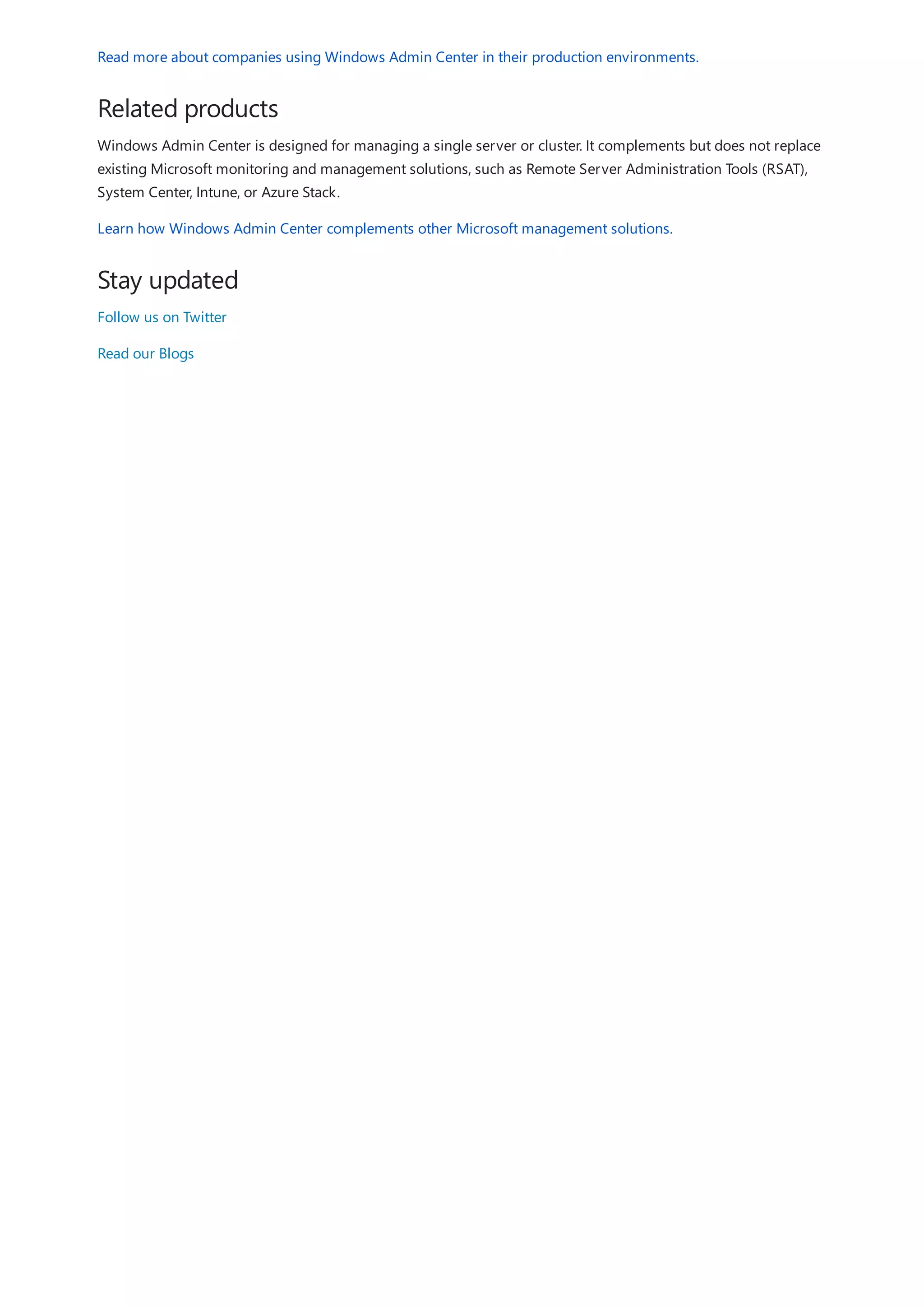

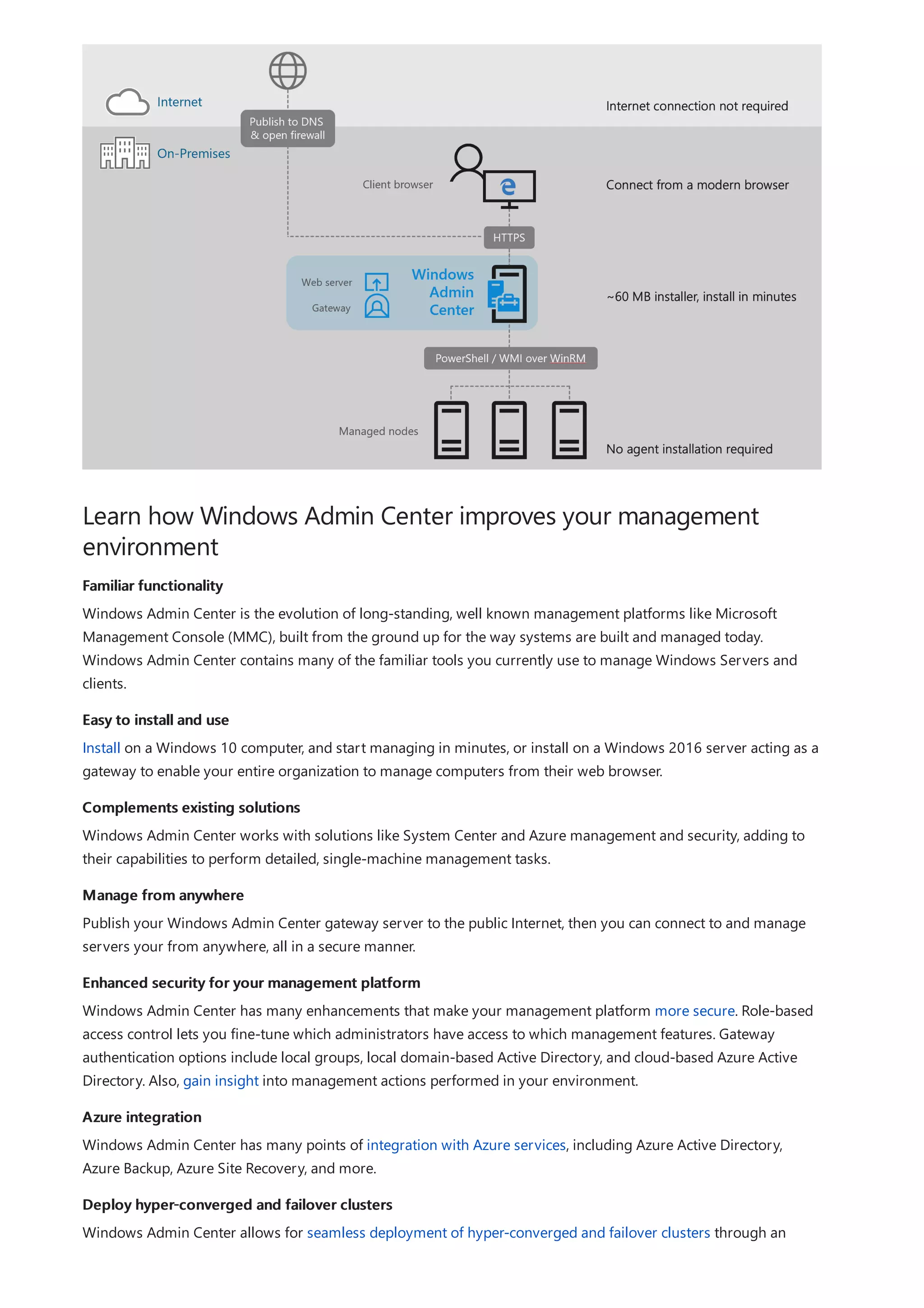






























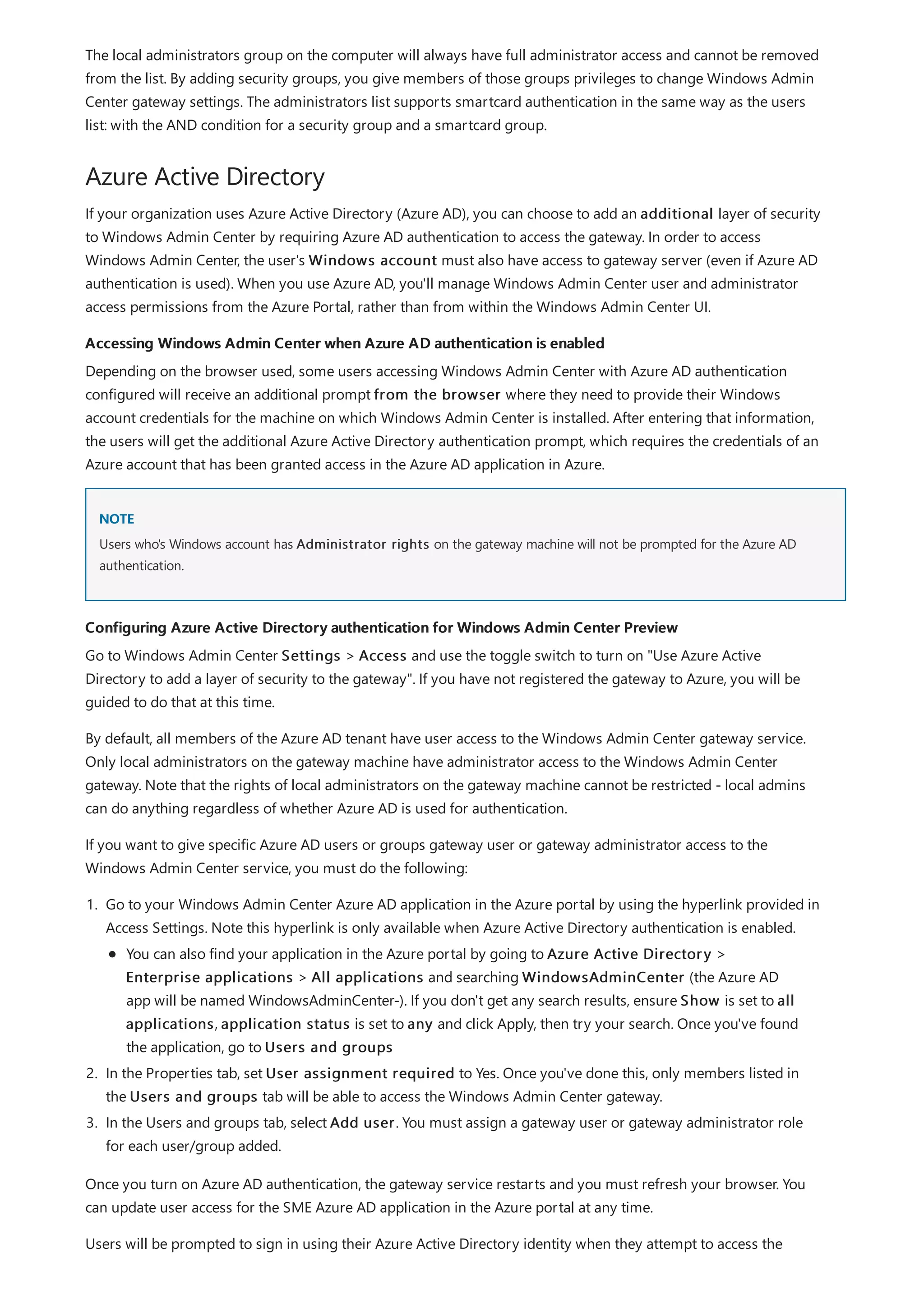
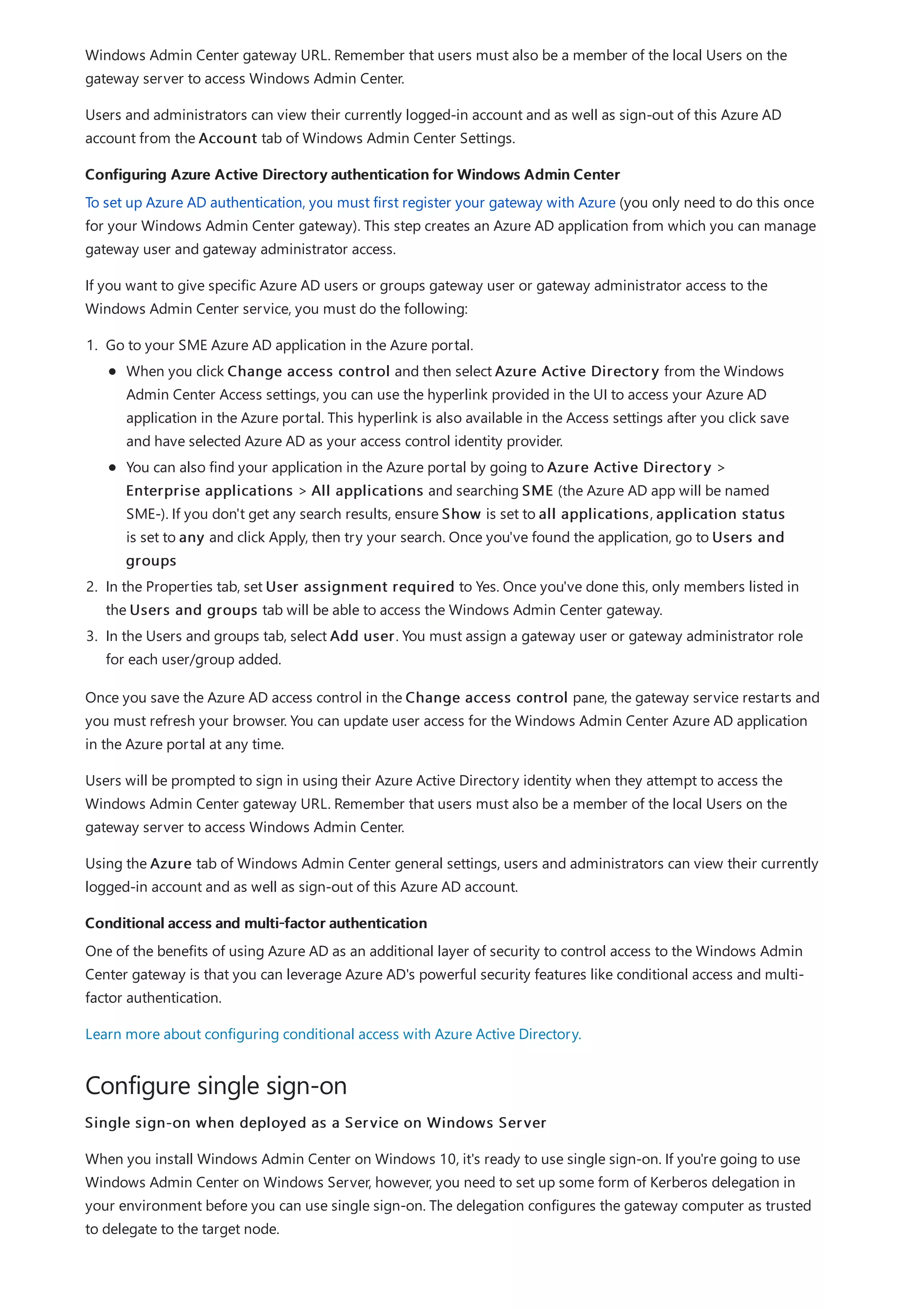
![Set-ADComputer -Identity (Get-ADComputer node01) -PrincipalsAllowedToDelegateToAccount (Get-ADComputer wac)
Set-ADComputer -Identity (Get-ADComputer node01) -PrincipalsAllowedToDelegateToAccount $null
Role-based access control
TIP
Apply role-based access control to a single machine
To configure Resource-based constrained delegation in your environment, use the following PowerShell example.
This example shows how you would configure a Windows Server [node01.contoso.com] to accept delegation from
your Windows Admin Center gateway [wac.contoso.com] in the contoso.com domain.
To remove this relationship, run the following cmdlet:
Role-based access control enables you to provide users with limited access to the machine instead of making them
full local administrators. Read more about role-based access control and the available roles.
Setting up RBAC consists of 2 steps: enabling support on the target computer(s) and assigning users to the
relevant roles.
Make sure you have local administrator privileges on the machines where you are configuring support for role-based access
control.
The single machine deployment model is ideal for simple environments with only a few computers to manage.
Configuring a machine with support for role-based access control will result in the following changes:
PowerShell modules with functions required by Windows Admin Center will be installed on your system drive,
under C:Program FilesWindowsPowerShellModules . All modules will start with Microsoft.Sme
Desired State Configuration will run a one-time configuration to configure a Just Enough Administration
endpoint on the machine, named Microsoft.Sme.PowerShell. This endpoint defines the 3 roles used by
Windows Admin Center and will run as a temporary local administrator when a user connects to it.
3 new local groups will be created to control which users are assigned access to which roles:
Windows Admin Center Administrators
Windows Admin Center Hyper-V Administrators
Windows Admin Center Readers
To enable support for role-based access control on a single machine, follow these steps:
1. Open Windows Admin Center and connect to the machine you wish to configure with role-based access control
using an account with local administrator privileges on the target machine.
2. On the Overview tool, click Settings > Role-based access control.
3. Click Apply at the bottom of the page to enable support for role-based access control on the target computer.
The application process involves copying PowerShell scripts and invoking a configuration (using PowerShell
Desired State Configuration) on the target machine. It may take up to 10 minutes to complete, and will result in
WinRM restarting. This will temporarily disconnect Windows Admin Center, PowerShell, and WMI users.
4. Refresh the page to check the status of role-based access control. When it is ready for use, the status will
change to Applied.
Once the configuration is applied, you can assign users to the roles:
1. Open the Local Users and Groups tool and navigate to the Groups tab.](https://image.slidesharecdn.com/admincenter-201105101733/75/Admincenter-42-2048.jpg)
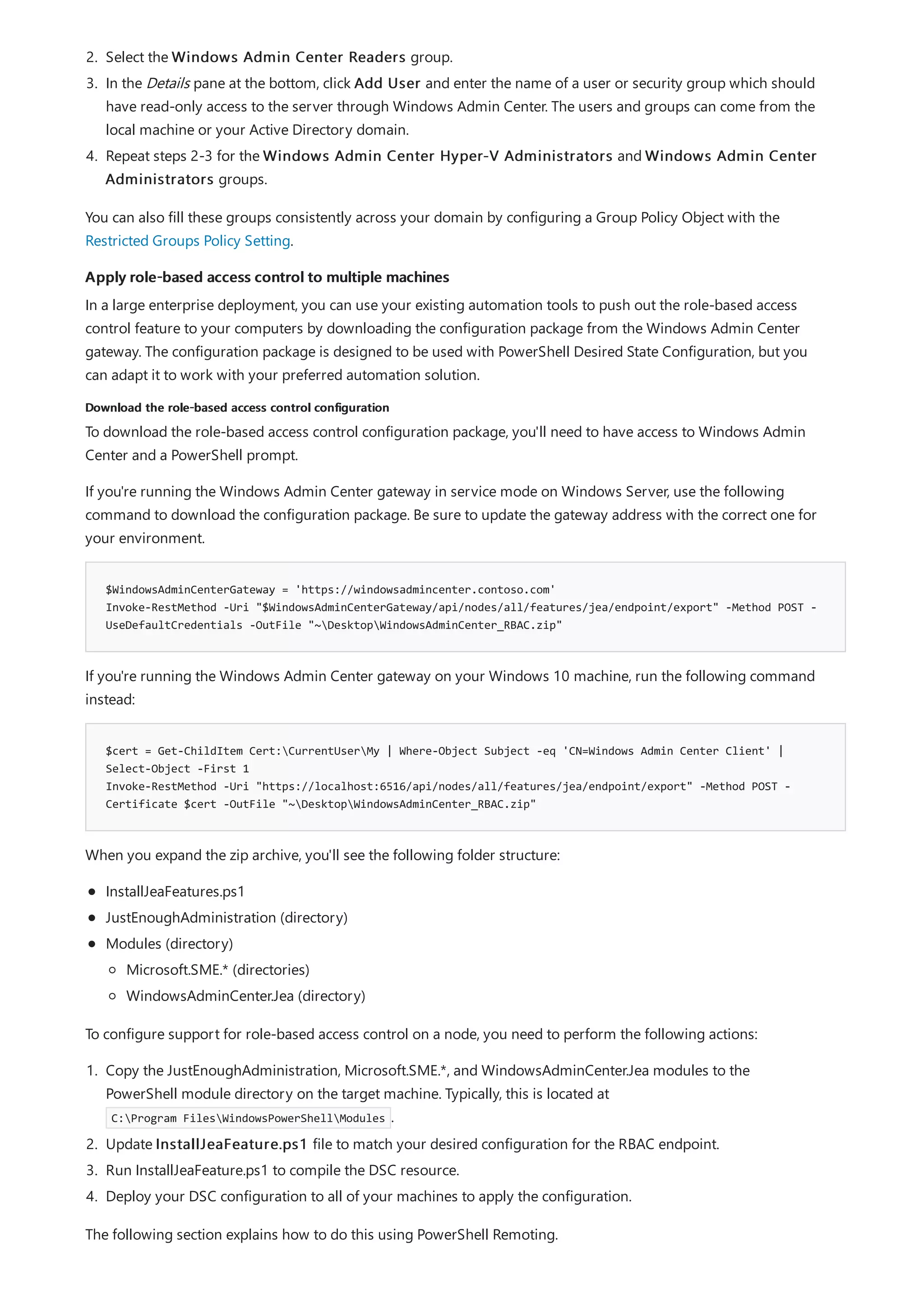
![Deploy on multiple machines
NOTE
Copy-Item "$PSScriptRootJustEnoughAdministration" "$env:ProgramFilesWindowsPowerShellModules" -Recurse -
Force
$ConfigData = @{
AllNodes = @()
ModuleBasePath = @{
Source = "$PSScriptRootModules"
Destination = "$env:ProgramFilesWindowsPowerShellModules"
}
}
InstallJeaFeature -ConfigurationData $ConfigData | Out-Null
Start-DscConfiguration -Path "$PSScriptRootInstallJeaFeature" -JobName "Installing JEA for Windows Admin
Center" -Force
To deploy the configuration you downloaded onto multiple machines, you'll need to update the
InstallJeaFeatures.ps1 script to include the appropriate security groups for your environment, copy the files to
each of your computers, and invoke the configuration scripts. You can use your preferred automation tooling to
accomplish this, however this article will focus on a pure PowerShell-based approach.
By default, the configuration script will create local security groups on the machine to control access to each of the
roles. This is suitable for workgroup and domain joined machines, but if you're deploying in a domain-only
environment you may wish to directly associate a domain security group with each role. To update the
configuration to use domain security groups, open InstallJeaFeatures.ps1 and make the following changes:
1. Remove the 3 Group resources from the file:
2. Remove the 3 Group resources from the JeaEndpoint DependsOn property
3. Change the group names in the JeaEndpoint RoleDefinitions property to your desired security groups. For
example, if you have a security group CONTOSOMyTrustedAdmins that should be assigned access to the
Windows Admin Center Administrators role, change '$env:COMPUTERNAMEWindows Admin Center Administrators'
to 'CONTOSOMyTrustedAdmins' . The three strings you need to update are:
a. "Group MS-Readers-Group"
b. "Group MS-Hyper-V-Administrators-Group"
c. "Group MS-Administrators-Group"
a. "[Group]MS-Readers-Group"
b. "[Group]MS-Hyper-V-Administrators-Group"
c. "[Group]MS-Administrators-Group"
a. '$env:COMPUTERNAMEWindows Admin Center Administrators'
b. '$env:COMPUTERNAMEWindows Admin Center Hyper-V Administrators'
c. '$env:COMPUTERNAMEWindows Admin Center Readers'
Be sure to use unique security groups for each role. Configuration will fail if the same security group is assigned to multiple
roles.
Next, at the end of the InstallJeaFeatures.ps1 file, add the following lines of PowerShell to the bottom of the
script:
Finally, you can copy the folder containing the modules, DSC resource and configuration to each target node and
run the InstallJeaFeature.ps1 script. To do this remotely from your admin workstation, you can run the following
commands:](https://image.slidesharecdn.com/admincenter-201105101733/75/Admincenter-44-2048.jpg)



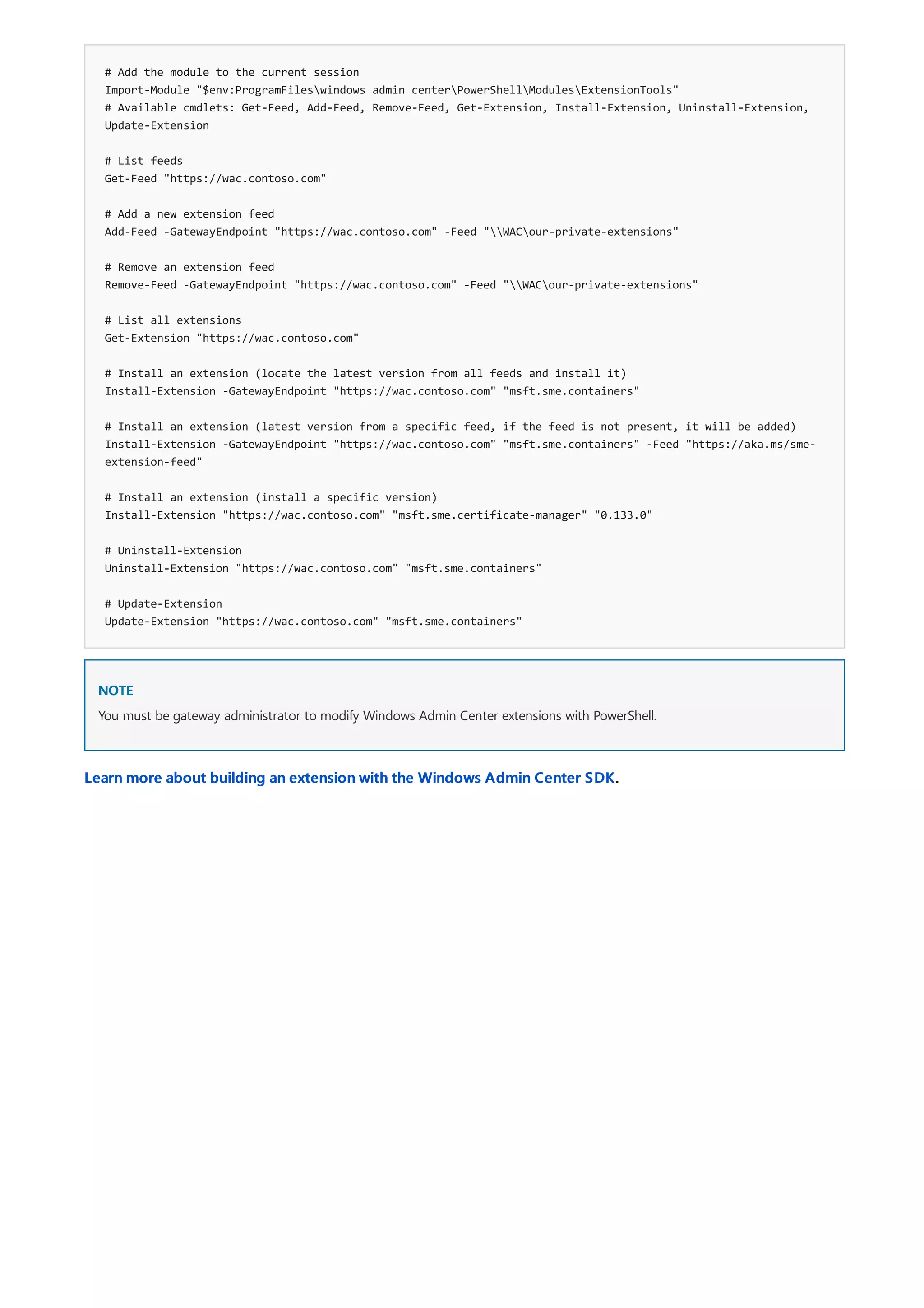
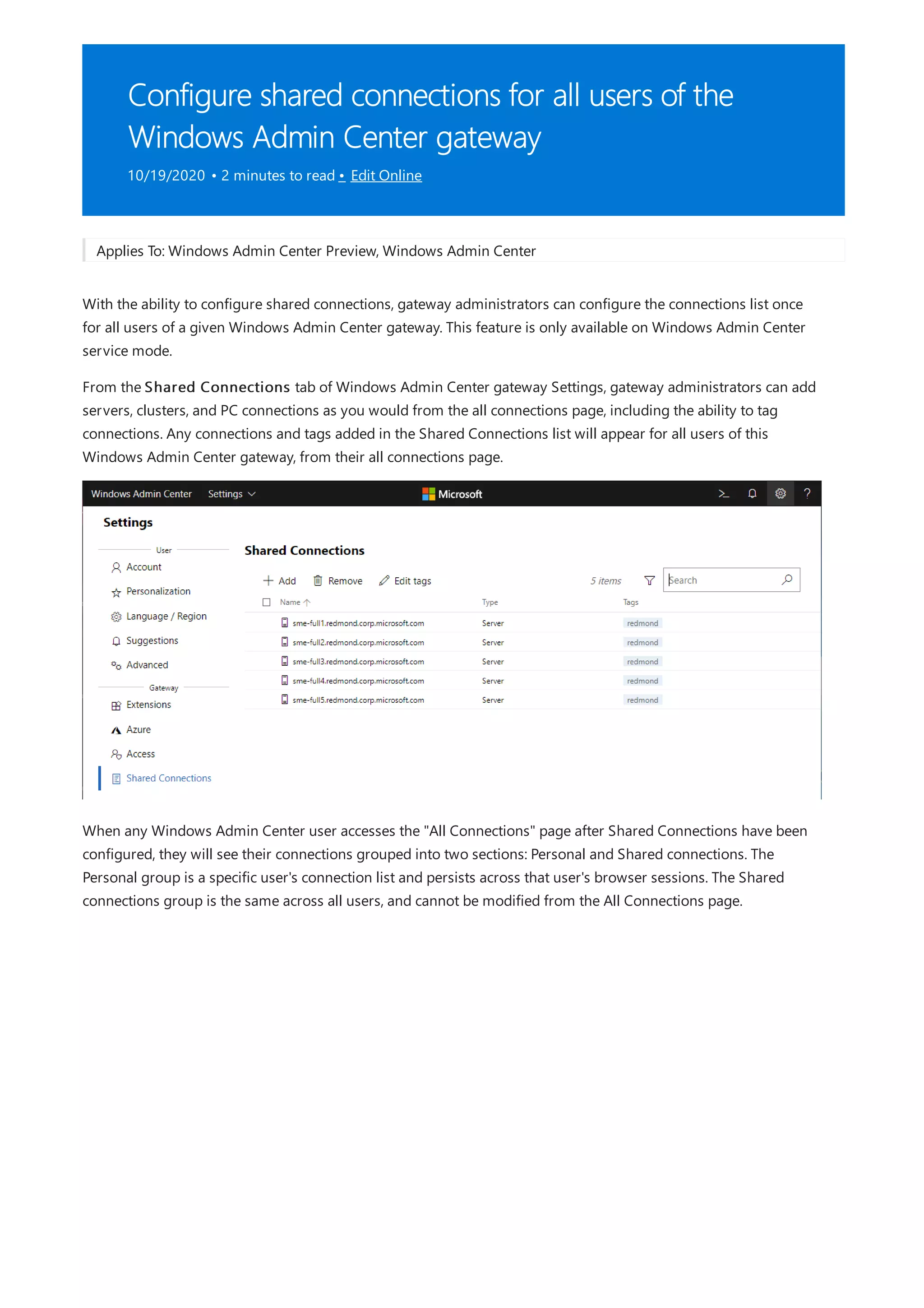


!["name","type","tags","groupId"
"myServer.contoso.com","msft.sme.connection-type.server","hyperv"
"myDesktop.contoso.com","msft.sme.connection-type.windows-client","hyperv"
"teamcluster.contoso.com","msft.sme.connection-type.cluster","legacyCluster|WS2016","global"
"myHCIcluster.contoso.com,"msft.sme.connection-type.hyper-converged-cluster","myHCIcluster|hyperv|JIT|WS2019"
"teamclusterNode.contoso.com","msft.sme.connection-type.server","legacyCluster|WS2016","global"
"myHCIclusterNode.contoso.com","msft.sme.connection-type.server","myHCIcluster|hyperv|JIT|WS2019"
Import RDCman connections
Use the script below to export saved connections in RDCman to a file. You can then import the file into Windows
Admin Center, maintaining your RDCMan grouping hierarchy using tags. Try it out!
#Helper function for RdgToWacCsv
function AddServers {
param (
[Parameter(Mandatory = $true)]
[Xml.XmlLinkedNode]
$node,
[Parameter()]
[String[]]
$tags,
[Parameter(Mandatory = $true)]
[String]
$csvPath
)
if ($node.LocalName -eq 'server') {
$serverName = $node.properties.name
$tagString = $tags -join "|"
Add-Content -Path $csvPath -Value ('"'+ $serverName + '","msft.sme.connection-type.server","'+
$tagString +'"')
}
elseif ($node.LocalName -eq 'group' -or $node.LocalName -eq 'file') {
$groupName = $node.properties.name
$tags+=$groupName
$currNode = $node.properties.NextSibling
while ($currNode) {
AddServers -node $currNode -tags $tags -csvPath $csvPath
$currNode = $currNode.NextSibling
}
}
else {
# Node type isn't relevant to tagging or adding connections in WAC
}
return
}
<#
.SYNOPSIS
Convert an .rdg file from Remote Desktop Connection Manager into a .csv that can be imported into
Windows Admin Center, maintaining groups via server tags. This will not modify the existing .rdg file
and will create a new .csv file
.DESCRIPTION
This converts an .rdg file into a .csv that can be imported into Windows Admin Center.
.PARAMETER RDGfilepath
The path of the .rdg file to be converted. This file will not be modified, only read.
.PARAMETER CSVdirectory
Optional. The directory you wish to export the new .csv file. If not provided, the new file is created
in the same directory as the .rdg file.
1. Copy and paste the code below into your PowerShell session:](https://image.slidesharecdn.com/admincenter-201105101733/75/Admincenter-52-2048.jpg)
![Manage Windows Admin Center extensions with PowerShell
.EXAMPLE
C:PS> RdgToWacCsv -RDGfilepath "rdcmangroup.rdg"
#>
function RdgToWacCsv {
param(
[Parameter(Mandatory = $true)]
[String]
$RDGfilepath,
[Parameter(Mandatory = $false)]
[String]
$CSVdirectory
)
[xml]$RDGfile = Get-Content -Path $RDGfilepath
$node = $RDGfile.RDCMan.file
if (!$CSVdirectory){
$csvPath = [System.IO.Path]::GetDirectoryName($RDGfilepath) +
[System.IO.Path]::GetFileNameWithoutExtension($RDGfilepath) + "_WAC.csv"
} else {
$csvPath = $CSVdirectory + [System.IO.Path]::GetFileNameWithoutExtension($RDGfilepath) + "_WAC.csv"
}
New-item -Path $csvPath
Add-Content -Path $csvPath -Value '"name","type","tags"'
AddServers -node $node -csvPath $csvPath
Write-Host "Converted $RDGfilepath `nOutput: $csvPath"
}
RdgToWacCsv -RDGfilepath "pathtomyRDCManfile.rdg"
2. To create a .CSV file, run the following command:
3. Import the resulting .CSV file in to Windows Admin Center, and all your RDCMan grouping hierarchy will be
represented by tags in the connection list. For details, see Use PowerShell to import or export your
connections (with tags).](https://image.slidesharecdn.com/admincenter-201105101733/75/Admincenter-53-2048.jpg)



After you have completed the installation of Windows Admin Center, you can add servers or clusters to manage
from the main overview page.
Add a single server or a cluster as a managed node
1. Click + Add under All Connections.](https://image.slidesharecdn.com/admincenter-201105101733/75/Admincenter-56-2048.jpg)



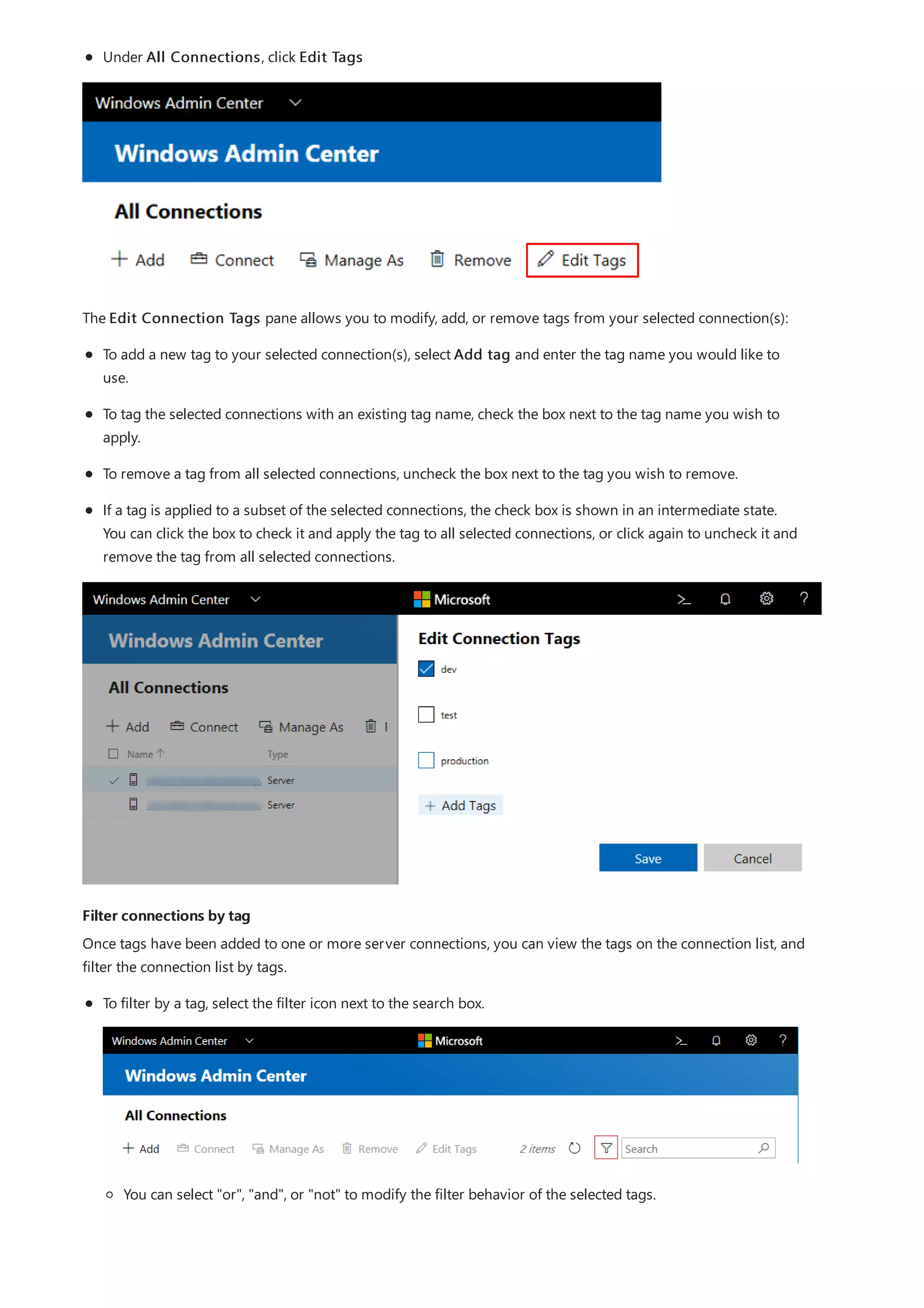

![Example CSV file for importing connections
"name","type","tags","groupId"
"myServer.contoso.com","msft.sme.connection-type.server","hyperv"
"myDesktop.contoso.com","msft.sme.connection-type.windows-client","hyperv"
"teamcluster.contoso.com","msft.sme.connection-type.cluster","legacyCluster|WS2016","global"
"myHCIcluster.contoso.com,"msft.sme.connection-type.hyper-converged-cluster","myHCIcluster|hyperv|JIT|WS2019"
"teamclusterNode.contoso.com","msft.sme.connection-type.server","legacyCluster|WS2016","global"
"myHCIclusterNode.contoso.com","msft.sme.connection-type.server","myHCIcluster|hyperv|JIT|WS2019"
Import RDCman connections
Use the script below to export saved connections in RDCman to a file. You can then import the file into Windows
Admin Center, maintaining your RDCMan grouping hierarchy using tags. Try it out!
#Helper function for RdgToWacCsv
function AddServers {
param (
[Parameter(Mandatory = $true)]
[Xml.XmlLinkedNode]
$node,
[Parameter()]
[String[]]
$tags,
[Parameter(Mandatory = $true)]
[String]
$csvPath
)
if ($node.LocalName -eq 'server') {
$serverName = $node.properties.name
$tagString = $tags -join "|"
Add-Content -Path $csvPath -Value ('"'+ $serverName + '","msft.sme.connection-type.server","'+
$tagString +'"')
}
elseif ($node.LocalName -eq 'group' -or $node.LocalName -eq 'file') {
$groupName = $node.properties.name
$tags+=$groupName
$currNode = $node.properties.NextSibling
while ($currNode) {
AddServers -node $currNode -tags $tags -csvPath $csvPath
$currNode = $currNode.NextSibling
}
}
else {
# Node type isn't relevant to tagging or adding connections in WAC
}
return
}
<#
.SYNOPSIS
Convert an .rdg file from Remote Desktop Connection Manager into a .csv that can be imported into
Windows Admin Center, maintaining groups via server tags. This will not modify the existing .rdg file
and will create a new .csv file
.DESCRIPTION
This converts an .rdg file into a .csv that can be imported into Windows Admin Center.
.PARAMETER RDGfilepath
The path of the .rdg file to be converted. This file will not be modified, only read.
.PARAMETER CSVdirectory
Optional. The directory you wish to export the new .csv file. If not provided, the new file is created
1. Copy and paste the code below into your PowerShell session:](https://image.slidesharecdn.com/admincenter-201105101733/75/Admincenter-62-2048.jpg)
![View PowerShell scripts used in Windows Admin Center
in the same directory as the .rdg file.
.EXAMPLE
C:PS> RdgToWacCsv -RDGfilepath "rdcmangroup.rdg"
#>
function RdgToWacCsv {
param(
[Parameter(Mandatory = $true)]
[String]
$RDGfilepath,
[Parameter(Mandatory = $false)]
[String]
$CSVdirectory
)
[xml]$RDGfile = Get-Content -Path $RDGfilepath
$node = $RDGfile.RDCMan.file
if (!$CSVdirectory){
$csvPath = [System.IO.Path]::GetDirectoryName($RDGfilepath) +
[System.IO.Path]::GetFileNameWithoutExtension($RDGfilepath) + "_WAC.csv"
} else {
$csvPath = $CSVdirectory + [System.IO.Path]::GetFileNameWithoutExtension($RDGfilepath) +
"_WAC.csv"
}
New-item -Path $csvPath
Add-Content -Path $csvPath -Value '"name","type","tags"'
AddServers -node $node -csvPath $csvPath
Write-Host "Converted $RDGfilepath `nOutput: $csvPath"
}
RdgToWacCsv -RDGfilepath "pathtomyRDCManfile.rdg"
2. To create a .CSV file, run the following command:
3. Import the resulting .CSV file in to Windows Admin Center, and all your RDCMan grouping hierarchy will be
represented by tags in the connection list. For details, see Use PowerShell to import or export your
connections (with tags).
Once you've connected to a server, cluster, or PC, you can look at the PowerShell scripts that power the UI actions
available in Windows Admin Center. From within a tool, click the PowerShell icon in the top application bar. Select a
command of interest from the dropdown to navigate to the corresponding PowerShell script.](https://image.slidesharecdn.com/admincenter-201105101733/75/Admincenter-63-2048.jpg)


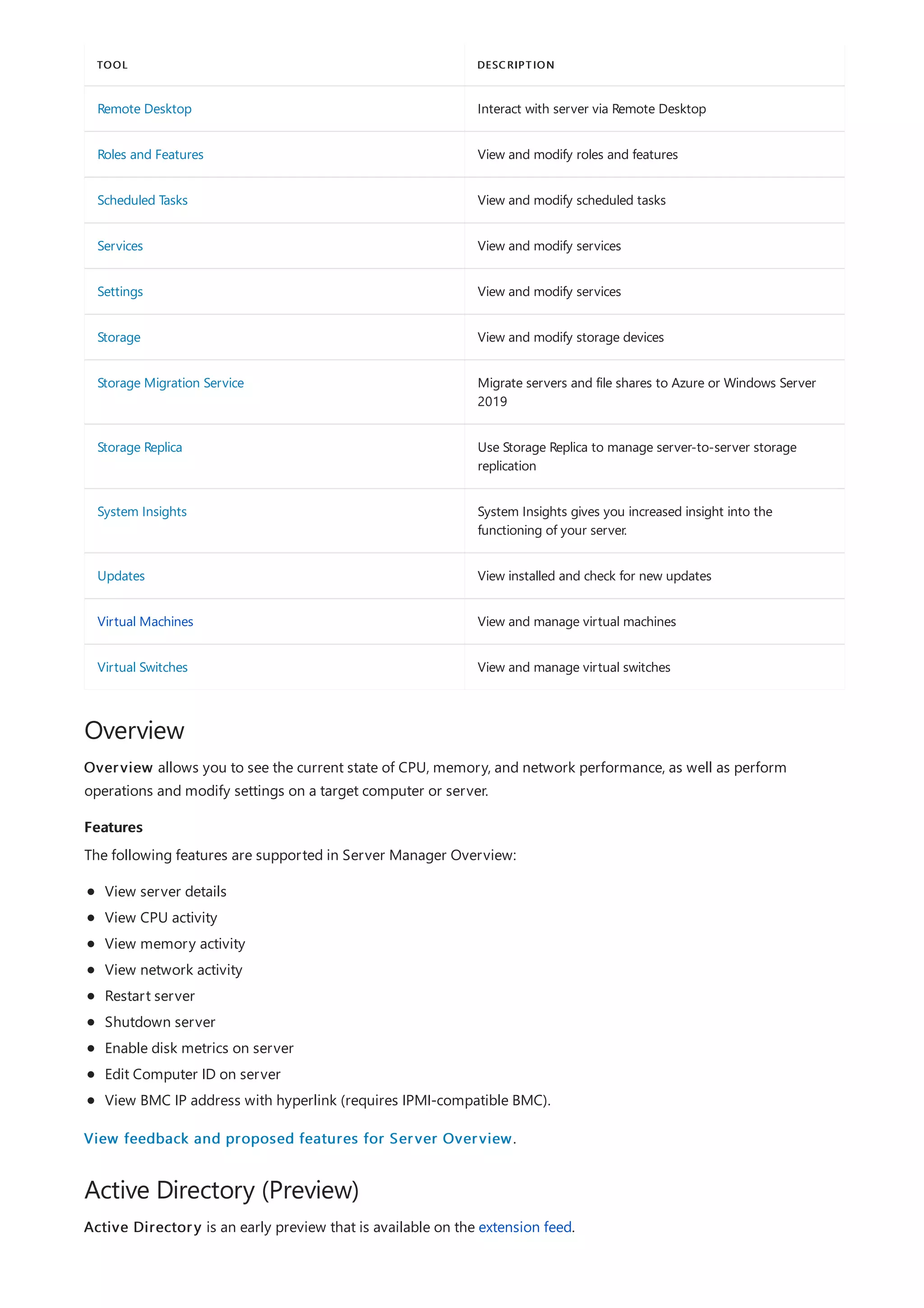

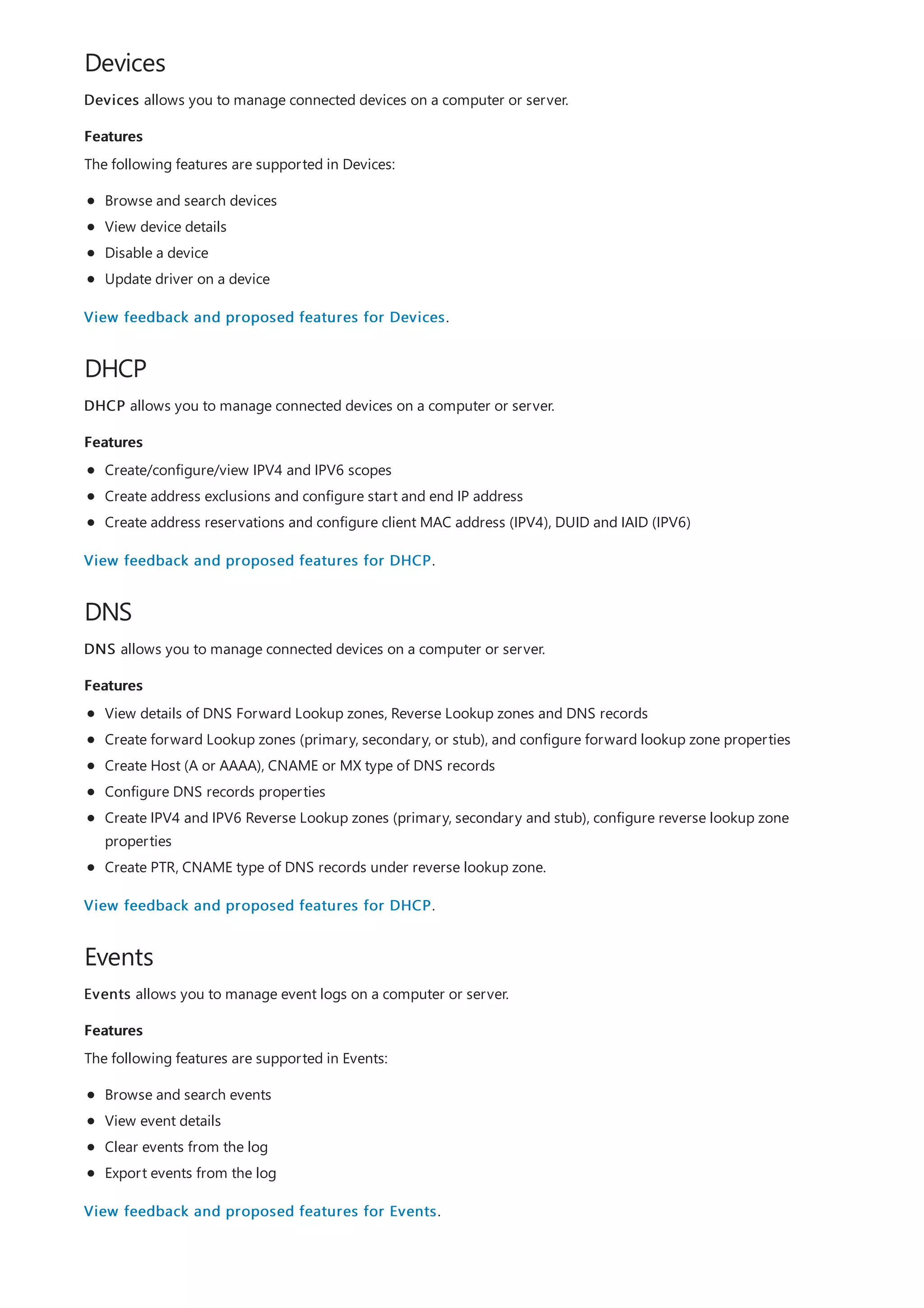
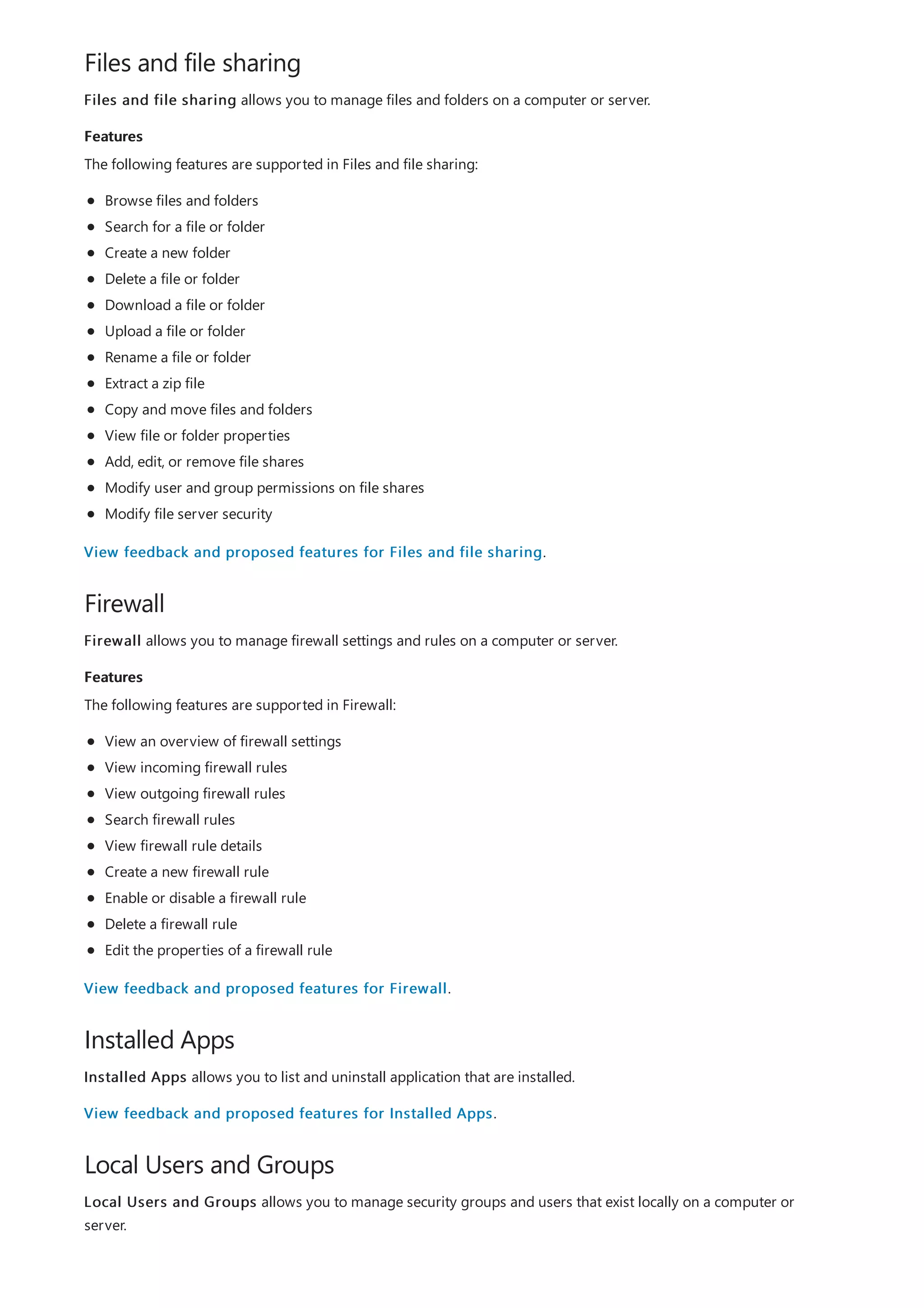

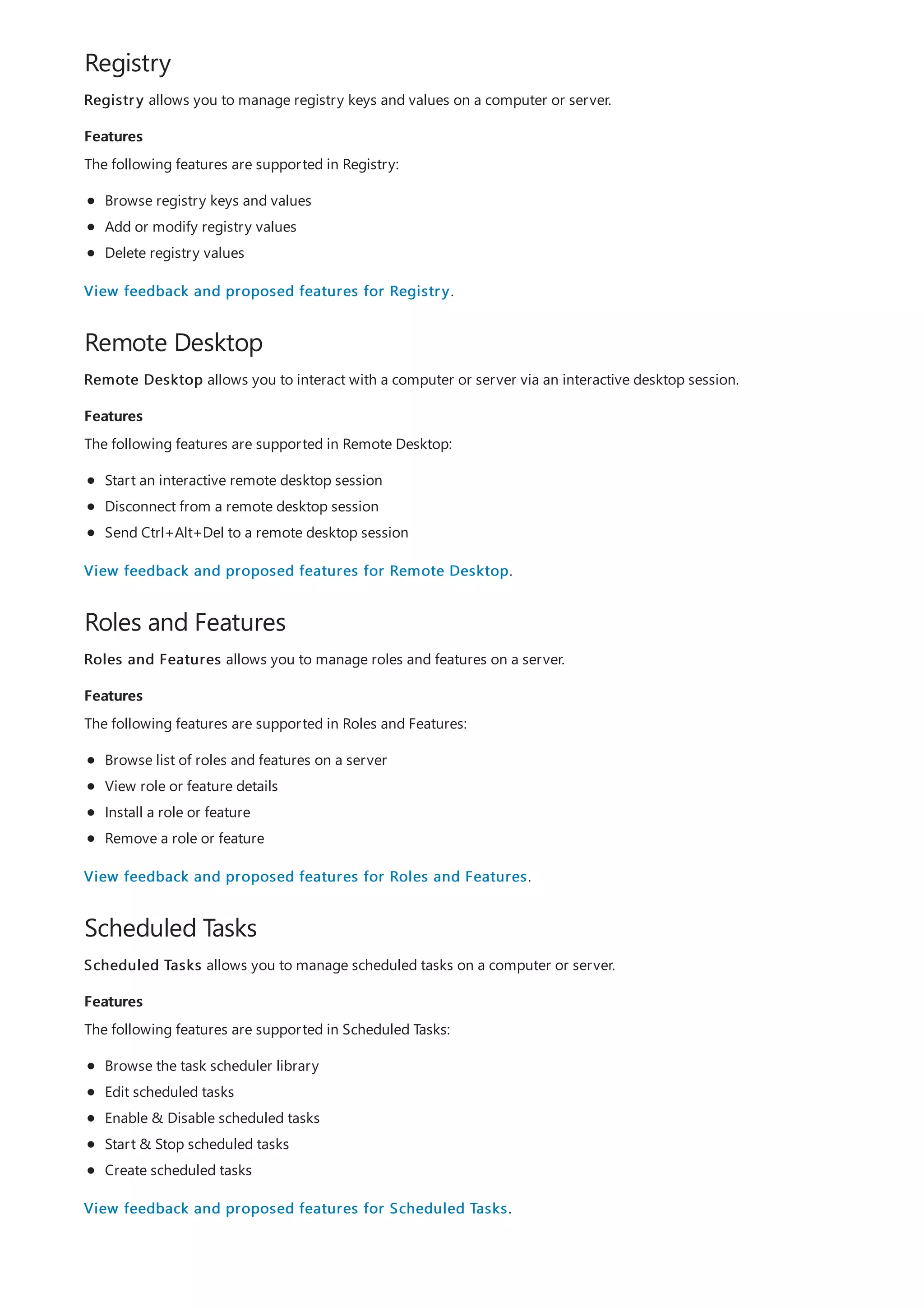



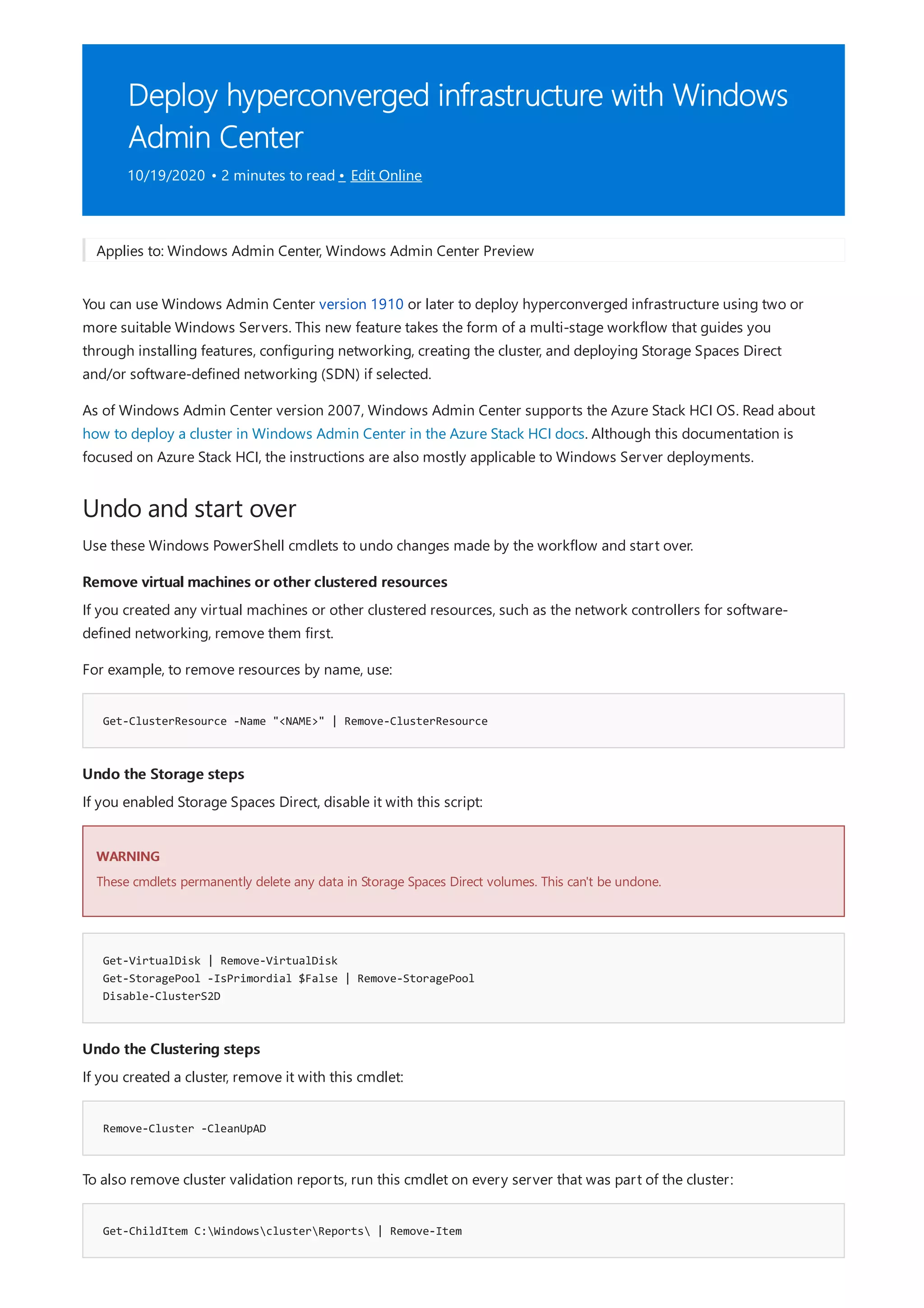



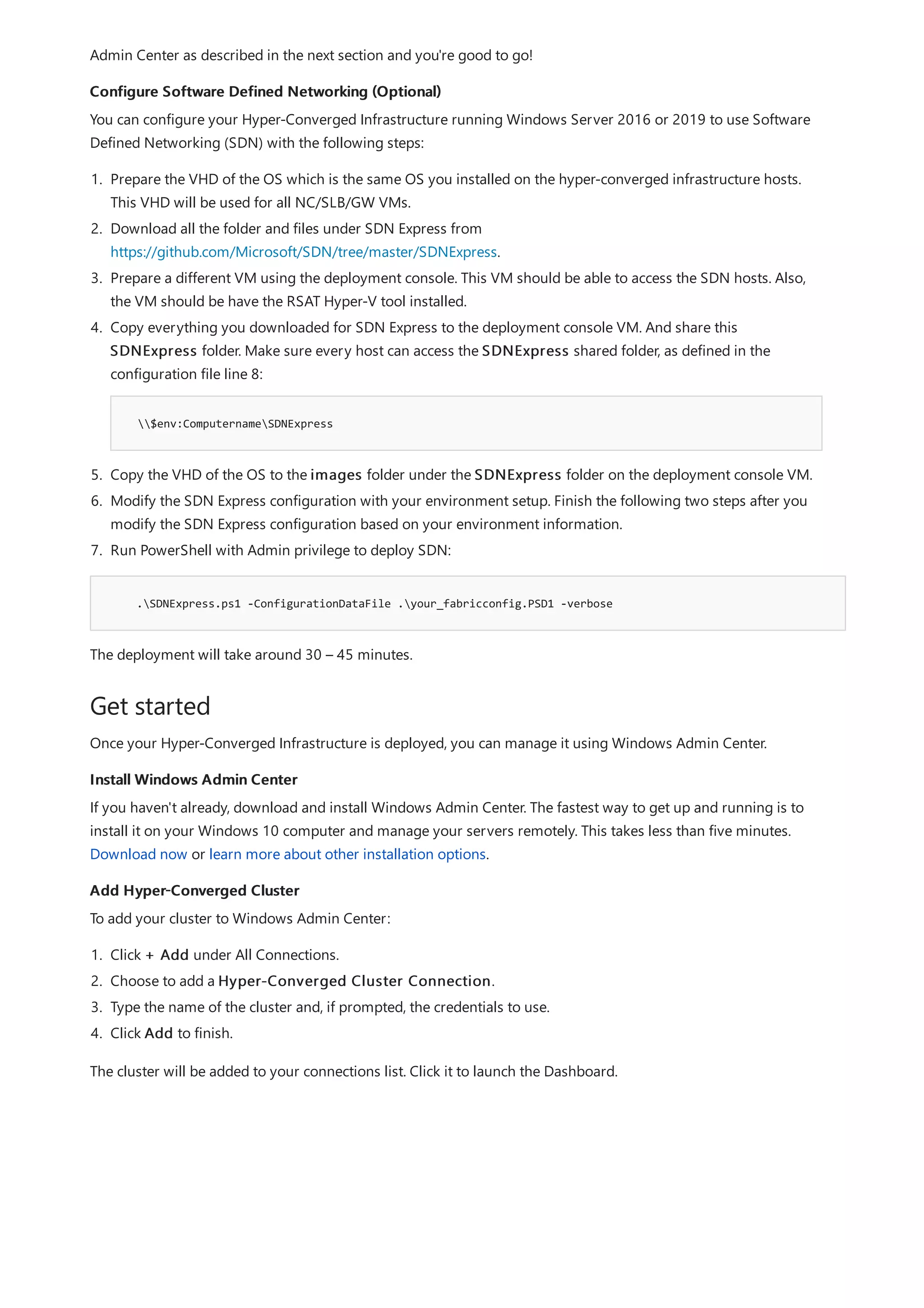
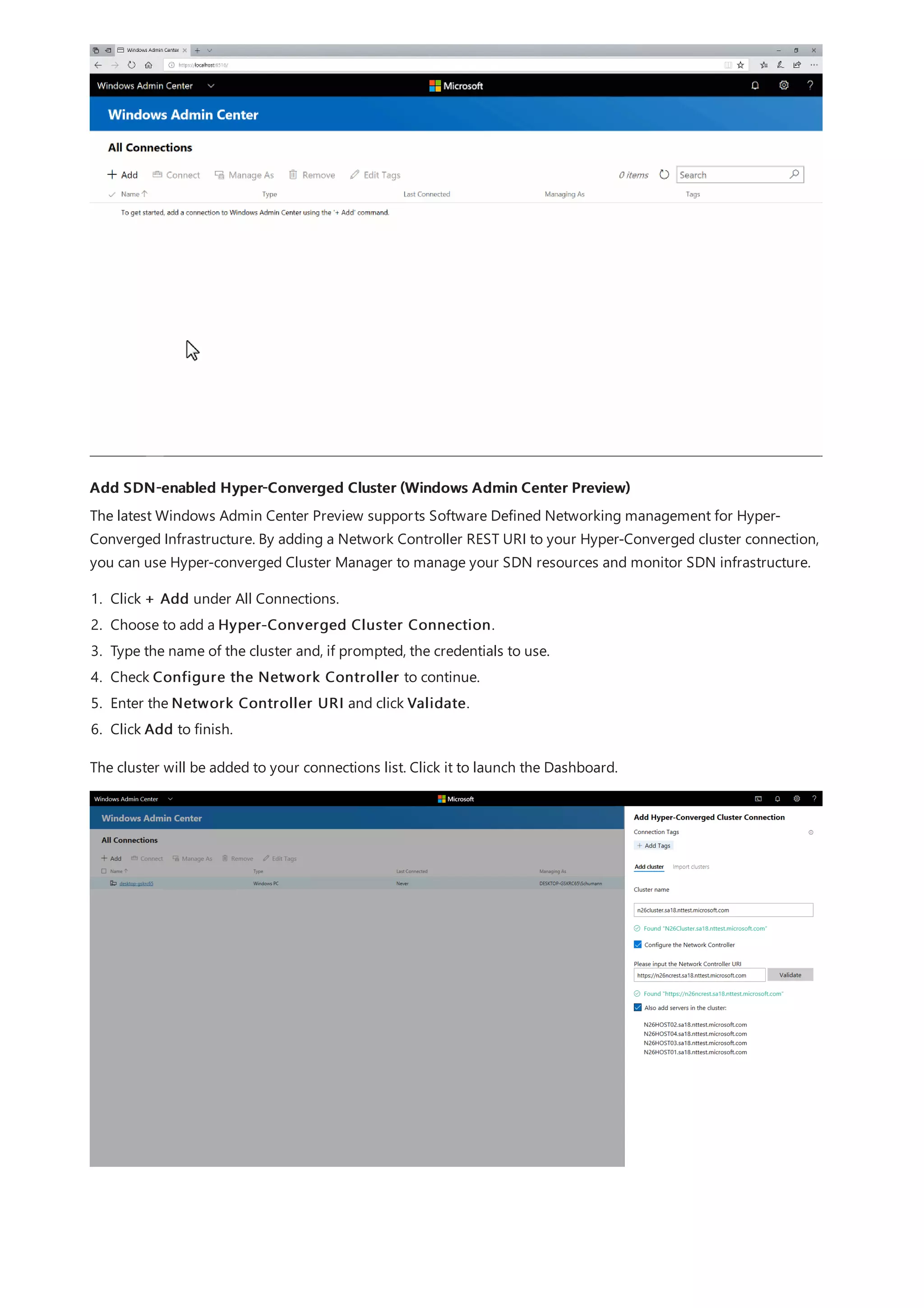

![Manage Storage Spaces Direct volumes
Create volume, three-way mirror https://www.youtube-
nocookie.com/embed/o66etKq70N8
Create volume, mirror-accelerated parity
https://www.youtube-nocookie.com/embed/R72QHudqWpE
Open volume and add files https://www.youtube-
nocookie.com/embed/j59z7ulohs4
Turn on deduplication and compression
https://www.youtube-nocookie.com/embed/PRibTacyKko
Expand volume https://www.youtube-
nocookie.com/embed/hqyBzipBoTI
Delete volume https://www.youtube-
nocookie.com/embed/DbjF8r2F6Jo
Create a new virtual machine
Pause and safely restart a server
If you're just getting started, here are some quick tutorials to help you learn how Windows Admin Center for
Hyper-Converged Infrastructure is organized and works. Please exercise good judgement and be careful with
production environments. These videos were recorded with Windows Admin Center version 1804 and an Insider
Preview build of Windows Server 2019.
(0:37) How to create a three-way mirror volume
(1:17) How to create a mirror-accelerated parity volume
(1:02) How to open a volume and add files
(0:51) How to turn on deduplication and compression
(0:47) How to expand a volume
(0:26) How to delete a volume
1. Click the Virtual Machines tool from the left side navigation pane.
2. At the top of the Virtual Machines tool, choose the Inventory tab, then click New to create a new virtual
machine.
3. Enter the virtual machine name and choose between generation 1 and 2 virtual machines.
4. Uou can then choose which host to initially create the virtual machine on or use the recommended host.
5. Choose a path for the virtual machine files. Choose a volume from the dropdown list or click Browse to
choose a folder using the folder picker. The virtual machine configuration files and virtual hard disk file will be
saved in a single folder under the Hyper-V[virtual machine name] path of the selected volume or path.
6. Choose the number of virtual processors, whether you want nested virtualization enabled, configure memory
settings, network adapters, virtual hard disks and choose whether you want to install an operating system
from an .iso image file or from the network.
7. Click Create to create the virtual machine.
8. Once the virtual machine is created and appears in the virtual machine list, you can start the virtual machine.
9. Once the virtual machine is started, you can connect to the virtual machine's console via VMConnect to install
the operating system. Select the virtual machine from the list, click More > Connect to download the .rdp file.
Open the .rdp file in the Remote Desktop Connection app. Since this is connecting to the virtual machine's
console, you will need to enter the Hyper-V host's admin credentials.
Learn more about virtual machine management with Windows Admin Center.
1. From the Dashboard, select Servers from the navigation on the left side or by clicking the VIEW SERVERS
> link on the tile in the lower right corner of the Dashboard.
2. At the top, switch from Summary to the Inventory tab.
3. Select a server by clicking its name to open the Server detail page.
4. Click Pause server for maintenance. If it's safe to proceed, this will move virtual machines to other servers
in the cluster. The server will have status Draining while this happens. If you want, you can watch the virtual
machines move on the Virtual machines > Inventory page, where their host server is shown clearly in the](https://image.slidesharecdn.com/admincenter-201105101733/75/Admincenter-82-2048.jpg)
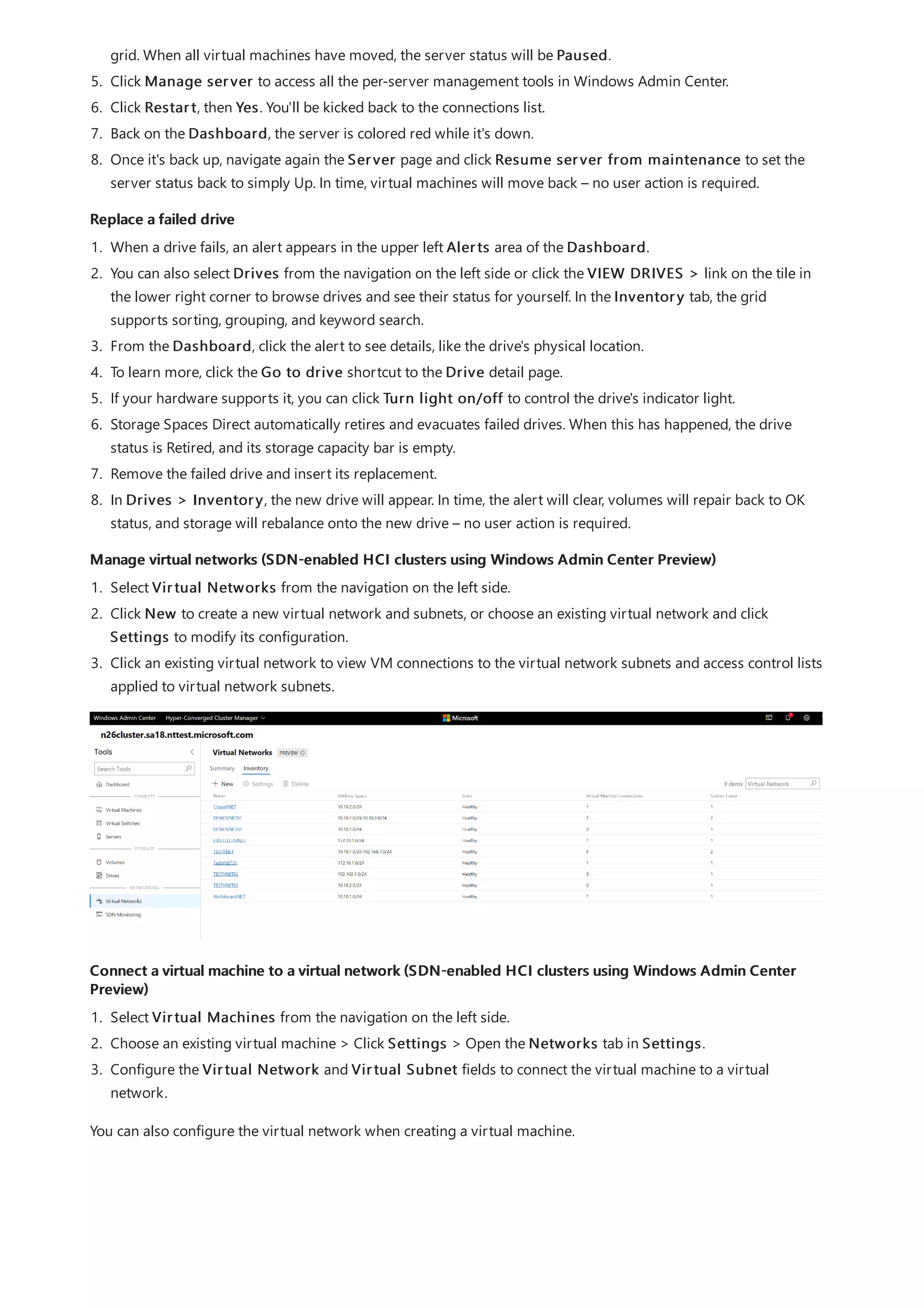







![Change virtual machine settings
TIP
1. Click the Virtual Machines tool from the left side navigation pane.
2. At the top of the Virtual Machines tool, choose the Inventory tab, then click New to create a new virtual
machine.
3. Enter the virtual machine name and choose between generation 1 and 2 virtual machines.
4. If you are creating a virtual machine on a cluster, you can choose which host to initially create the virtual
machine on. If you are running Windows Server 2016 or later, the tool will provide a host recommendation
for you.
5. Choose a path for the virtual machine files. Choose a volume from the dropdown list or click Browse to
choose a folder using the folder picker. The virtual machine configuration files and virtual hard disk file will
be saved in a single folder under the Hyper-V[virtual machine name] path of the selected volume or
path.
In the folder picker, you can browse to any available SMB share on the network by entering the path in the Folder
name field as servershare . Using a network share for VM storage will require CredSSP.
6. Choose the number of virtual processors, whether you want nested virtualization enabled, configure
memory settings, network adapters, virtual hard disks and choose whether you want to install an operating
system from an .iso image file or from the network.
7. Click Create to create the virtual machine.
8. Once the virtual machine is created and appears in the virtual machine list, you can start the virtual
machine.
9. Once the virtual machine is started, you can connect to the virtual machine's console via VMConnect to
install the operating system. Select the virtual machine from the list, click More > Connect to download
the .rdp file. Open the .rdp file in the Remote Desktop Connection app. Since this is connecting to the virtual
machine's console, you will need to enter the Hyper-V host's admin credentials.](https://image.slidesharecdn.com/admincenter-201105101733/75/Admincenter-91-2048.jpg)


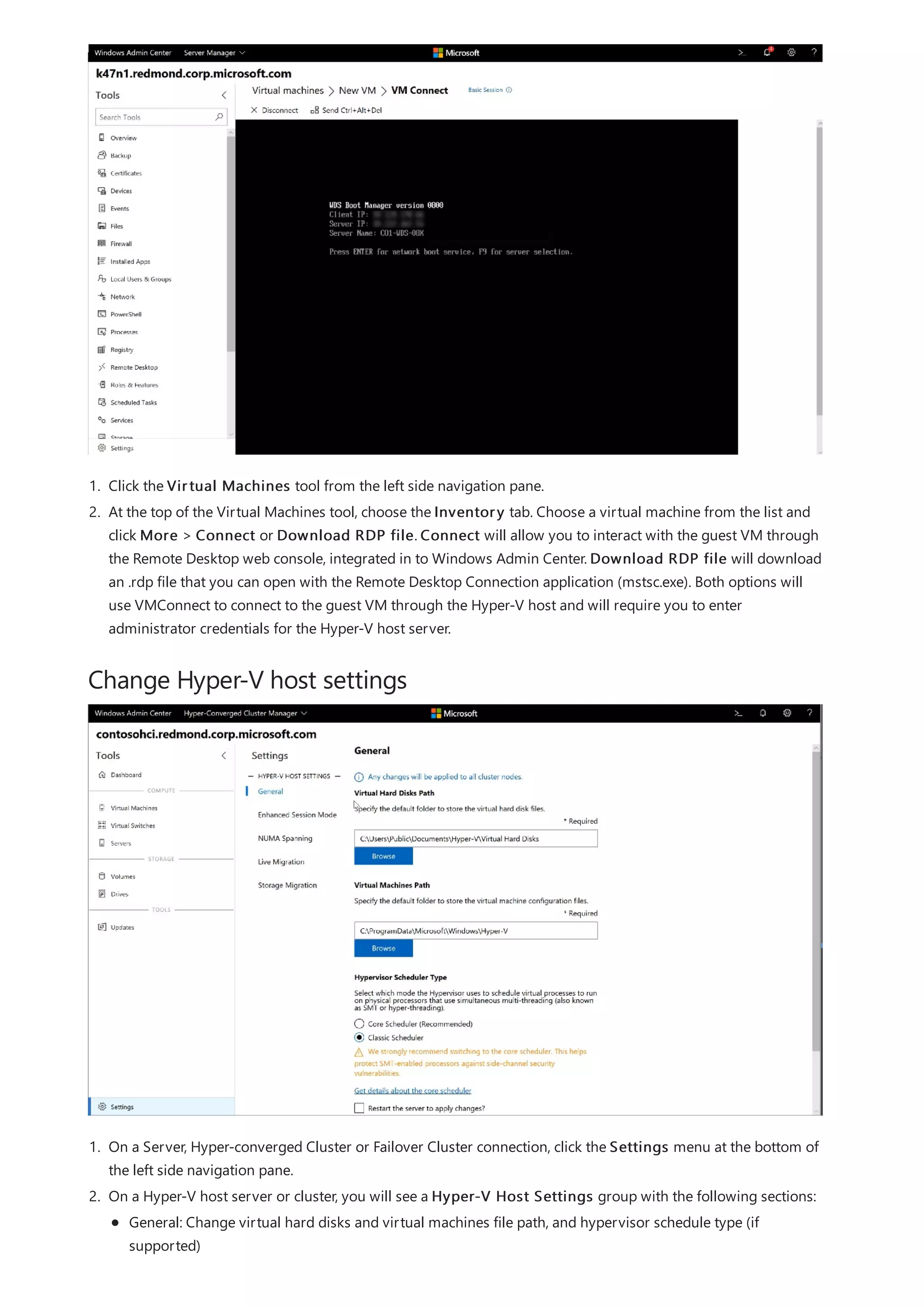




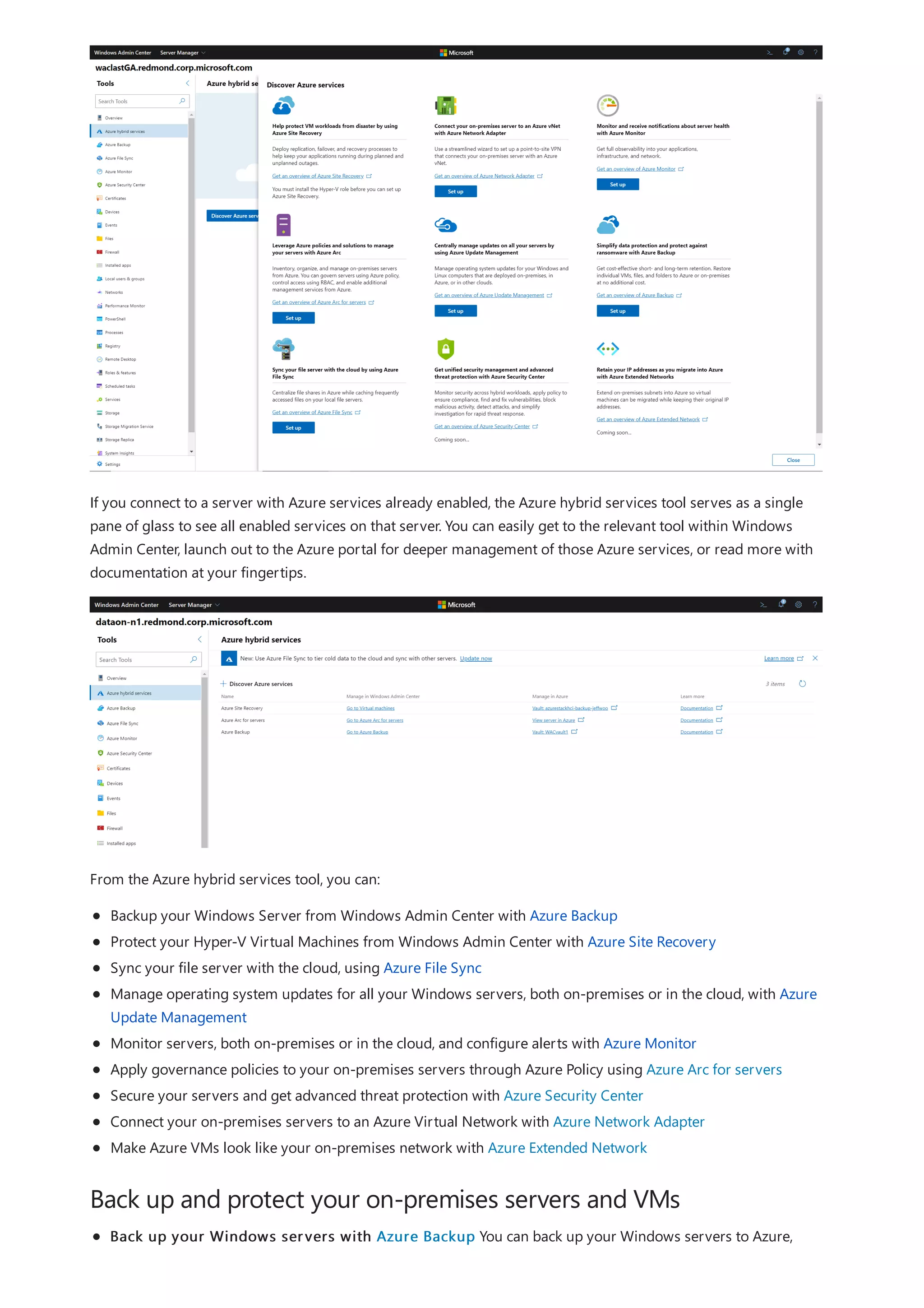









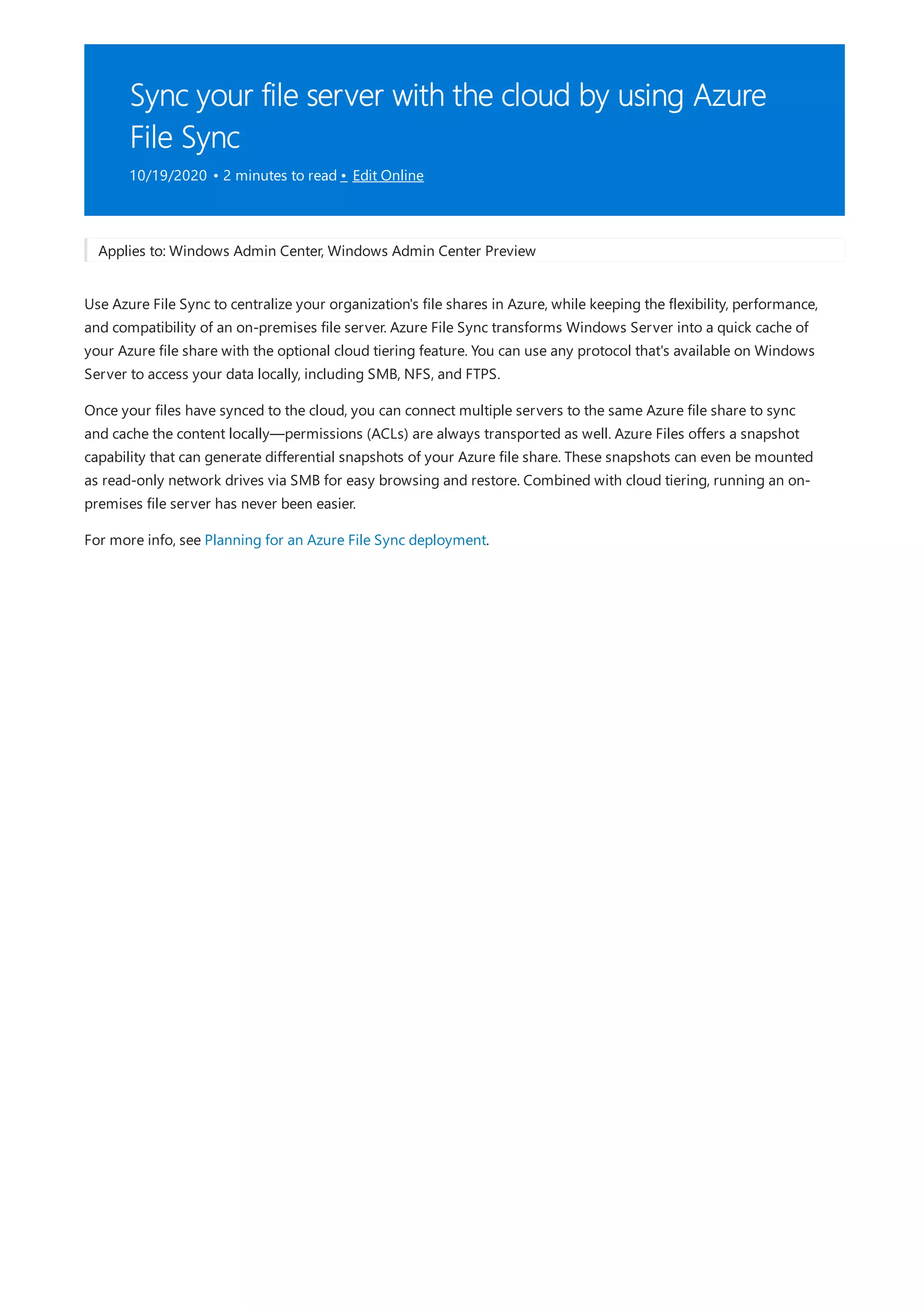
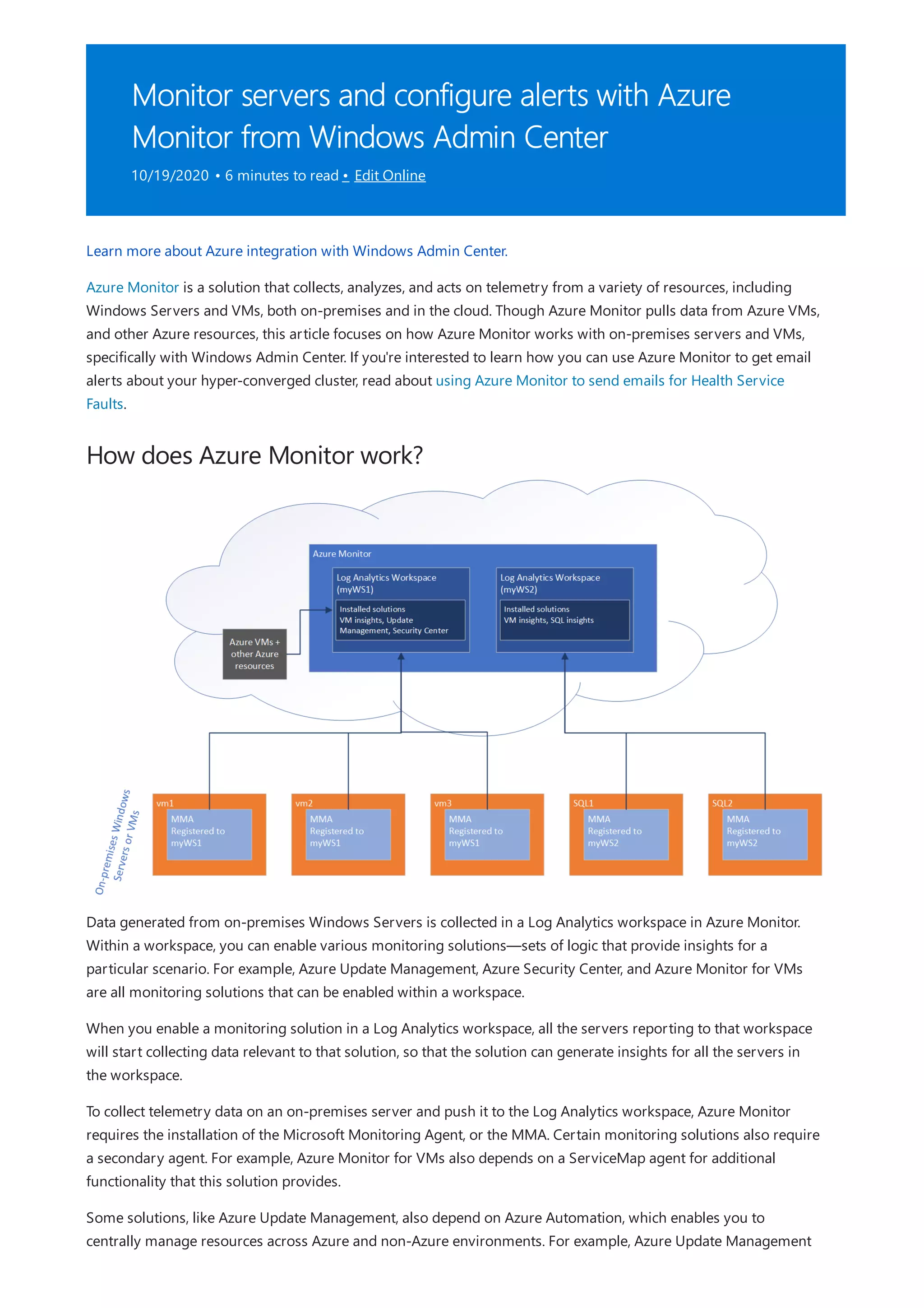
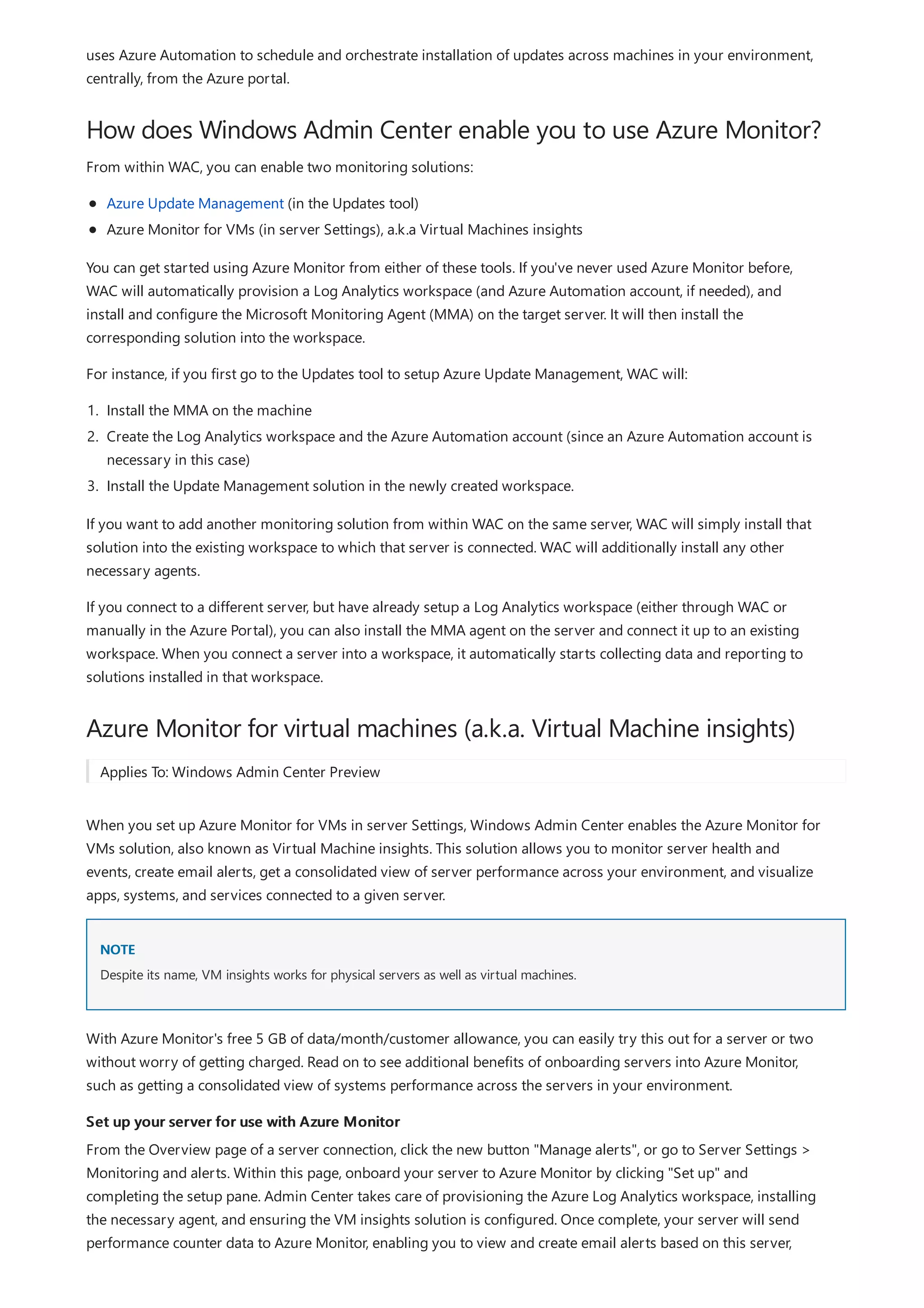

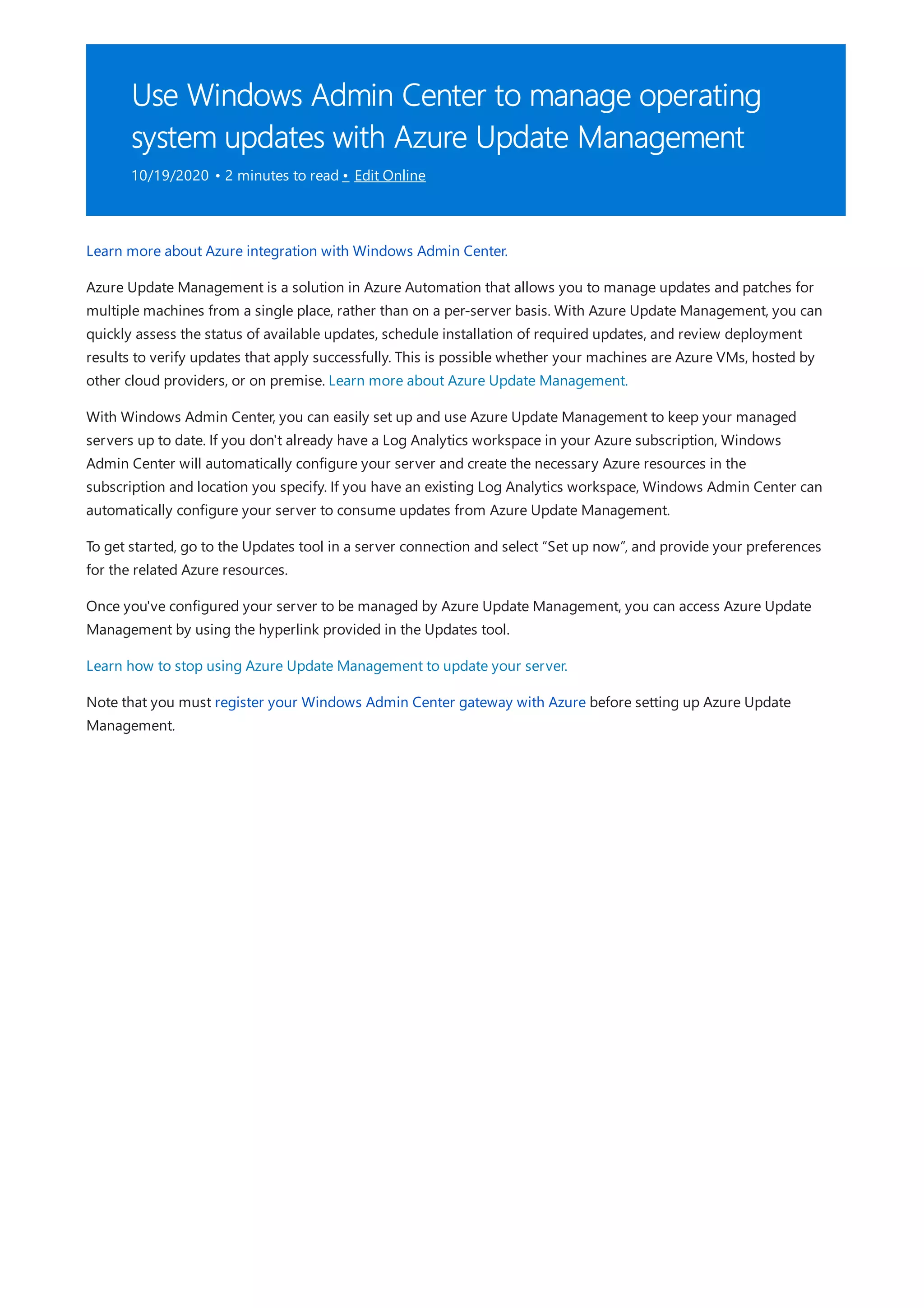
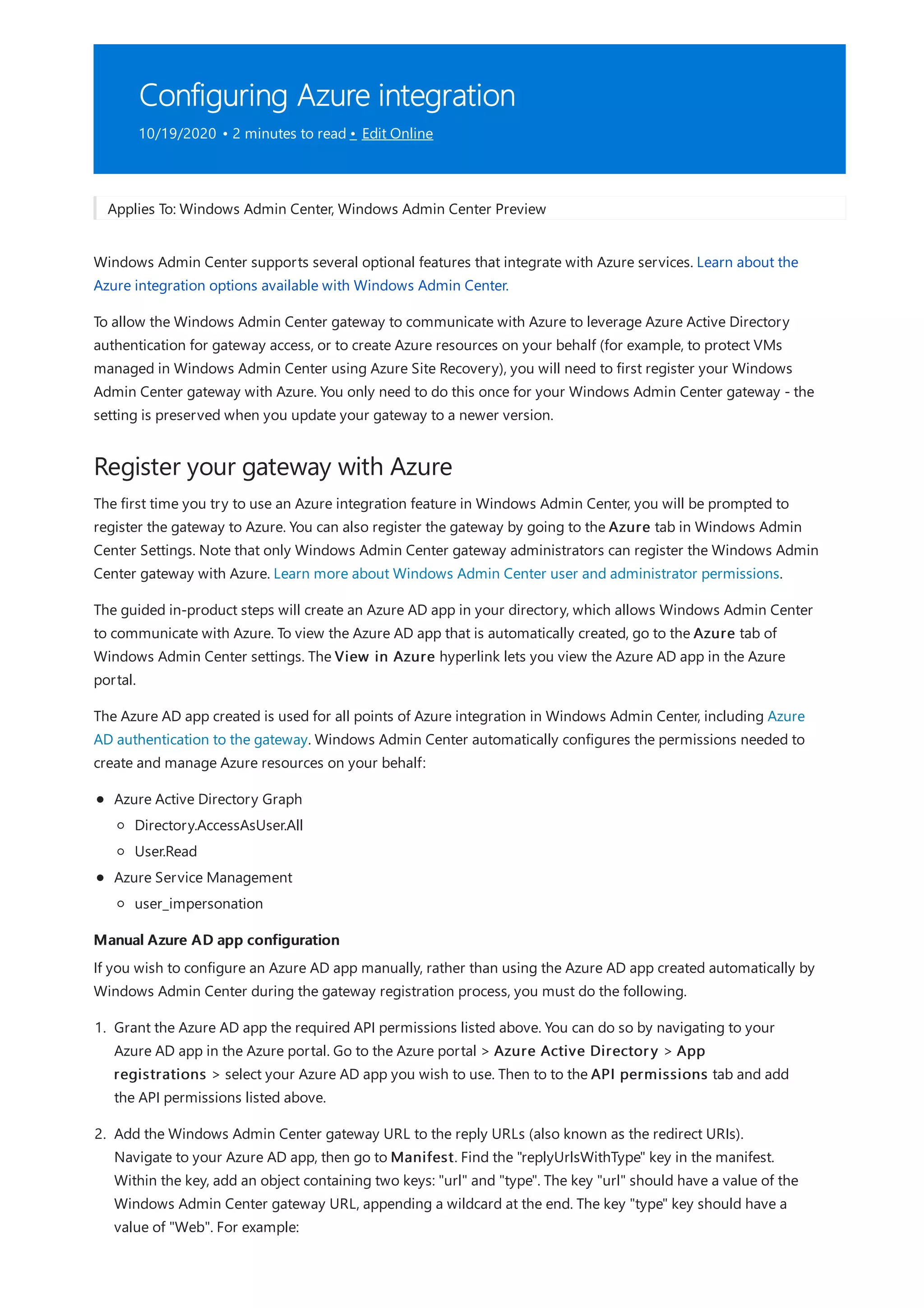
!["replyUrlsWithType": [
{
"url": "http://localhost:6516/*",
"type": "Web"
}
],](https://image.slidesharecdn.com/admincenter-201105101733/75/Admincenter-115-2048.jpg)
![Deploy Windows Admin Center in Azure
10/19/2020 • 6 minutes to read • Edit Online
Deploy using script
Prerequisites
Script parameters
You can download Deploy-WACAzVM.ps1 which you will run from Azure Cloud Shell to set up a Windows Admin
Center gateway in Azure. This script can create the entire environment, including the resource group.
Jump to manual deployment steps
Set up your account in Azure Cloud Shell. If this is your first time using Cloud Shell, you will be asked you to
associate or create an Azure storage account with Cloud Shell.
In a PowerShell Cloud Shell, navigate to your home directory: PS Azure:> cd ~
To upload the Deploy-WACAzVM.ps1 file, drag and drop it from your local machine to anywhere on the Cloud
Shell window.
If specifying your own certificate:
Upload the certificate to Azure Key Vault. First, create a key vault in Azure Portal, then upload the certificate
into the key vault. Alternatively, you can use Azure Portal to generate a certificate for you.
ResourceGroupName - [String] Specifies the name of the resource group where the VM will be created.
Name - [String] Specifies the name of the VM.
Credential - [PSCredential] Specifies the credentials for the VM.
MsiPath - [String] Specifies the local path of the Windows Admin Center MSI when deploying Windows
Admin Center on an existing VM. Defaults to the version from https://aka.ms/WACDownload if omitted.
VaultName - [String] Specifies the name of the key vault that contains the certificate.
CertName - [String] Specifies the name of the certificate to be used for MSI installation.
GenerateSslCert - [Switch] True if the MSI should generate a self signed ssl certificate.
PortNumber - [int] Specifies the ssl port number for the Windows Admin Center service. Defaults to 443
if omitted.
OpenPorts - [int[]] Specifies the open ports for the VM.
Location - [String] Specifies the location of the VM.
Size - [String] Specifies the size of the VM. Defaults to "Standard_DS1_v2" if omitted.
Image - [String] Specifies the image of the VM. Defaults to "Win2016Datacenter" if omitted.
VirtualNetworkName - [String] Specifies the name of the virtual network for the VM.
SubnetName - [String] Specifies the name of the subnet for the VM.
SecurityGroupName - [String] Specifies the name of the security group for the VM.
PublicIpAddressName - [String] Specifies the name of the public IP address for the VM.](https://image.slidesharecdn.com/admincenter-201105101733/75/Admincenter-116-2048.jpg)
![Script Examples
$ResourceGroupName = "wac-rg1"
$VirtualNetworkName = "wac-vnet"
$SecurityGroupName = "wac-nsg"
$SubnetName = "wac-subnet"
$VaultName = "wac-key-vault"
$CertName = "wac-cert"
$Location = "westus"
$PublicIpAddressName = "wac-public-ip"
$Size = "Standard_D4s_v3"
$Image = "Win2016Datacenter"
$Credential = Get-Credential
Example 1: Use the script to deploy WAC gateway on a new VM in a new virtual network and resource group. Use the MSI from
aka.ms/WACDownload and a self-signed cert from the MSI.
$scriptParams = @{
ResourceGroupName = $ResourceGroupName
Name = "wac-vm1"
Credential = $Credential
VirtualNetworkName = $VirtualNetworkName
SubnetName = $SubnetName
GenerateSslCert = $true
}
./Deploy-WACAzVM.ps1 @scriptParams
Example 2: Same as #1, but using a certificate from Azure Key Vault.
$scriptParams = @{
ResourceGroupName = $ResourceGroupName
Name = "wac-vm2"
Credential = $Credential
VirtualNetworkName = $VirtualNetworkName
SubnetName = $SubnetName
VaultName = $VaultName
CertName = $CertName
}
./Deploy-WACAzVM.ps1 @scriptParams
Example 3: Using a local MSI on an existing VM to deploy WAC.
$MsiPath = "C:Users<username>DownloadsWindowsAdminCenter<version>.msi"
$scriptParams = @{
ResourceGroupName = $ResourceGroupName
Name = "wac-vm3"
Credential = $Credential
MsiPath = $MsiPath
InstallWACOnly = $true
GenerateSslCert = $true
}
./Deploy-WACAzVM.ps1 @scriptParams
InstallWACOnly - [Switch] Set to True if WAC should be installed on a pre-existing Azure VM.
There are 2 different options for the MSI to deploy and the certificate used for MSI installation. The MSI can either
be downloaded from aka.ms/WACDownload or, if deploying to an existing VM, the filepath of an MSI locally on
the VM can be given. The certificate can be found in either Azure Key Vault or a self-signed certificate will be
generated by the MSI.
First, define common variables needed for the parameters of the script.](https://image.slidesharecdn.com/admincenter-201105101733/75/Admincenter-117-2048.jpg)
![Requirements for VM running the Windows Admin Center gateway
$nsg = Get-AzNetworkSecurityGroup -Name $SecurityGroupName -ResourceGroupName $ResourceGroupName
$newNSG = Add-AzNetworkSecurityRuleConfig -NetworkSecurityGroup $nsg -Name ssl-rule -Description "Allow SSL"
-Access Allow -Protocol Tcp -Direction Inbound -Priority 100 -SourceAddressPrefix Internet -SourcePortRange *
-DestinationAddressPrefix * -DestinationPortRange 443
Set-AzNetworkSecurityGroup -NetworkSecurityGroup $newNSG
Requirements for managed Azure VM's
Enable-AzVMPSRemoting -ResourceGroupName $ResourceGroupName -Name $Name
Invoke-AzVMCommand -ResourceGroupName $ResourceGroupName -Name $Name -ScriptBlock {Set-NetFirewallRule -Name
WINRM-HTTP-In-TCP-PUBLIC -RemoteAddress Any} -Credential $Credential
Invoke-AzVMCommand -ResourceGroupName $ResourceGroupName -Name $Name -ScriptBlock {winrm create
winrm/config/Listener?Address=*+Transport=HTTP} -Credential $Credential
Deploy manually on an existing Azure virtual machine
NOTE
Configure the gateway VM to enable HTTPS port access:
Port 443 (HTTPS) must be open. Using the same variables defined for script, you can use the code below in Azure
Cloud Shell to update the network security group:
Port 5985 (WinRM over HTTP) must be open and have an active listener. You can use the code below in Azure
Cloud Shell to update the managed nodes. $ResourceGroupName and $Name use the same variables as the
deployment script, but you will need to use the $Credential specific to the VM you are managing.
Before installing Windows Admin Center on your desired gateway VM, install a SSL certificate to use for HTTPS
communication, or you can choose to use a self-signed certificate generated by Windows Admin Center. However,
you will get a warning when trying to connect from a browser if you choose the latter option. You can bypass this
warning in Edge by clicking Details > Go on to the webpage or, in Chrome, by selecting Advanced >
Proceed to [webpage]. We recommend you only use self-signed certificates for test environments.
These instructions are for installing on Windows Server with Desktop Experience, not on a Server Core installation.
1. Download Windows Admin Center to your local computer.
2. Establish a remote desktop connection to the VM, then copy the MSI from your local machine and paste
into the VM.
3. Double-click the MSI to begin installation, and follow the instructions in the wizard. Be aware of the
following:
By default, the installer uses the recommended port 443 (HTTPS). If you want to select a different
port, note that you need to open that port in your firewall as well.
If you have already installed an SSL certificate on the VM, ensure you select that option and enter
the thumbprint.
4. Start the Windows Admin Center service (run C:/Program Files/Windows Admin Center/sme.exe)
Learn more about deploying Windows Admin Center.
1. Navigate to your VM in the Azure portal and select Networking.
2. Select Add inbound port rule and select HTTPS under Service.](https://image.slidesharecdn.com/admincenter-201105101733/75/Admincenter-118-2048.jpg)


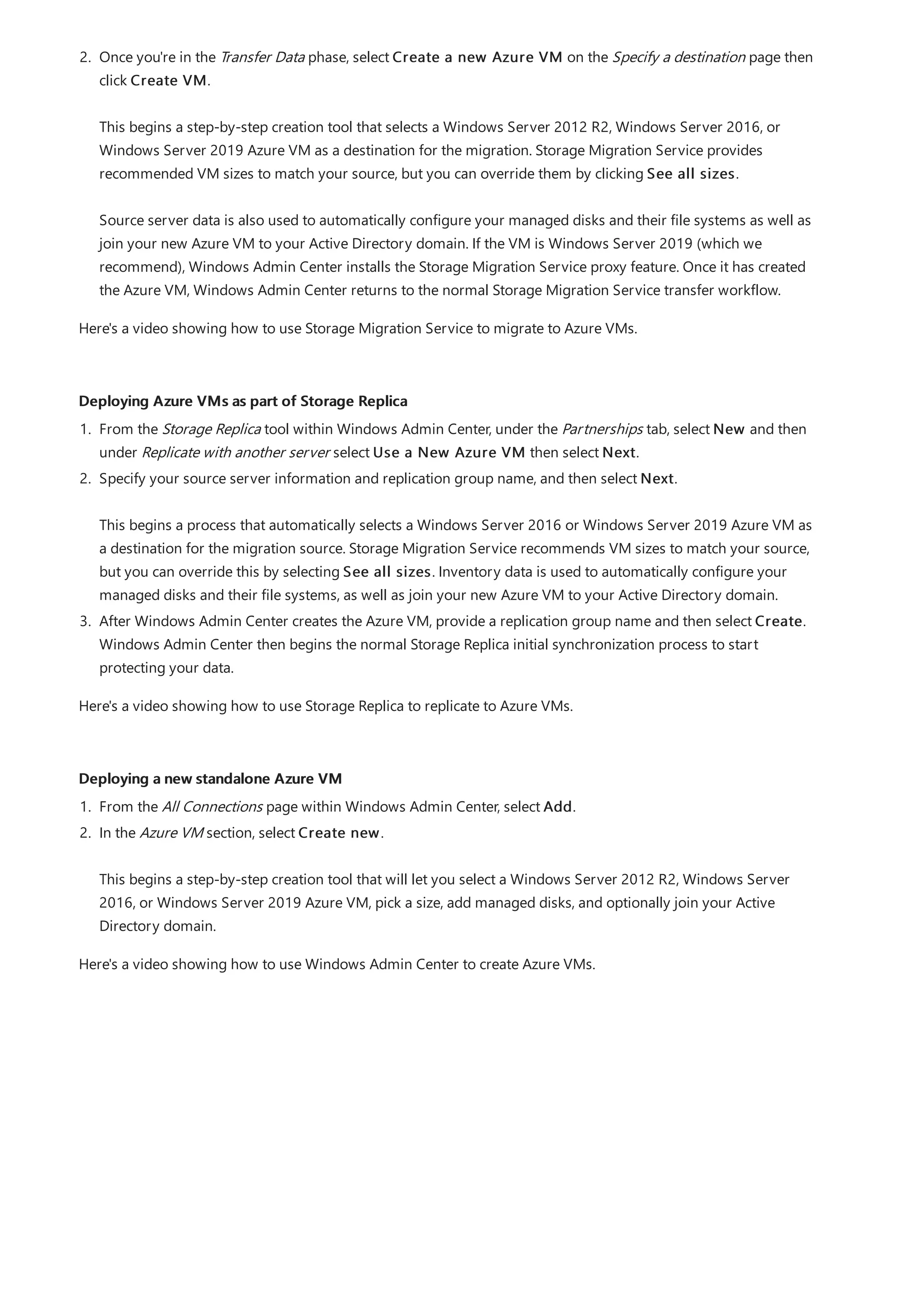





![Troubleshooting Windows Admin Center
10/19/2020 • 8 minutes to read • Edit Online
IMPORTANT
Installer fails with message: The Module
'Microsoft.PowerShell.LocalAccounts' could not be loaded.
[Environment]::SetEnvironmentVariable("PSModulePath","%SystemRoot%system32WindowsPowerShellv1.0Modules;" +
([Environment]::GetEnvironmentVariable("PSModulePath","User")),"User")
I get a This site/page can't be reached error in my web browser
If you've installed Windows Admin Center as an App on Windows 10
NOTE
If you've installed Windows Admin Center as a Gateway on Windows Server
Applies to: Windows Admin Center, Windows Admin Center Preview
This guide will help you diagnose and resolve issues that are preventing you from using Windows Admin Center. If you are
having an issue with a specific tool, please check to see if you are experiencing a known issue.
This can happen if your default PowerShell module path has been modified or removed. To resolve the issue, make
sure that %SystemRoot%system32WindowsPowerShellv1.0Modules is the first item in your PSModulePath
environment variable. You can achieve this with the following line of PowerShell:
Check to make sure Windows Admin Center is running. Look for the Windows Admin Center icon in
the System tray or Windows Admin Center Desktop / SmeDesktop.exe in Task Manager. If not, launch
Windows Admin Center from the Start Menu.
After rebooting, you must launch Windows Admin Center from the Start Menu.
Check the Windows version
Make sure you are using either Microsoft Edge or Google Chrome as your web browser.
Did you select the correct certificate on first launch?
Try opening your browser in a private session - if that works, you'll need to clear your cache.
Did you recently upgrade Windows 10 to a new build or version?
This may have cleared your trusted hosts settings. Follow these instructions to update your trusted hosts
settings.
Check the Windows version of the client and server.
Make sure you are using either Microsoft Edge or Google Chrome as your web browser.](https://image.slidesharecdn.com/admincenter-201105101733/75/Admincenter-127-2048.jpg)
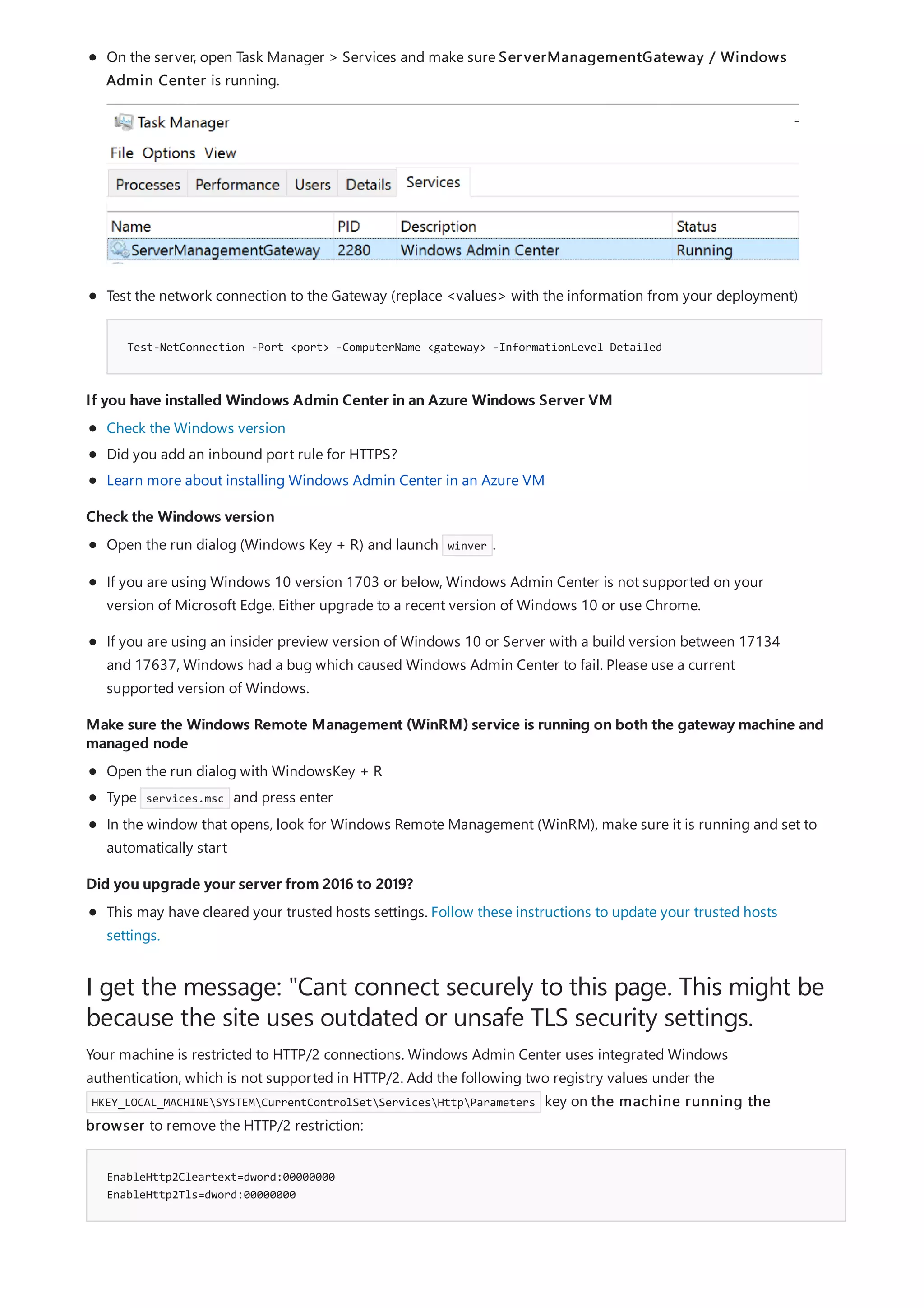

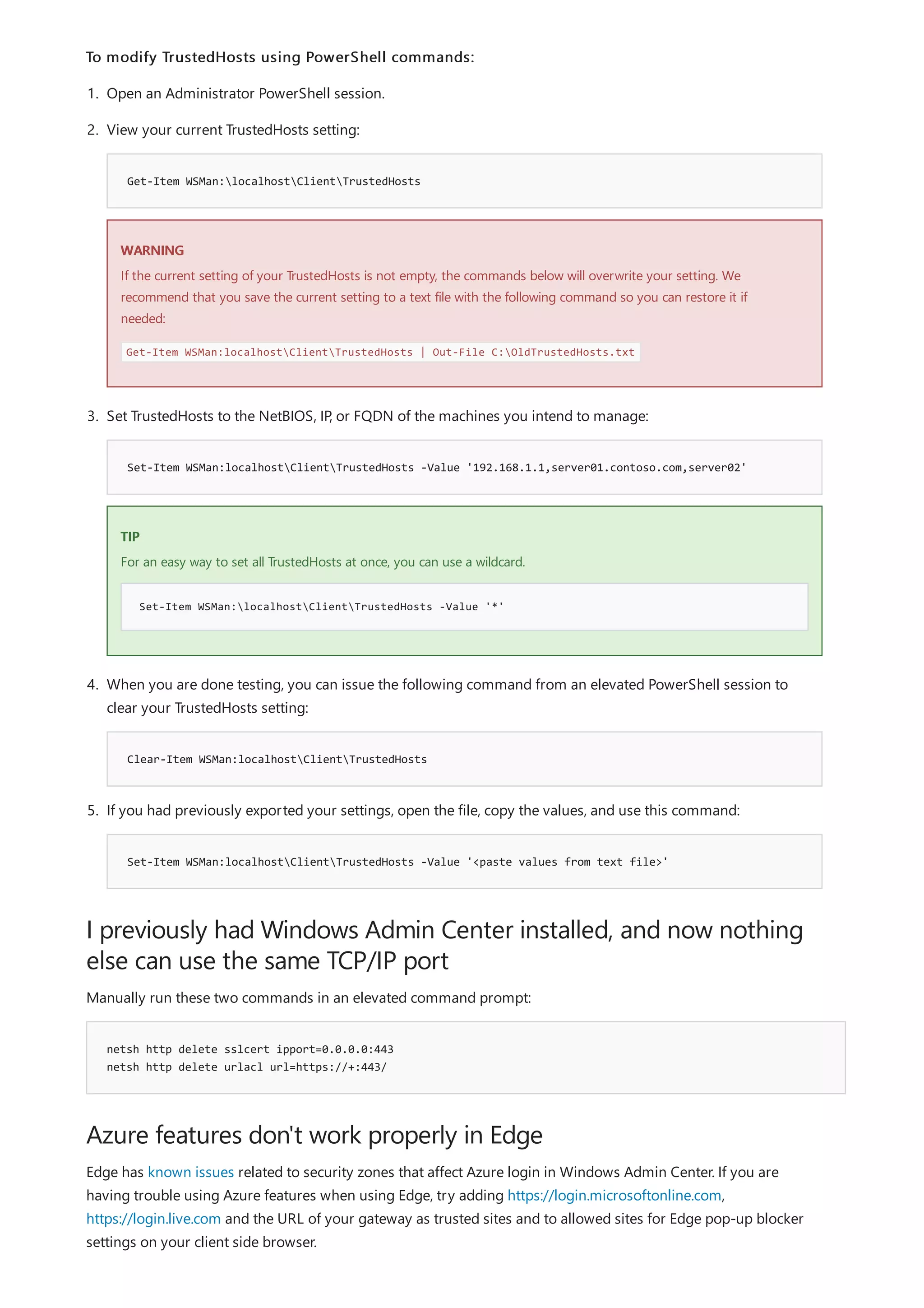


![Windows Admin Center Known Issues
10/19/2020 • 15 minutes to read • Edit Online
Installer
General
Extension Manager
Browser Specific Issues
Applies to: Windows Admin Center, Windows Admin Center Preview
If you encounter an issue not described on this page, please let us know.
When installing Windows Admin Center using your own certificate, be mindful that if you copy the
thumbprint from the certificate manager MMC tool, it will contain an invalid character at the beginning. As
a workaround, type the first character of the thumbprint, and copy/paste the rest.
Using port below 1024 is not supported. In service mode, you may optionally configure port 80 to redirect
to your specified port.
WARNING
In the 1910.2 release of Windows Admin Center, you may not be able to connect to Hyper-V servers on
specific hardware. If you are blocked on this issue, please download our previous build.
If you have Windows Admin Center installed as a gateway on Windows Server 2016 under heavy use,
the service may crash with an error in the event log that contains Faulting application name: sme.exe and
Faulting module name: WsmSvc.dll . This is due to a bug that has been fixed in Windows Server 2019. The
patch for Windows Server 2016 was included the February 2019 cumulative update, KB4480977.
If you have Windows Admin Center installed as a gateway and your connection list appears to be corrupted,
perform the following steps:
This will delete the connection list and settings for all Windows Admin Center users on the gateway.
1. Uninstall Windows Admin Center
2. Delete the Server Management Experience folder under
C:WindowsServiceProfilesNetworkServiceAppDataRoamingMicrosoft
3. Reinstall Windows Admin Center
If you leave the tool open and idle for a long period of time, you may get several Error: The runspace
state is not valid for this operation errors. If this occurs, refresh your browser. If you encounter this,
send us feedback.
There may be minor variance between version numbers of OSS running in Windows Admin Center
modules, and what is listed within the 3rd Party Software Notice.
When you update Windows Admin Center, you must reinstall your extensions.
If you add an extension feed that is inaccessible, there is no warning. [14412861]](https://image.slidesharecdn.com/admincenter-201105101733/75/Admincenter-133-2048.jpg)
![Microsoft Edge
Google Chrome
Mozilla Firefox
WebSocket compatibility when using a proxy service
Support for Windows Server versions before 2016 (2012 R2, 2012, 2008
R2)
NOTE
Role Based Access Control (RBAC)
Server Manager solution
Certificates
If you have Windows Admin Center deployed as a service and you are using Microsoft Edge as your browser,
connecting your gateway to Azure may fail after spawning a new browser window. Try to work around this
issue by adding https://login.microsoftonline.com, https://login.live.com, and the URL of your gateway as
trusted sites and allowed sites for pop-up blocker settings on your client side browser. For more guidance on
fixing this in the troubleshooting guide. [17990376]
Prior to version 70 (released late October, 2018) Chrome had a bug regarding the WebSockets protocol and
NTLM authentication. This effects the following tools: Events, PowerShell, Remote Desktop.
Chrome may pop-up multiple credential prompts, especially during the add connection experience in a
workgroup (non-domain) environment.
If you have Windows Admin Center deployed as a service, popups from the gateway URL need to be
enabled for any Azure integration functionality to work.
Windows Admin Center is not tested with Mozilla Firefox, but most functionality should work.
Windows 10 Installation: Mozilla Firefox has it's own certificate store, so you must import the
Windows Admin Center Client certificate into Firefox to use Windows Admin Center on Windows 10.
Remote Desktop, PowerShell, and Events modules in Windows Admin Center utilize the WebSocket protocol,
which is often not supported when using a proxy service.
Windows Admin Center requires PowerShell features that are not included in Windows Server 2012 R2, 2012, or 2008 R2. If
you will manage Windows Server these with Windows Admin Center, you will need to install WMF version 5.1 or higher on
those servers.
Type $PSVersiontable in PowerShell to verify that WMF is installed, and that the version is 5.1 or higher.
If it is not installed, you can download and install WMF 5.1.
RBAC deployment will not succeed on machines that are configured to use Windows Defender Application
Control (WDAC, formerly known as Code Integrity.) [16568455]
To use RBAC in a cluster, you must deploy the configuration to each member node individually.
When RBAC is deployed, you may get unauthorized errors that are incorrectly attributed to the RBAC
configuration. [16369238]
Cannot import .PFX Encrypted Certificate in to current user store. [11818622]](https://image.slidesharecdn.com/admincenter-201105101733/75/Admincenter-134-2048.jpg)
![Events
Files
PowerShell
Registry Editor
Remote Desktop
Roles and Features
Events is effected by websocket compatibility when using a proxy service.
You may get an error that references “packet size” when exporting large log files.
To resolve this, use the following command in an elevated command prompt on the gateway machine:
winrm set winrm/config @{MaxEnvelopeSizekb="8192"}
Uploading or downloading large files not yet supported. (~100mb limit) [12524234]
PowerShell is effected by websocket compatibility when using a proxy service
Pasting with a single right-click as in the desktop PowerShell console does not work. Instead you will get the
browser's context menu, where you can select paste. Ctrl-V works as well.
Ctrl-C to copy does not work, it will always send the Ctrl-C break command to the console. Copy from the
right-click context menu works.
When you make the Windows Admin Center window smaller, the terminal content will reflow, but when you
make it larger again, the content may not return to it's previous state. If things get jumbled, you can try
Clear-Host, or disconnect and reconnect using the button above the terminal.
Search functionality not implemented. [13820009]
When Windows Admin Center is deployed as a service, the Remote Desktop tool may fail to load after
updating the Windows Admin Center service to a new version. To work around this issue, clear your
browser cache. [23824194]
The Remote Desktop tool may fail to connect when managing Windows Server 2012. [20258278]
When using the Remote Desktop to connect to a machine that is not Domain joined, you must enter your
account in the MACHINENAMEUSERNAME format.
Some configurations can block Windows Admin Center's remote desktop client with group policy. If you
encounter this, enable Allow users to connect remotely by using Remote Desktop Services under
Computer Configuration/Policies/Administrative Templates/Windows Components/Remote Desktop
Services/Remote Desktop Session Host/Connections
Remote Desktop is effected by websocket compatibility.
The Remote Desktop tool does not currently support any text, image, or file copy/paste between the local
desktop and the remote session.
To do any copy/paste within the remote session, you can copy as normal (right click + copy or Ctrl+C), but
paste requires right click + paste (Ctrl+V does NOT work)
You cannot send the following key commands to the remote session
Alt+Tab
Function keys
Windows Key
PrtScn
When selecting roles or features with unavailable sources for install, they are skipped. [12946914]](https://image.slidesharecdn.com/admincenter-201105101733/75/Admincenter-135-2048.jpg)
![Storage
Updates
Virtual Machines
Virtual Switches
Computer Management Solution
If you choose not to automatically reboot after role installation, we won't ask again. [13098852]
If you do choose to automatically reboot, the reboot will occur before the status gets updated to 100%.
[13098852]
Down-level: DVD/CD/Floppy drives do not appear as volumes on down-level.
Down-level: Some properties in Volumes and Disks are not available down-level so they appear unknown
or blank in details panel.
Down-level: When creating a new volume, ReFS only supports an allocation unit size of 64K on Windows
2012 and 2012 R2 machines. If a ReFS volume is created with a smaller allocation unit size on down-level
targets, file system formatting will fail. The new volume will not be usable. The resolution is to delete the
volume and use 64K allocation unit size.
After installing updates, install status may be cached and require a browser refresh.
You may encounter the error: "Keyset does not exist" when attempting to set up Azure Update
management. In this case, please try the following remediation steps on the managed node -
1. Stop ‘Cryptographic Services' service.
2. Change folder options to show hidden files (if required).
3. Got to “%allusersprofile%MicrosoftCryptoRSAS-1-5-18” folder and delete all its contents.
4. Restart ‘Cryptographic Services' service.
5. Repeat setting up Update Management with Windows Admin Center
When managing the virtual machines on a Windows Server 2012 host, the in-browser VM connect tool will
fail to connect to the VM. Downloading the .rdp file to connect to the VM should still work. [20258278]
Azure Site Recovery – If ASR is setup on the host outside of WAC, you will be unable to protect a VM from
within WAC [18972276]
Advanced features available in Hyper-V Manager such as Virtual SAN Manager, Move VM, Export VM, VM
Replication are currently not supported.
Switch Embedded Teaming (SET): When adding NICs to a team, they must be on the same subnet.
The Computer Management solution contains a subset of the tools from the Server Manager solution, so the same
known issues apply, as well as the following Computer Management solution specific issues:
If you use a Microsoft Account (MSA) or if you use Azure Active Directory (AAD) to log on to you Windows
10 machine, you must use "manage-as" to provide credentials for a local administrator account [16568455]
When you try to manage the localhost, you will be prompted to elevate the gateway process. If you click no
in the User Account Control popup that follows, you must cancel the connection attempt and start over.
Windows 10 does not have WinRM/PowerShell remoting on by default.
To enable management of the Windows 10 Client, you must issue the command Enable-PSRemoting
from an elevated PowerShell prompt.
You may also need to update your firewall to allow connections from outside the local subnet with](https://image.slidesharecdn.com/admincenter-201105101733/75/Admincenter-136-2048.jpg)


![Set-VMProcessor -VMName <VMName> -ExposeVirtualizationExtensions $true
NOTE
Install-WindowsFeature –VHD <Path to the VHD> -Name Hyper-V, RSAT-Hyper-V-Tools, Hyper-V-PowerShell
Support for RDMA
Failover Cluster Manager solution
Hyper-Converged Cluster Manager solution
Azure services
Azure login and gateway registration
When validating Azure Stack HCI OS cluster deployment on virtual machines, nested virtualization needs to be
turned on before roles/features are enabled using the below powershell command:
For virtual switch teaming to be successful in a virtual machine environment, the following command needs to be run in
PowerShell on the host soon after the virtual machines are created: Get-vm | %{ set-VMNetworkAdapter -VMName $_.Name
-MacAddressSpoofing On -AllowTeaming on }
If you are a deploying a cluster using the Azure Stack HCI OS, there is an additional requirement. The VM boot
virtual hard drive must be preinstalled with Hyper-V features. To do this, run the following command before
creating the virtual machines:
The cluster deployment wizard in Windows Admin Center version 2007 does not provide support for RDMA
configuration.
When managing a cluster, (either Hyper-Converged or traditional?) you may encounter a shell was not
found error. If this happens either reload your browser, or navigate away to another tool and back.
[13882442]
An issue can occur when managing a down-level (Windows Server 2012 or 2012 R2) cluster that hasn't
been configured completely. The fix for this issue is to ensure that the Windows feature RSAT-Clustering-
PowerShell has been installed and enabled on each member node of the cluster. To do this with
PowerShell, enter the command Install-WindowsFeature -Name RSAT-Clustering-PowerShell on all the cluster
nodes. [12524664]
The Cluster may need to be added with the entire FQDN to be discovered correctly.
When connecting to a cluster using Windows Admin Center installed as a gateway, and providing explicit
username/password to authenticate, you must select Use these credentials for all connections so that
the credentials are available to query the member nodes.
Some commands such as Drives - Update firmware, Servers - Remove and Volumes - Open are
disabled and currently not supported.
In the 2009 release, you may run into issues logging into Azure or registering your Windows Admin Center
gateway with Azure. The guidance below should help you mitigate these issues:
Before using any Azure capabilities within Windows Admin Center, including gateway registration, make
sure you are signed into your Azure account in a different tab or window. We suggest signing in through](https://image.slidesharecdn.com/admincenter-201105101733/75/Admincenter-139-2048.jpg)
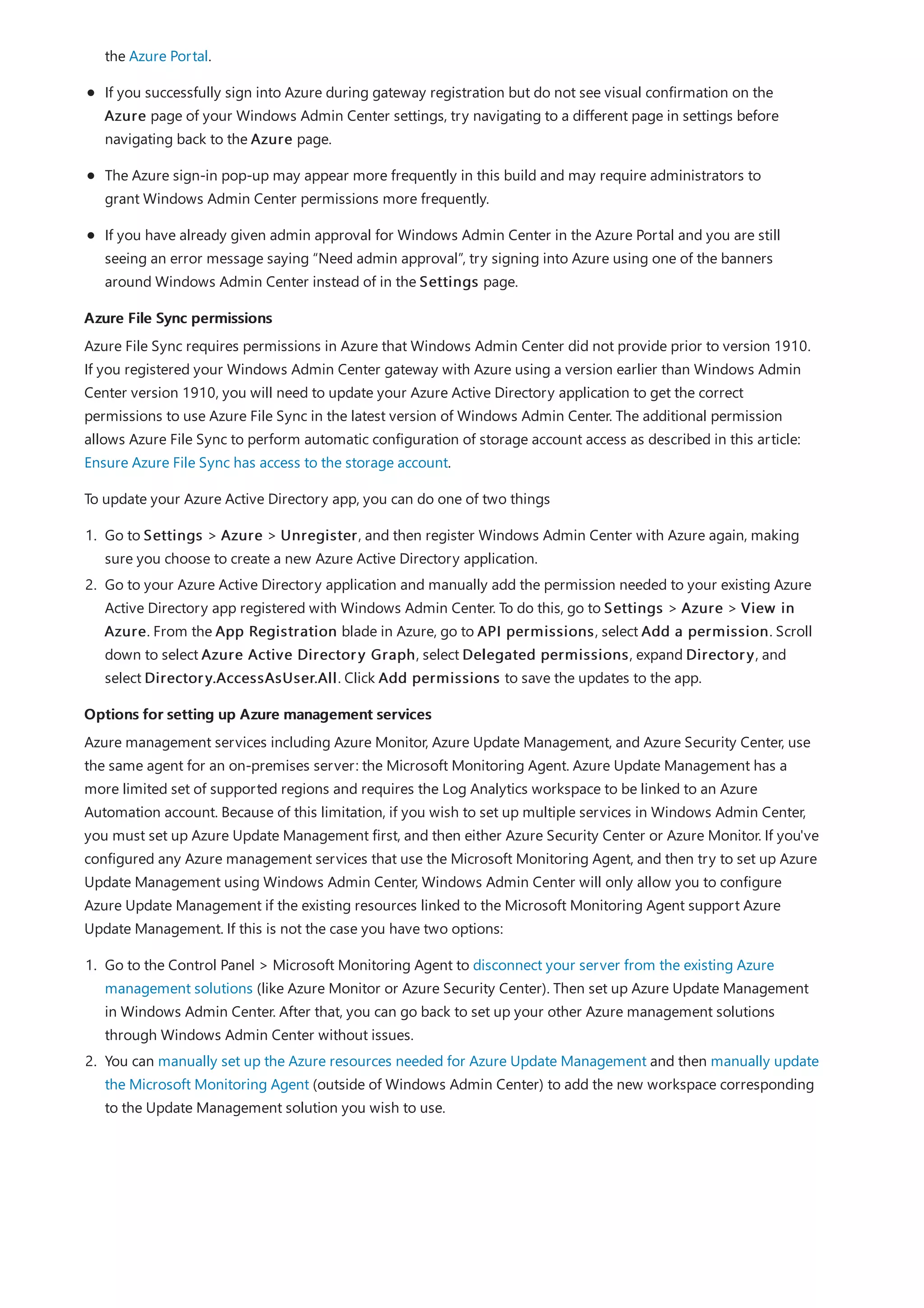



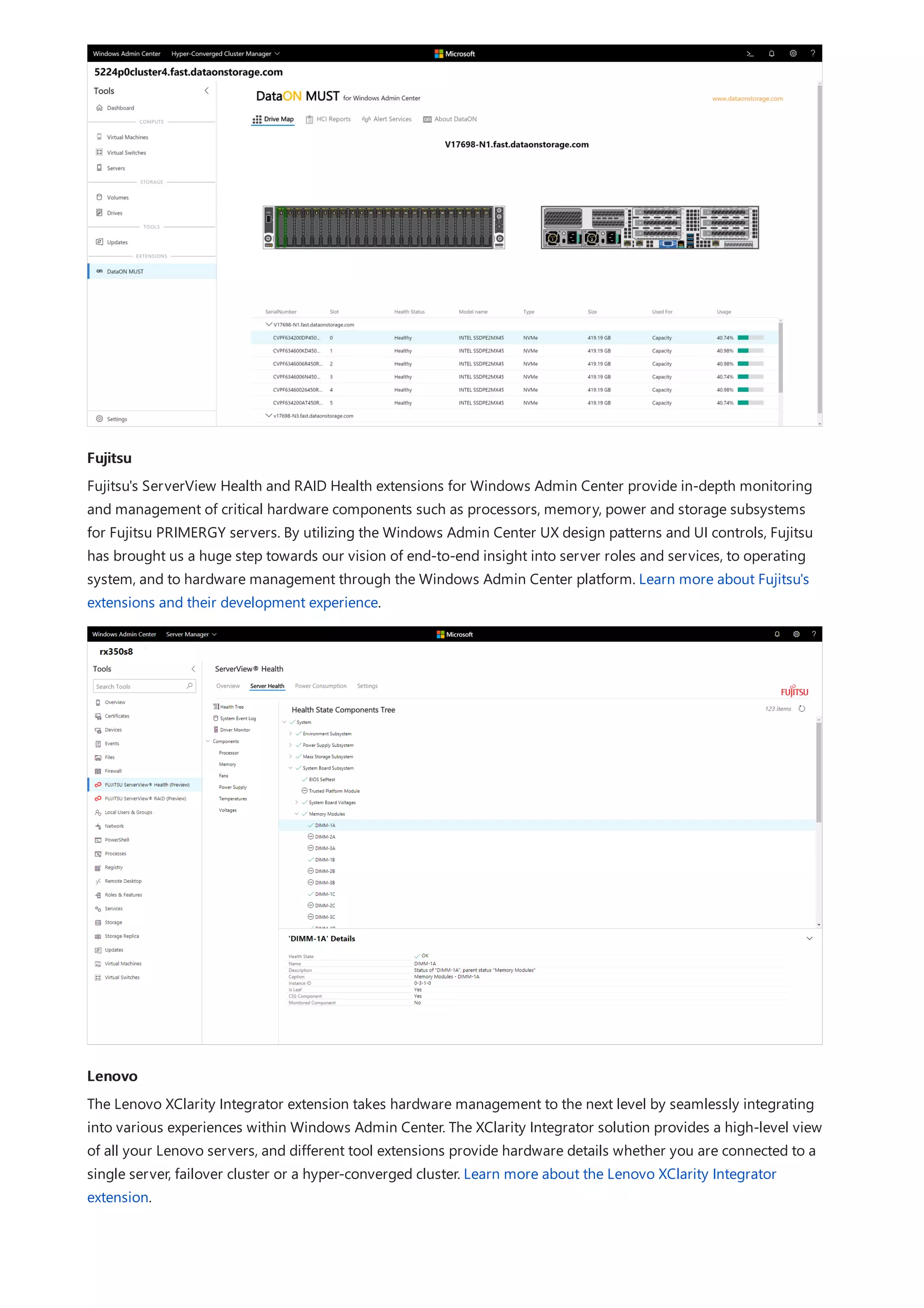


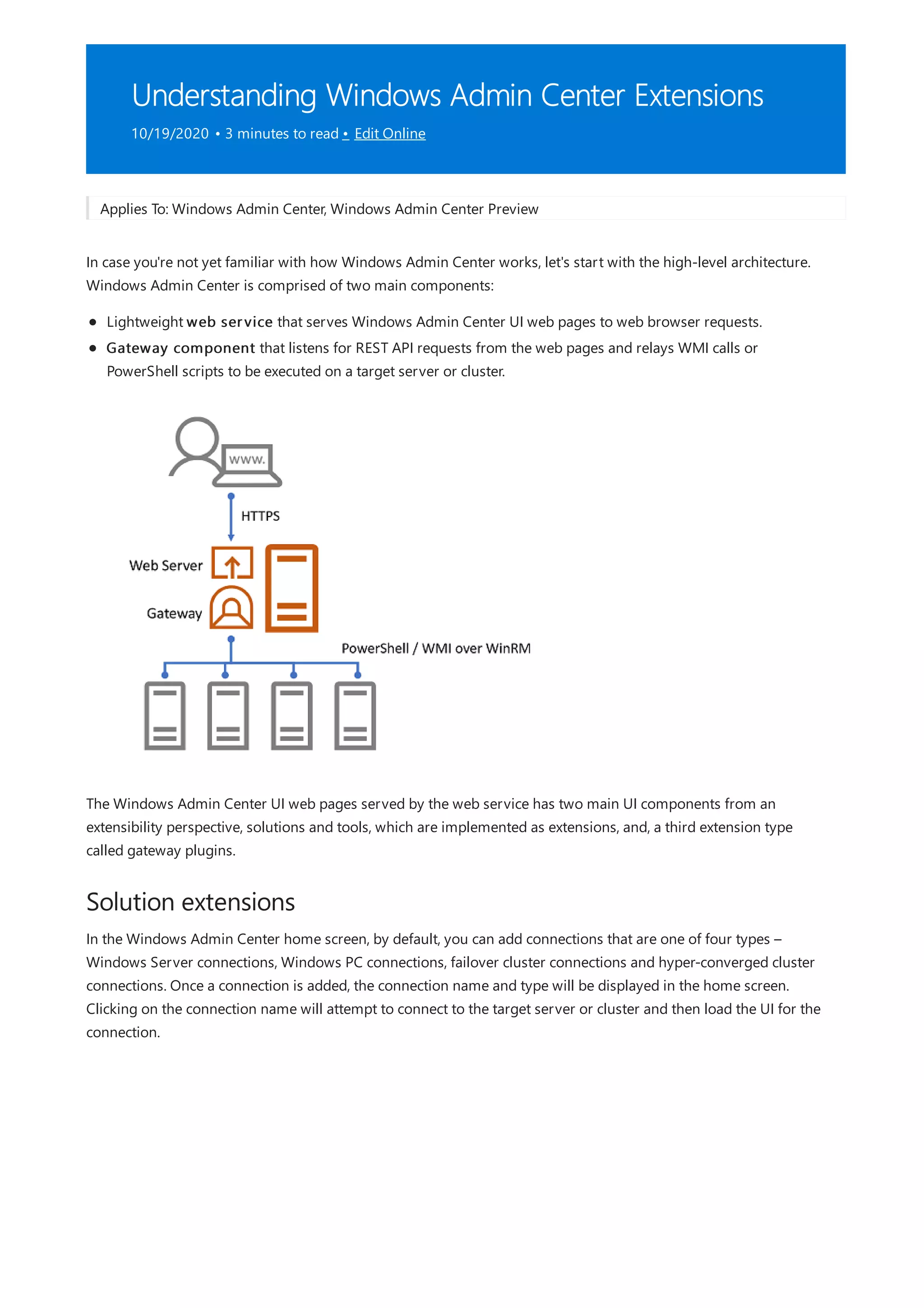
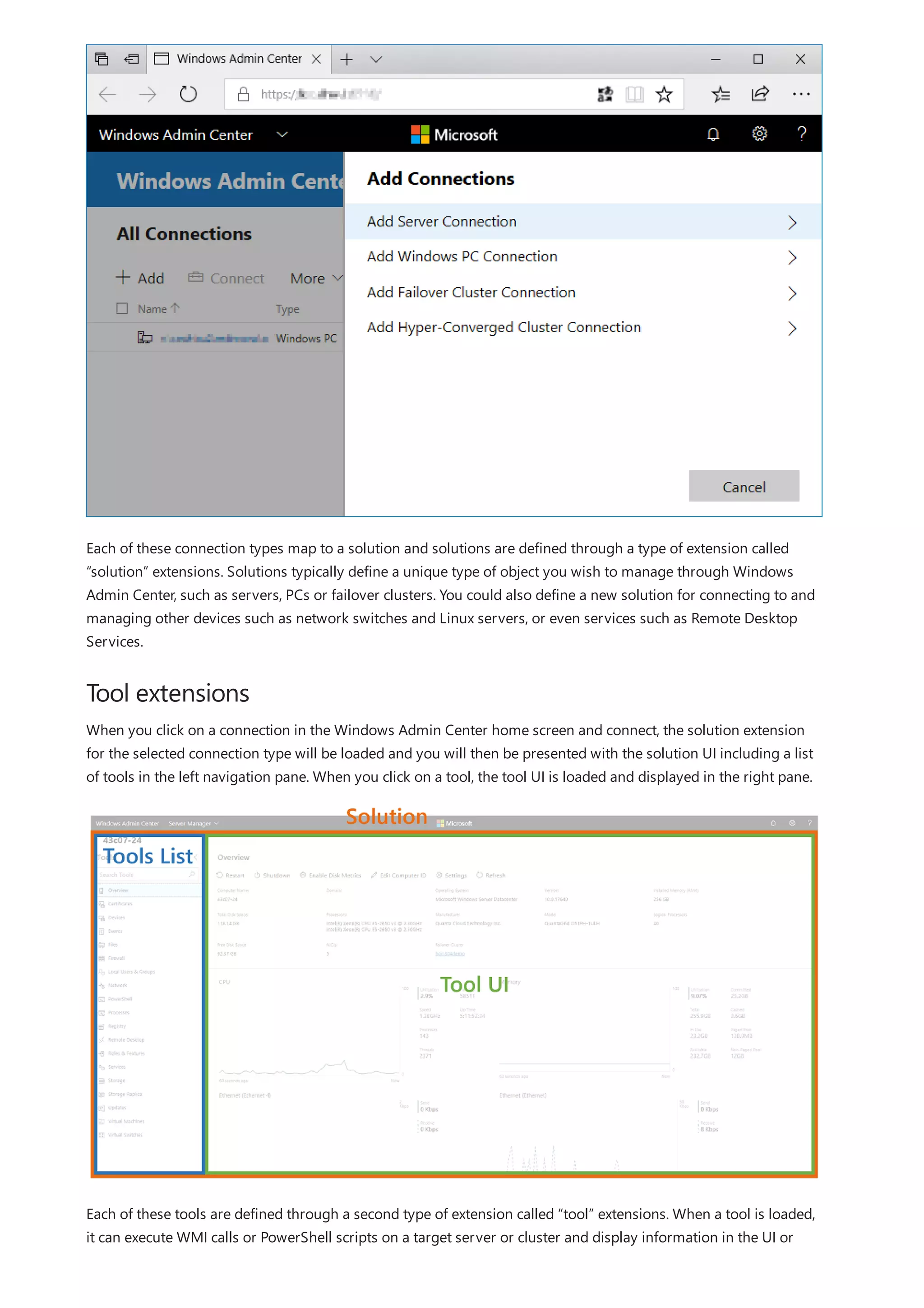
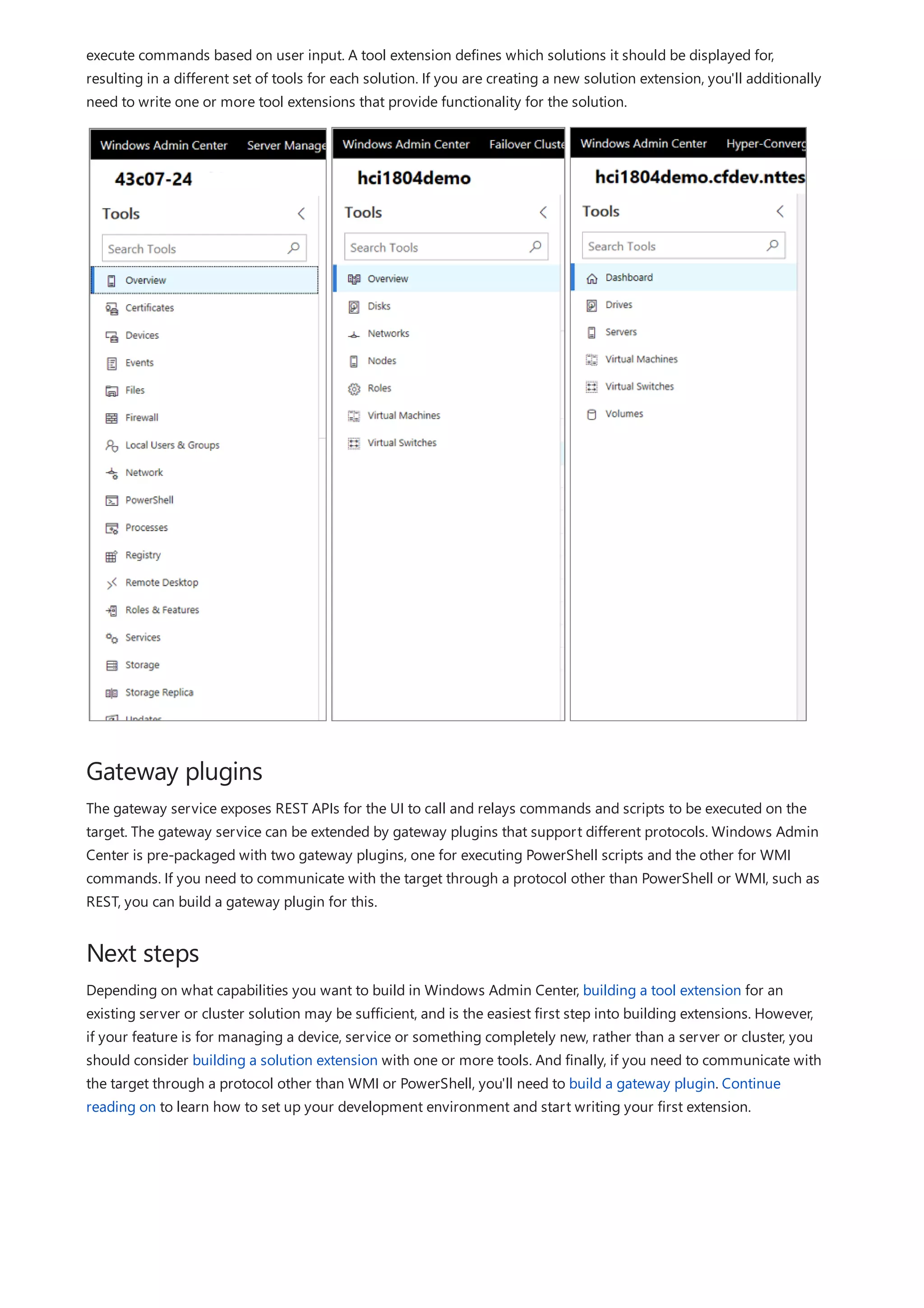

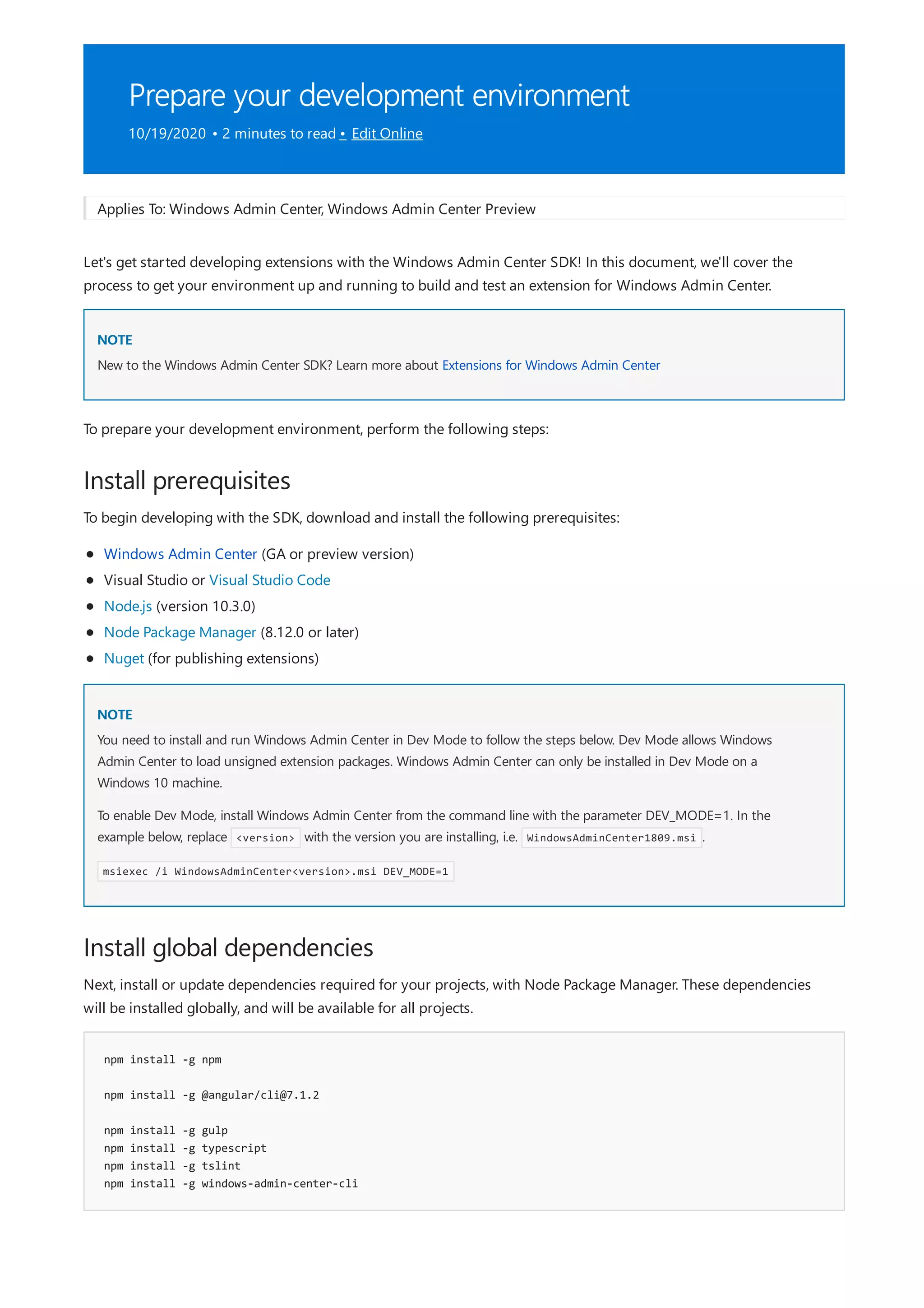

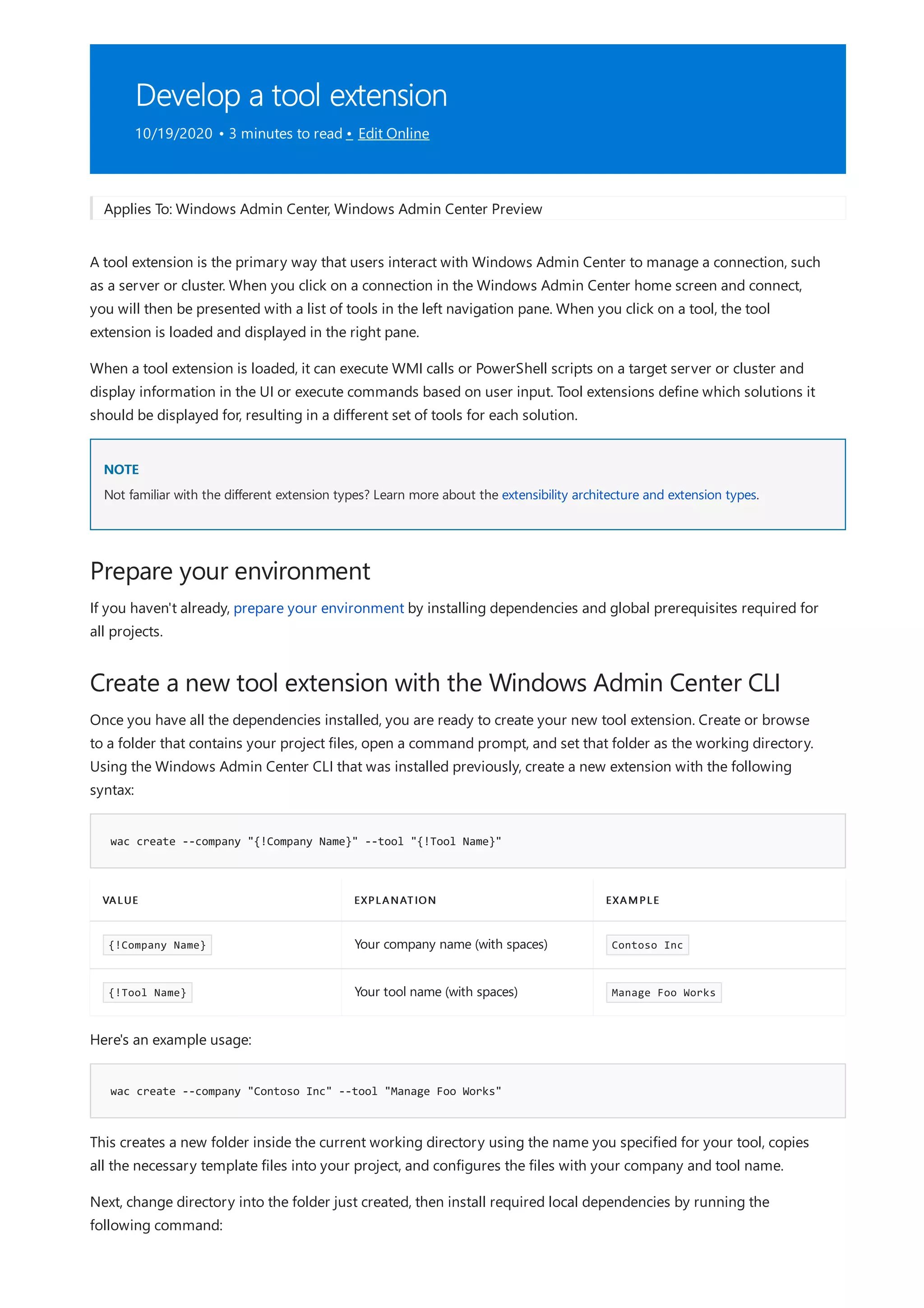

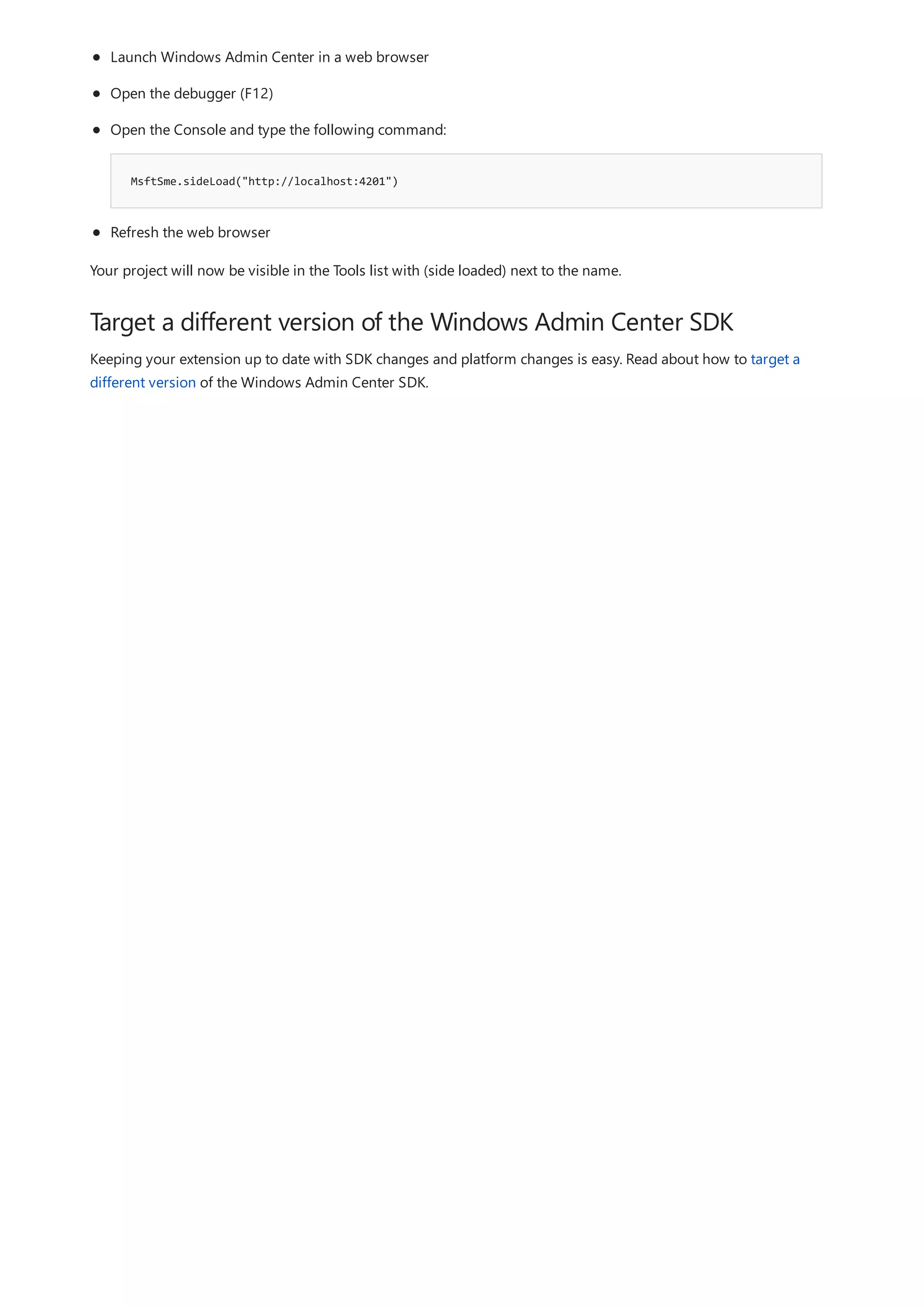

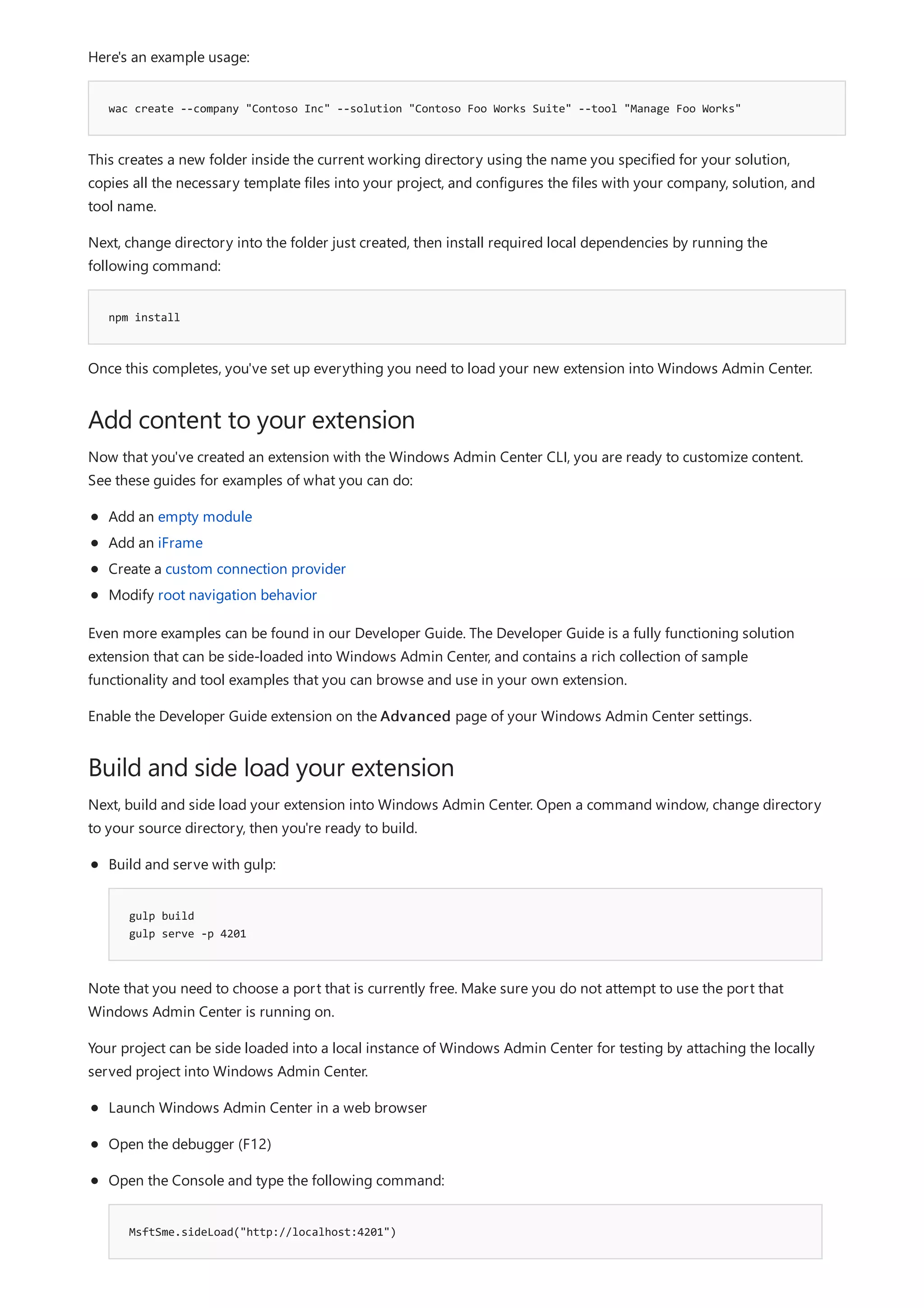

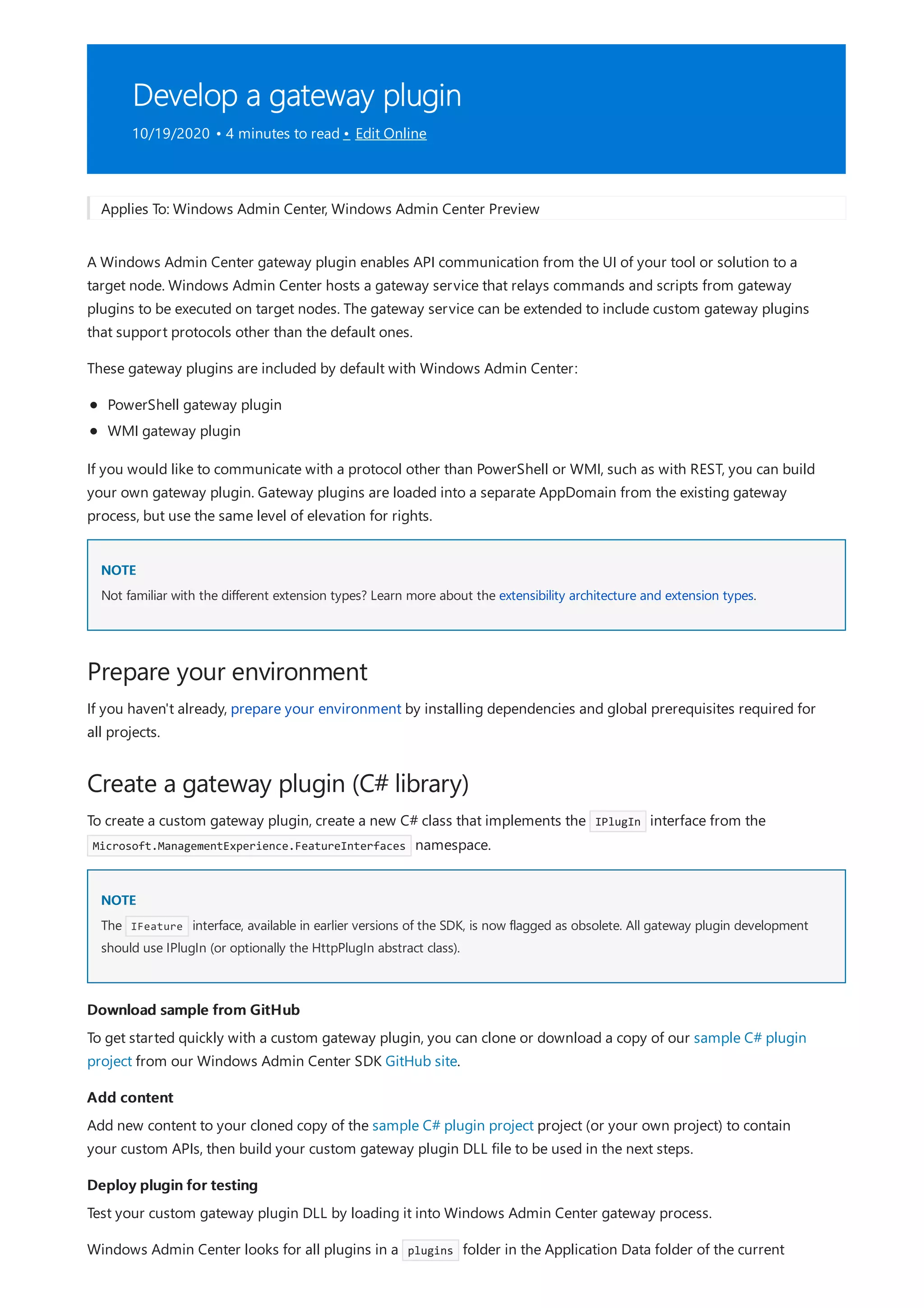






![Add content to new routing file
Add content to new module file
VALUE EXPLANATION EXAMPLE FILENAME
{!module-name} Your module name (lower case, spaces
replaced with dashes)
manage-foo-works-portal.module.ts
VALUE EXPLANATION EXAMPLE FILENAME
{!module-name} Your module name (lower case,
spaces replaced with dashes)
manage-foo-works-
portal.routing.ts
import { NgModule } from '@angular/core';
import { RouterModule, Routes } from '@angular/router';
import { {!ModuleName}Component } from './{!module-name}.component';
const routes: Routes = [
{
path: '',
component: {!ModuleName}Component,
// if the component has child components that need to be routed to, include them in the
children array.
children: [
{
path: '',
redirectTo: 'base',
pathMatch: 'full'
}
]
}];
@NgModule({
imports: [
RouterModule.forChild(routes)
],
exports: [
RouterModule
]
})
export class Routing { }
VALUE EXPLANATION EXAMPLE
{!ModuleName} Your module name (spaces removed) ManageFooWorksPortal
{!module-name} Your module name (lower case,
spaces replaced with dashes)
manage-foo-works-portal
Browse to the module folder that was created by ng generate in the previous step.
Create a new file {!module-name}.routing.ts , following this naming convention:
Add this content to the file just created:
Replace values in the file just created with your desired values:
Open file {!module-name}.module.ts , found with the following naming convention:
Add content to the file:](https://image.slidesharecdn.com/admincenter-201105101733/75/Admincenter-166-2048.jpg)
![Add content to new component typescript file
VALUE EXPLANATION EXAMPLE FILENAME
{!module-name} Your module name (lower case, spaces
replaced with dashes)
manage-foo-works-
portal.component.ts
constructor() {
// TODO
}
public ngOnInit() {
// TODO
}
Update app-routing.module.ts
VALUE EXPLANATION EXAMPLE
{!ModuleName} Your module name (spaces removed) ManageFooWorksPortal
{!module-name} Your module name (lower case, spaces
replaced with dashes)
manage-foo-works-portal
{
path: '',
loadChildren: 'app/{!module-name}/{!module-name}.module#{!ModuleName}Module'
},
import { Routing } from './{!module-name}.routing';
VALUE EXPLANATION EXAMPLE
{!module-name} Your module name (lower case,
spaces replaced with dashes)
manage-foo-works-portal
ORIGINAL VALUE NEW VALUE
imports: [ CommonModule ] imports: [ CommonModule, Routing ]
Replace values in the content just added with your desired values:
Modify the imports statement to import Routing:
Make sure import statements are alphabetized by source.
Open file {!module-name}.component.ts , found with the following naming convention:
Modify content in the file to the following:
Open file app-routing.module.ts , and modify the default path so it will load the new module you just created. Find
the entry for path: '' , and update loadChildren to load your module instead of the default module:
Here's an example of an updated default path:](https://image.slidesharecdn.com/admincenter-201105101733/75/Admincenter-167-2048.jpg)

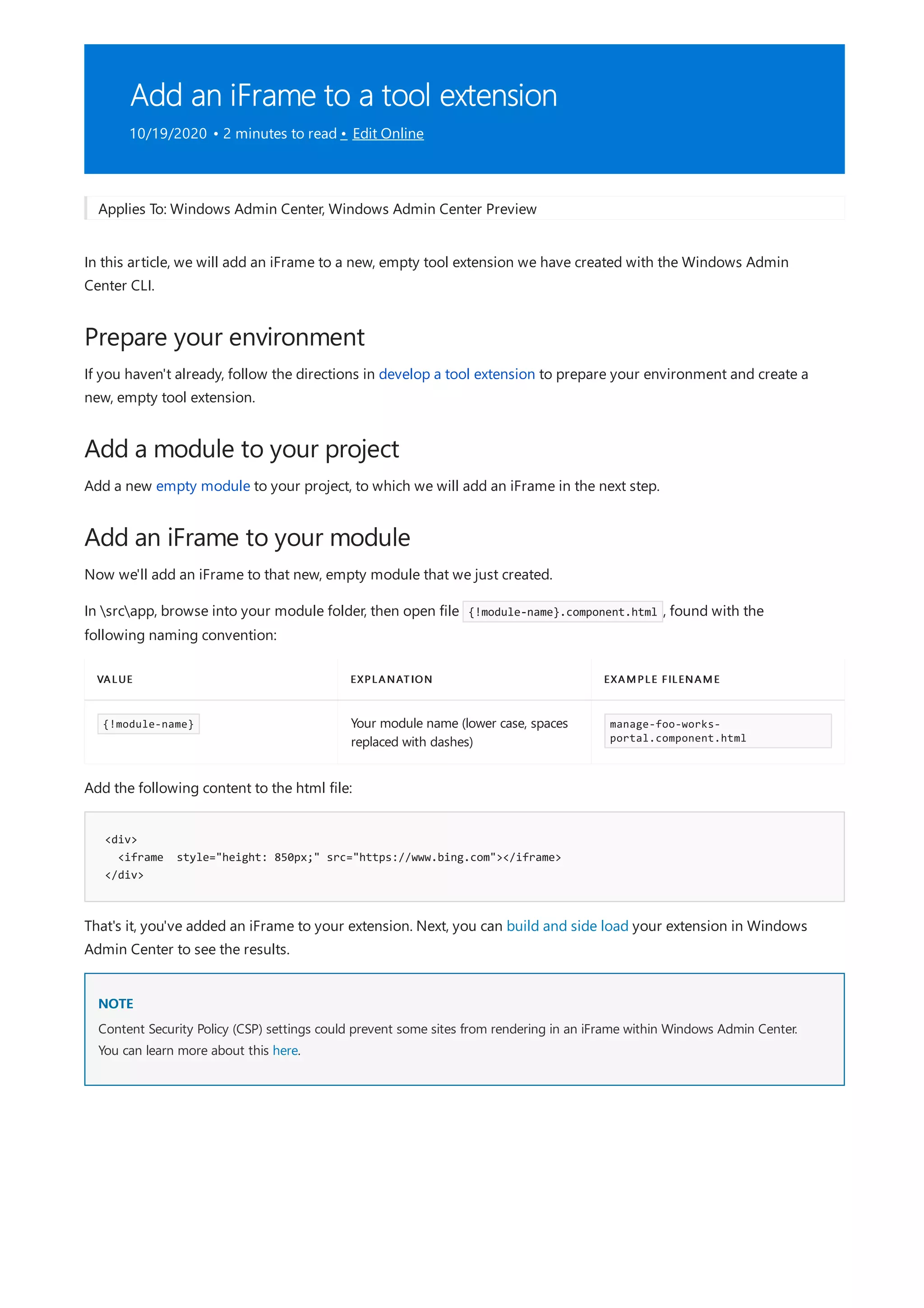

![WARNING
Modify module.ts
import { HttpService } from '@microsoft/windows-admin-center-sdk/angular';
import { Http } from '@microsoft/windows-admin-center-sdk/core';
import { PluginService } from './plugin.service';
,
providers: [
HttpService,
PluginService,
Http
]
Modify component.ts
import { ActivatedRouteSnapshot } from '@angular/router';
import { AppContextService } from '@microsoft/windows-admin-center-sdk/angular';
import { Subscription } from 'rxjs';
import { Strings } from '../../generated/strings';
import { PluginService } from './plugin.service';
private serviceSubscription: Subscription;
private responseResult: string;
It is recommended that the built in this.appContextService.node is used for calling any API that is defined in your
custom gateway plugin. This will ensure that if credentials are required inside of your gateway plugin that they will be
handled properly.
Open the module.ts file of the new module created earlier (i.e. {!Module-Name}.module.ts ):
Add the following import statements:
Add the following providers (after declarations):
Open the component.ts file of the new module created earlier (i.e. {!Module-Name}.component.ts ):
Add the following import statements:
Add the following variables:
Modify the constructor and modify/add the following functions:](https://image.slidesharecdn.com/admincenter-201105101733/75/Admincenter-171-2048.jpg)
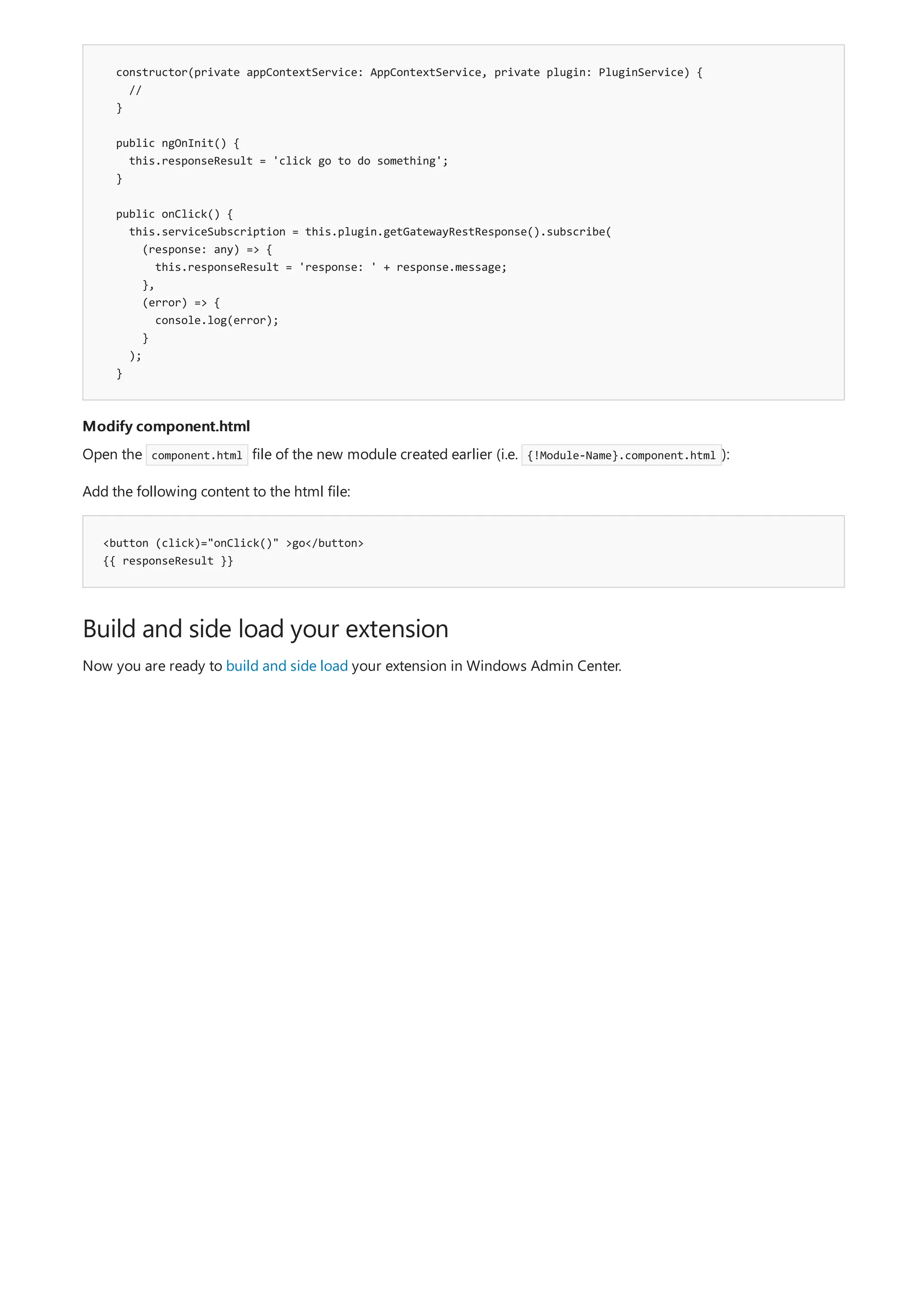
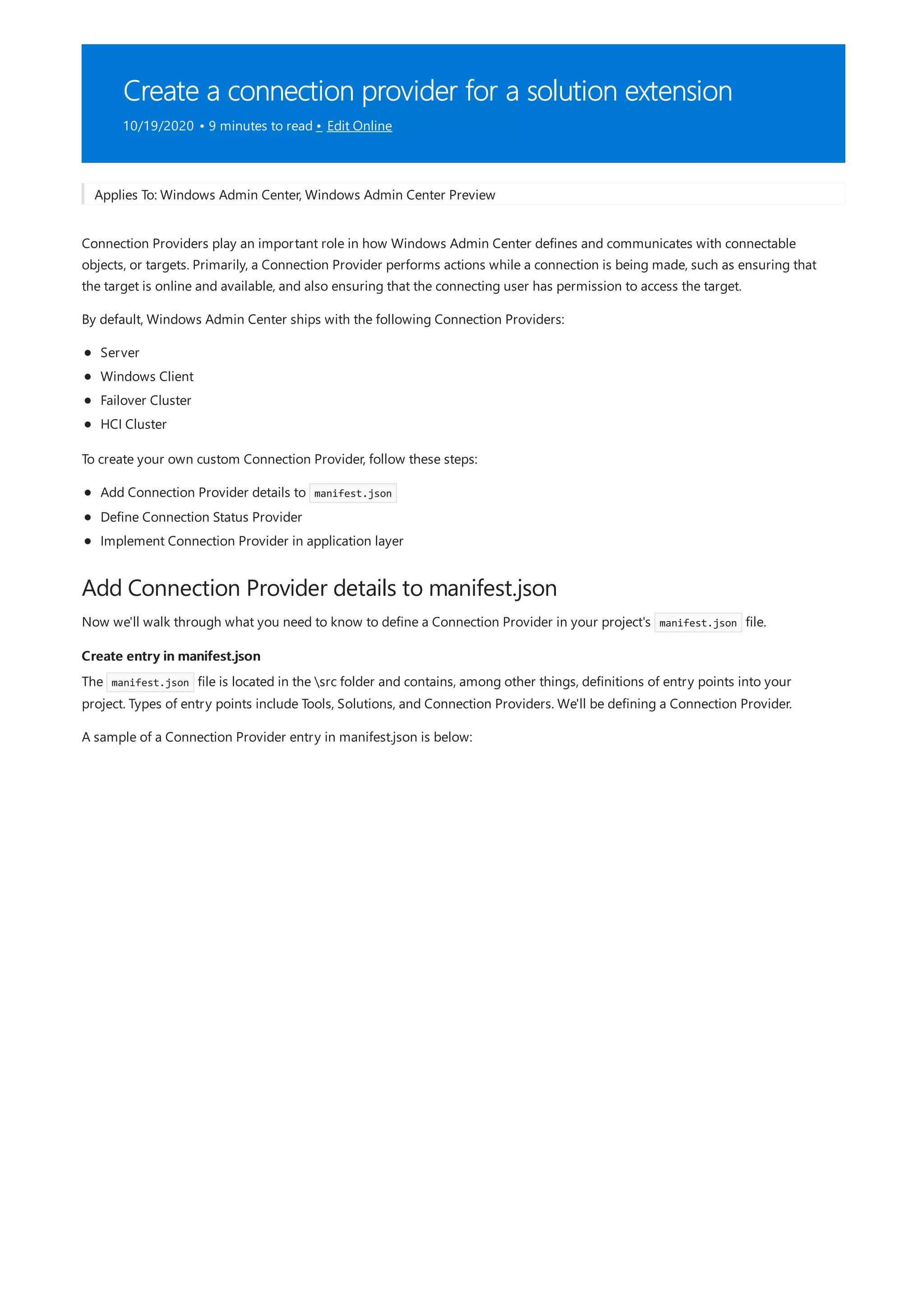
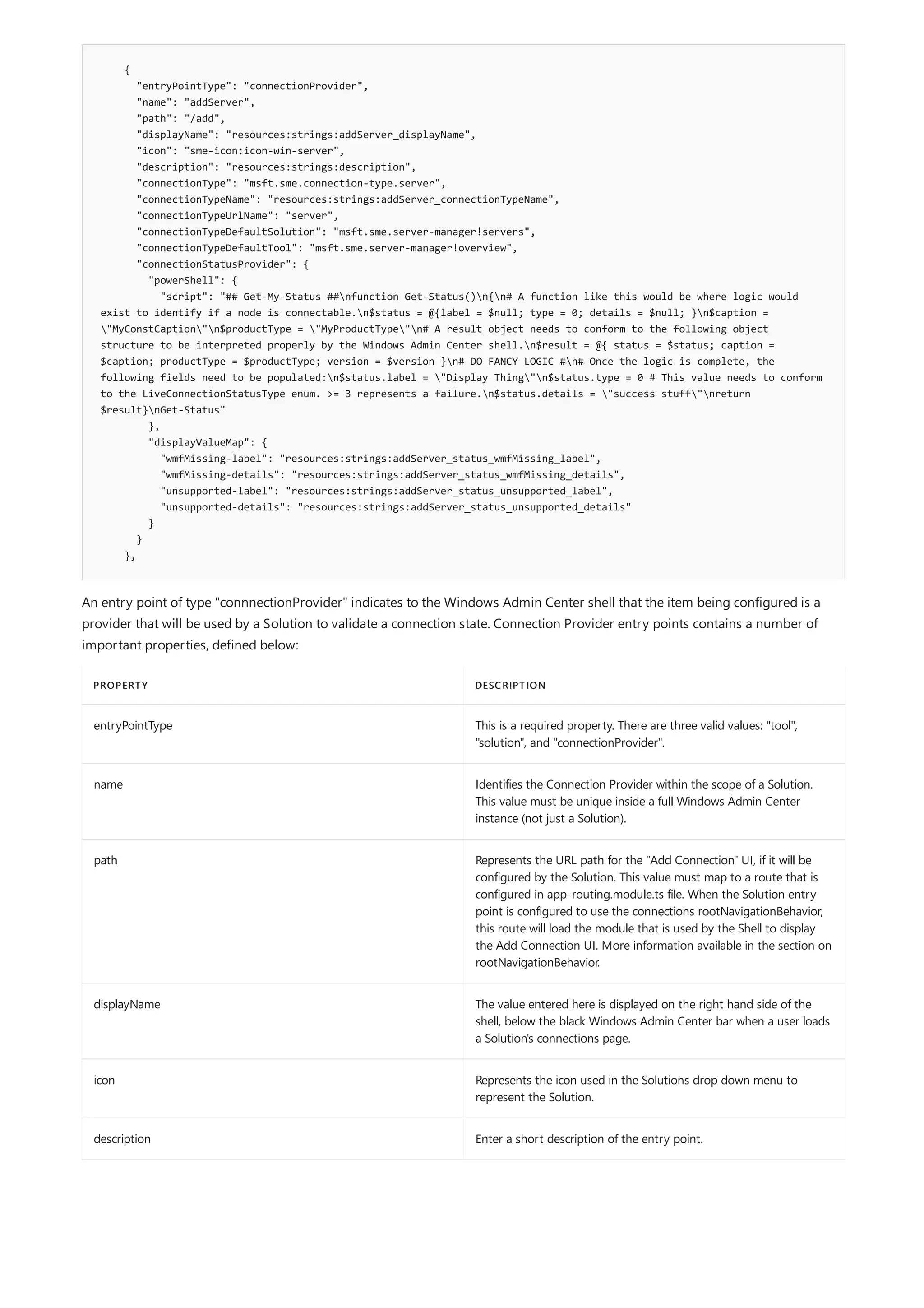
![connectionType Represents the connection type that the provider will load. The value
entered here will also be used in the Solution entry point to specify
that the Solution can load those connections. The value entered here
will also be used in Tool entry point(s) to indicate that the Tool is
compatible with this type. This value entered here will also be used
in the connection object that is submitted to the RPC call on the
"Add window", in the application layer implementation step.
connectionTypeName Used in the connections table to represent a connection that uses
your Connection Provider. This is expected to be the plural name of
the type.
connectionTypeUrlName Used in creating the URL to represent the loaded Solution, after
Windows Admin Center has connected to an instance. This entry is
used after connections, and before the target. In this example,
"connectionexample" is where this value appears in the URL:
http://localhost:6516/solutionexample/connections/connectionexample/con-
fake1.corp.contoso.com
connectionTypeDefaultSolution Represents the default component that should be loaded by the
Connection Provider. This value is a combination of:
[a] The name of the extension package defined at the top of the
manifest;
[b] Exclamation point (!);
[c] The Solution entry point name.
For a project with name "msft.sme.mySample-extension", and a
Solution entry point with name "example", this value would be
"msft.sme.solutionExample-extension!example".
connectionTypeDefaultTool Represents the default Tool that should be loaded on a successful
connection. This property value is made up of two parts, similar to
the connectionTypeDefaultSolution. This value is a combination of:
[a] The name of the extension package defined at the top of the
manifest;
[b] Exclamation point (!);
[c] The Tool entry point name for the Tool that should be loaded
initially.
For a project with name "msft.sme.solutionExample-extension", and a
Solution entry point with name "example", this value would be
"msft.sme.solutionExample-extension!example".
connectionStatusProvider Please see section "Define Connection Status Provider"
PROPERTY DESCRIPTION
Define Connection Status Provider
Define status
Connection Status Provider is the mechanism by which a target is validated to be online and available, also ensuring that the
connecting user has permission to access the target. There are currently two types of Connection Status Providers: PowerShell,
and RelativeGatewayUrl.
PowerShell Connection Status Provider - Determines if a target is online and accessible with a PowerShell script. The
result must be returned in an object with a single property "status", defined below.
RelativeGatewayUrl Connection Status Provider - Determines if a target is online and accessible with a rest call. The
result must be returned in an object with a single property "status", defined below.
Connection Status Providers are required to return an object with a single property status that conforms to the following
format:](https://image.slidesharecdn.com/admincenter-201105101733/75/Admincenter-175-2048.jpg)
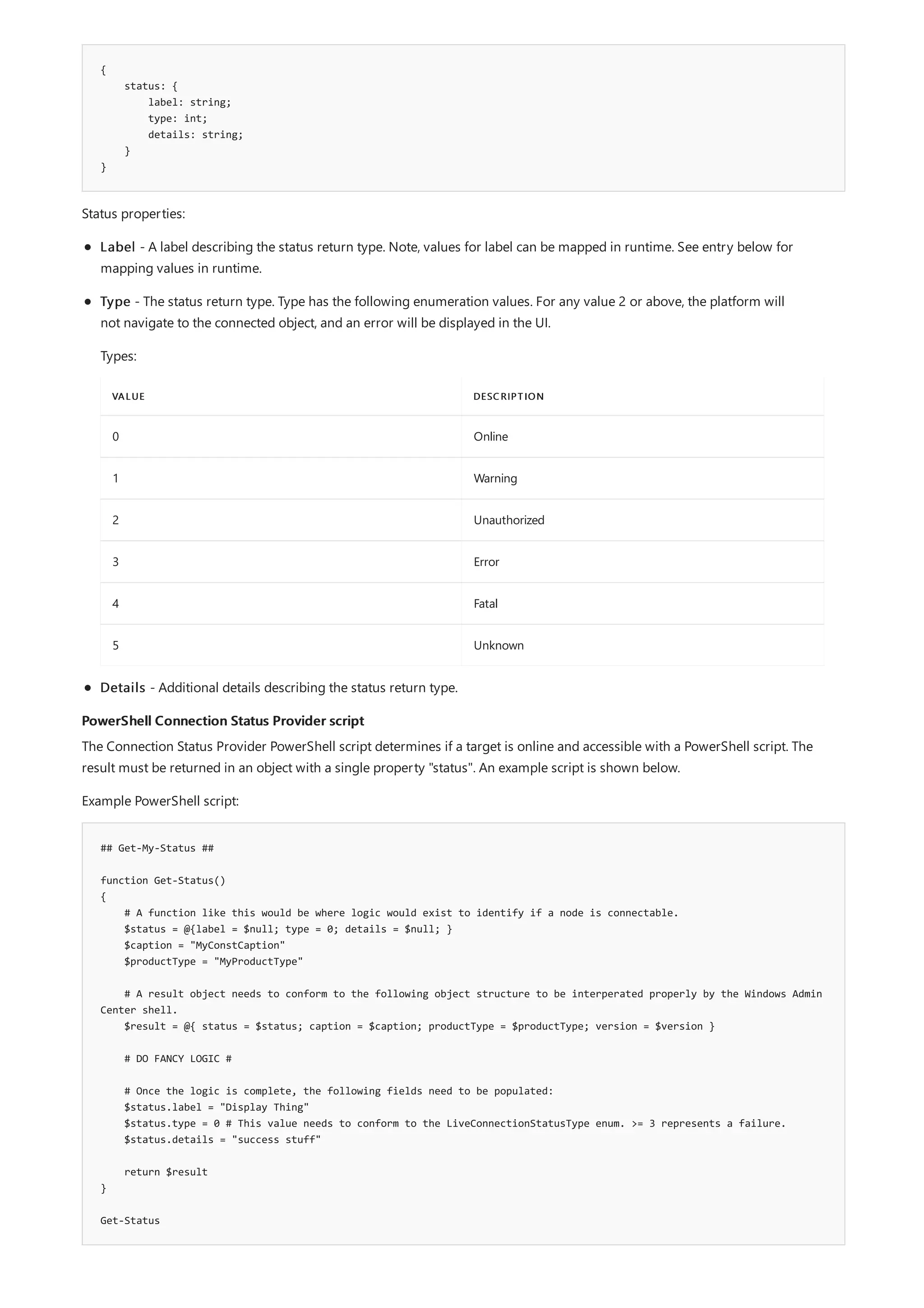


![/**
* The connection attributes class.
*/
export interface ConnectionAttribute {
/**
* The id string of this attribute
*/
id: string;
/**
* The value of the attribute. used for attributes that can have variable values such as Operating System
*/
value?: string | number;
}
/**
* The connection class.
*/
export interface Connection {
/**
* The id of the connection, this is unique per connection
*/
id: string;
/**
* The type of connection
*/
type: string;
/**
* The name of the connection, this is unique per connection type
*/
name: string;
/**
* The property bag of the connection
*/
properties?: ConnectionProperties;
/**
* The ids of attributes identified for this connection
*/
attributes?: ConnectionAttribute[];
/**
* The tags the user(s) have assigned to this connection
*/
tags?: string[];
}
/**
* Defines connection type strings known by core
* Be careful that these strings match what is defined by the manifest of @msft-sme/server-manager
*/
export const connectionTypeConstants = {
server: 'msft.sme.connection-type.server',
cluster: 'msft.sme.connection-type.cluster',
hyperConvergedCluster: 'msft.sme.connection-type.hyper-converged-cluster',
windowsClient: 'msft.sme.connection-type.windows-client',
clusterNodesProperty: 'nodes'
};
Define onCancel
this.appContextService.rpc.updateData(EnvironmentModule.nameOfShell, '##', <RpcUpdateData>{ results: { connections: [] }
});
onCancel cancels an "Add Connection" attempt by passing an empty connections array:](https://image.slidesharecdn.com/admincenter-201105101733/75/Admincenter-179-2048.jpg)
![Connection Provider example
import { Component, OnInit } from '@angular/core';
import { ActivatedRoute } from '@angular/router';
import { AppContextService } from '@msft-sme/shell/angular';
import { Connection, ConnectionUtility } from '@msft-sme/shell/core';
import { EnvironmentModule } from '@msft-sme/shell/dist/core/manifest/environment-modules';
import { RpcUpdateData } from '@msft-sme/shell/dist/core/rpc/rpc-base';
import { Strings } from '../../generated/strings';
@Component({
selector: 'add-example',
templateUrl: './add-example.component.html',
styleUrls: ['./add-example.component.css']
})
export class AddExampleComponent implements OnInit {
public newConnectionName: string;
public strings = MsftSme.resourcesStrings<Strings>().SolutionExample;
private connectionType = 'msft.sme.connection-type.example'; // This needs to match the connectionTypes value used in
the manifest.json.
constructor(private appContextService: AppContextService, private route: ActivatedRoute) {
// TODO:
}
public ngOnInit() {
// TODO
}
public onSubmit() {
let connections: Connection[] = [];
let connection = <Connection> {
id: ConnectionUtility.createConnectionId(this.connectionType, this.newConnectionName),
type: this.connectionType,
name: this.newConnectionName
};
connections.push(connection);
this.appContextService.rpc.updateData(
EnvironmentModule.nameOfShell,
'##',
<RpcUpdateData> {
results: {
connections: connections,
credentials: null
}
}
);
}
public onCancel() {
this.appContextService.rpc.updateData(
EnvironmentModule.nameOfShell, '##', <RpcUpdateData>{ results: { connections: [] } });
}
}
The full TypeScript class for implementing a connection provider is below. Note that the "connectionType" string matches the
"connectionType as defined in the connection provider in manifest.json.](https://image.slidesharecdn.com/admincenter-201105101733/75/Admincenter-180-2048.jpg)
![Modify root navigation behavior for a solution
extension
10/19/2020 • 2 minutes to read • Edit Online
Modifying root navigation behavior
Setting path as a rootNavigationBehavior
"entryPoints": [
{
"entryPointType": "solution",
"name": "main",
"urlName": "testsln",
"displayName": "resources:strings:displayName",
"description": "resources:strings:description",
"icon": "sme-icon:icon-win-powerShell",
"path": "",
"rootNavigationBehavior": "path"
}
],
Setting connections as a rootNavigationBehavior
Applies To: Windows Admin Center, Windows Admin Center Preview
In this guide we will learn how to modify the root navigation behavior for your solution to have different
connection list behavior, as well as how to hide or show the tools list.
Open manifest.json file in {extension root}src, and find the property "rootNavigationBehavior". This property has
two valid values: "connections" or "path". The "connections" behavior is detailed later in the documentation.
Set the value of rootNavigationBehavior to path , and then delete the requirements property, and leave the path
property as an empty string. You have completed the minimal required configuration to build a solution extension.
Save the file, and gulp build -> gulp serve as you would a tool, and then side load the extension into your local
Windows Admin Center extension.
A valid manifest entryPoints array looks like this:
Tools built with this kind of structure will not required connections to load, but won't have node connectivity
functionality either.
When you set the rootNavigationBehavior property to connections , you are telling the Windows Admin Center
Shell that there will be a connected node (always a server of some type) that it should connect to, and verify
connection status. With this, there are 2 steps in verifying connection. 1) Windows Admin Center will attempt to
make an attempt to log into the node with your credentials (for establishing the remote PowerShell session), and
2) it will execute the PowerShell script you provide to identify if the node is in a connectable state.
A valid solution definition with connections will look like this:](https://image.slidesharecdn.com/admincenter-201105101733/75/Admincenter-181-2048.jpg)
![{
"entryPointType": "solution",
"name": "example",
"urlName": "solutionexample",
"displayName": "resources:strings:displayName",
"description": "resources:strings:description",
"icon": "sme-icon:icon-win-powerShell",
"rootNavigationBehavior": "connections",
"connections": {
"header": "resources:strings:connectionsListHeader",
"connectionTypes": [
"msft.sme.connection-type.example"
]
},
"tools": {
"enabled": false,
"defaultTool": "solution"
}
},
Enabling and disabling the tools menu
When the rootNavigationBehavior is set to "connections" you are required to build out the connections definition
in the manifest. This includes the "header" property (will be used to display in your solution header when a user
selects it from the menu), a connectionTypes array (this will specify which connectionTypes are used in the solution.
More on that in the connectionProvider documentation.).
Another property available in the solution definition is the "tools" property. This will dictate if the tools menu is
displayed, as well as the tool that will be loaded. When enabled, Windows Admin Center will render the left hand
tools menu. With defaultTool, it is required that you add a tool entry point to the manifest in order to load the
appropriate resources. The value of "defaultTool" needs to be the "name" property of the tool as it is defined in the
manifest.](https://image.slidesharecdn.com/admincenter-201105101733/75/Admincenter-182-2048.jpg)
![Control your tool's visibility in a solution
10/19/2020 • 5 minutes to read • Edit Online
Options for deciding when to show a tool
LocalHost
"conditions": [
{
"localhost": true
}]
"conditions": [
{
"localhost": false
}]
Applies To: Windows Admin Center, Windows Admin Center Preview
There might be times when you want to exclude (or hide) your extension or tool from the available tools list. For
example, if your tool targets only Windows Server 2016 (not older versions), you might not want a user who
connects to a Windows Server 2012 R2 server to see your tool at all. (Imagine the user experience - they click on it,
wait for the tool to load, only to get a message that its features aren't available for their connection.) You can define
when to show (or hide) your feature in the tool's manifest.json file.
There are three different options you can use to determine whether your tool should be displayed and available for
a specific server or cluster connection.
localhost
inventory (an array of properties)
script
The localHost property of the Conditions object contains a boolean value that can be evaluated to infer if the
connecting node is localHost (the same computer that Windows Admin Center is installed on) or not. By passing a
value to the property, you indicate when (the condition) to display the tool. For example if you only want the tool to
display if the user is in fact connecting to the local host, set it up like this:
Alternatively, if you only want your tool to display when the connecting node is not localhost:
Here's what the configuration settings look like to only show a tool when the connecting node is not localhost:](https://image.slidesharecdn.com/admincenter-201105101733/75/Admincenter-183-2048.jpg)
!["entryPoints": [
{
"entryPointType": "tool",
"name": "main",
"urlName": "processes",
"displayName": "resources:strings:displayName",
"description": "resources:strings:description",
"icon": "sme-icon:icon-win-serverProcesses",
"path": "",
"requirements": [
{
"solutionIds": [
"msft.sme.server-manager!windowsClients"
],
"connectionTypes": [
"msft.sme.connection-type.windows-client"
],
"conditions": [
{
"localhost": true
}
]
}
]
}
Inventory properties
PROPERTY NAME EXPECTED VALUE TYPE
computerManufacturer string
operatingSystemSKU number
operatingSystemVersion version_string (eg: "10.1.*")
productType number
clusterFqdn string
isHyperVRoleInstalled boolean
isHyperVPowershellInstalled boolean
isManagementToolsAvailable boolean
isWmfInstalled boolean
"<property name>": {
"type": "<expected type>",
"operator": "<defined operator to use>",
"value": "<expected value to evaluate using the operator>"
}
The SDK includes a pre-curated set of inventory properties that you can use to build conditions to determine when
your tool should be available or not. There are nine different properties in the 'inventory' array:
Every object in the inventory array must conform to the following json structure:](https://image.slidesharecdn.com/admincenter-201105101733/75/Admincenter-184-2048.jpg)

!["entryPoints": [
{
"entryPointType": "tool",
"name": "main",
"urlName": "processes",
"displayName": "resources:strings:displayName",
"description": "resources:strings:description",
"icon": "sme-icon:icon-win-serverProcesses",
"path": "",
"requirements": [
{
"solutionIds": [
"msft.sme.server-manager!servers"
],
"connectionTypes": [
"msft.sme.connection-type.server"
],
"conditions": [
{
"inventory": {
"operatingSystemVersion": {
"type": "version",
"operator": "gt",
"value": "6.3"
},
"operatingSystemSKU": {
"type": "number",
"operator": "eq",
"value": "8"
}
}
}
]
}
]
}
Script
@{
State = 'Available' | 'NotSupported' | 'NotConfigured';
Message = '<Message to explain the reason of state such as not supported and not configured.>';
Properties =
@{ Name = 'Prop1'; Value = 'prop1 data'; Type = 'string' },
@{Name='Prop2'; Value = 12345678; Type='number'; };
}
VALUE DESCRIPTION
Available The extension should be displayed in the tools list.
NotSupported The extension should not be displayed in the tools list.
Finally, you can run a custom PowerShell script to identify the availability and state of the node. All scripts must
return an object with the following structure:
The State property is the important value that will control the decision to show or hide your extension in the tools
list. The allowed values are:](https://image.slidesharecdn.com/admincenter-201105101733/75/Admincenter-186-2048.jpg)

!["entryPoints": [
{
"entryPointType": "tool",
"name": "main",
"urlName": "processes",
"displayName": "resources:strings:displayName",
"description": "resources:strings:description",
"icon": "sme-icon:icon-win-serverProcesses",
"path": "",
"requirements": [
{
"solutionIds": [
"msft.sme.server-manager!windowsClients"
],
"connectionTypes": [
"msft.sme.connection-type.windows-client"
],
"conditions": [
{
"localhost": true,
"inventory": {
"operatingSystemVersion": {
"type": "version",
"operator": "eq",
"value": "10.0.*"
},
"operatingSystemSKU": {
"type": "number",
"operator": "eq",
"value": "4"
}
},
"script": "$response = @{ State = 'NotSupported'; Message = 'Not executed'; Properties = @{ Name =
'Prop1'; Value = 'prop1 data'; Type = 'string' }, @{Name='Prop2'; Value = 12345678; Type='number'; }; }; if
(Get-Module -ListAvailable -Name servermanager) { Import-module servermanager; $isInstalled = (Get-
WindowsFeature -name bitlocker).Installed; $isGood = $isInstalled; }; if($isGood) { $response.State =
'Available'; $response.Message = 'Everything should work.'; }; $response"
}
]
}
]
}
Supporting multiple requirement sets
You can use more than one set of requirements to determine when to display your tool by defining multiple
"requirements" blocks.
For example, to display your tool if "scenario A" OR "scenario B" is true, define two requirements blocks; if either is
true (that is, all conditions within a requirements block are met), the tool is displayed.](https://image.slidesharecdn.com/admincenter-201105101733/75/Admincenter-188-2048.jpg)
!["entryPoints": [
{
"requirements": [
{
"solutionIds": [
…"scenario A"…
],
"connectionTypes": [
…"scenario A"…
],
"conditions": [
…"scenario A"…
]
},
{
"solutionIds": [
…"scenario B"…
],
"connectionTypes": [
…"scenario B"…
],
"conditions": [
…"scenario B"…
]
}
]
}
Supporting condition ranges
You can also define a range of conditions by defining multiple "conditions" blocks with the same property, but with
different operators.
When the same property is defined with different operators, the tool is displayed as long as the value is between
the two conditions.
For example, this tool is displayed as long as the operating system is a version between 6.3.0 and 10.0.0:](https://image.slidesharecdn.com/admincenter-201105101733/75/Admincenter-189-2048.jpg)
!["entryPoints": [
{
"entryPointType": "tool",
"name": "main",
"urlName": "processes",
"displayName": "resources:strings:displayName",
"description": "resources:strings:description",
"icon": "sme-icon:icon-win-serverProcesses",
"path": "",
"requirements": [
{
"solutionIds": [
"msft.sme.server-manager!servers"
],
"connectionTypes": [
"msft.sme.connection-type.server"
],
"conditions": [
{
"inventory": {
"operatingSystemVersion": {
"type": "version",
"operator": "gt",
"value": "6.3.0"
},
}
},
{
"inventory": {
"operatingSystemVersion": {
"type": "version",
"operator": "lt",
"value": "10.0.0"
}
}
}
]
}
]
}](https://image.slidesharecdn.com/admincenter-201105101733/75/Admincenter-190-2048.jpg)

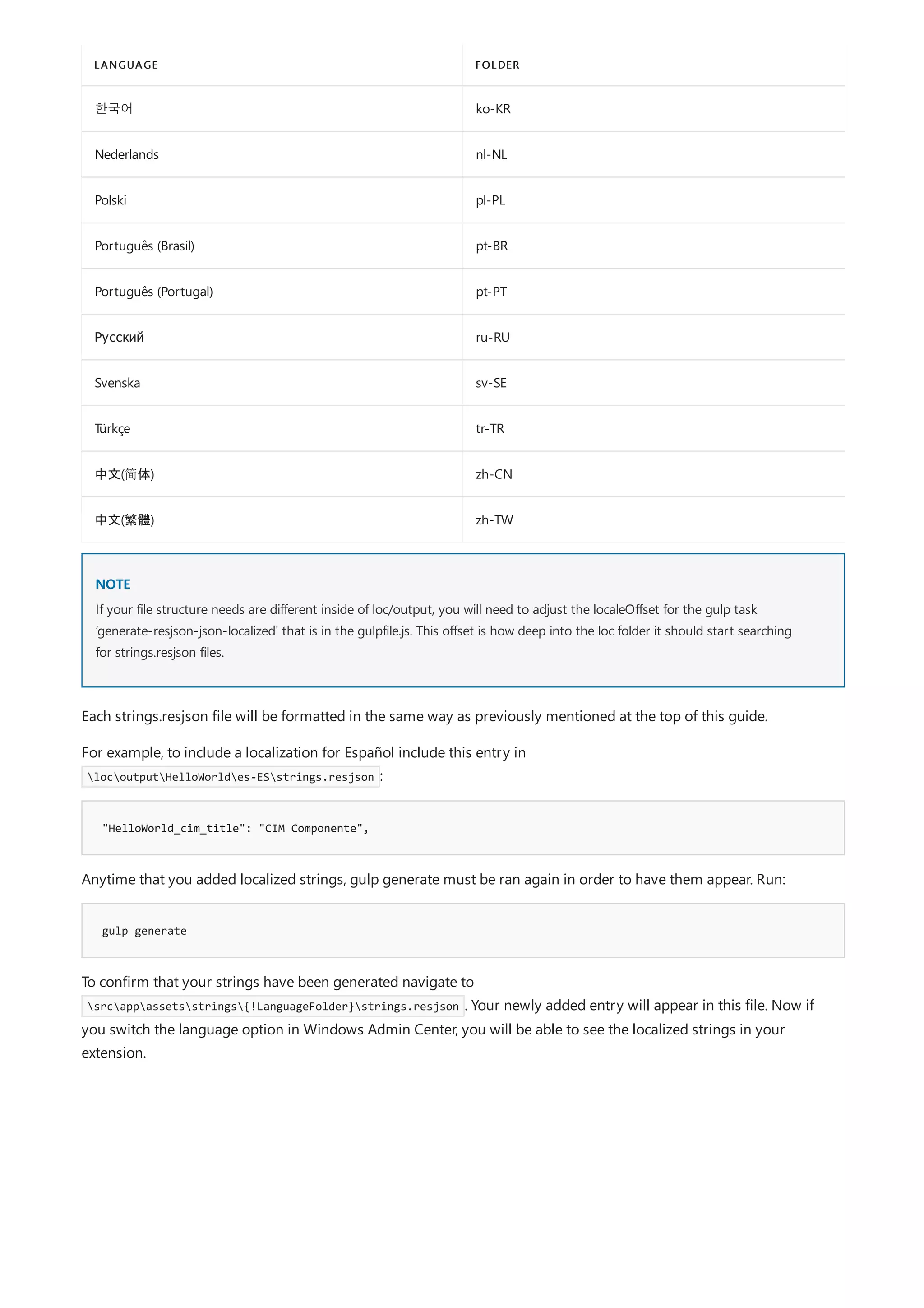

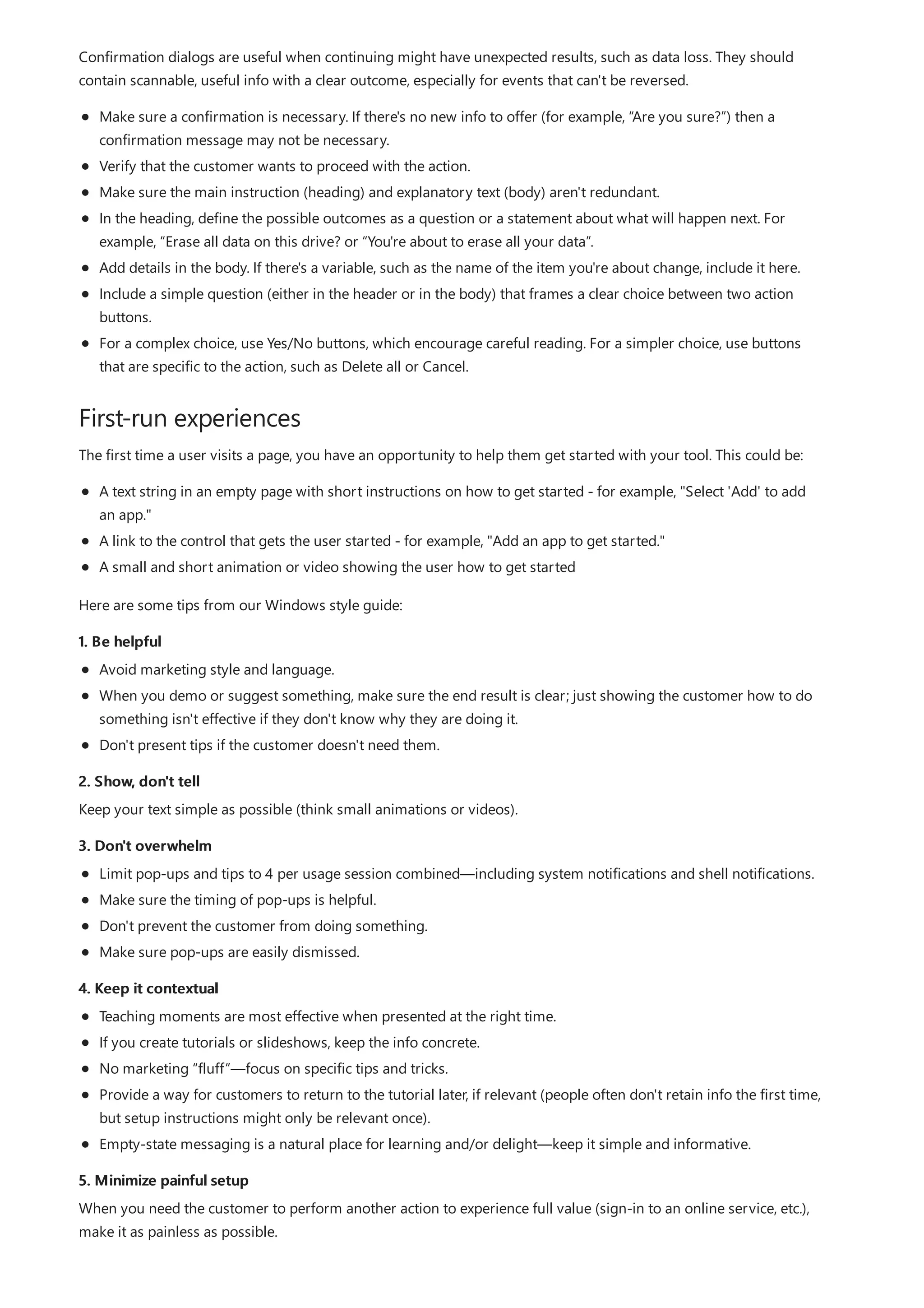


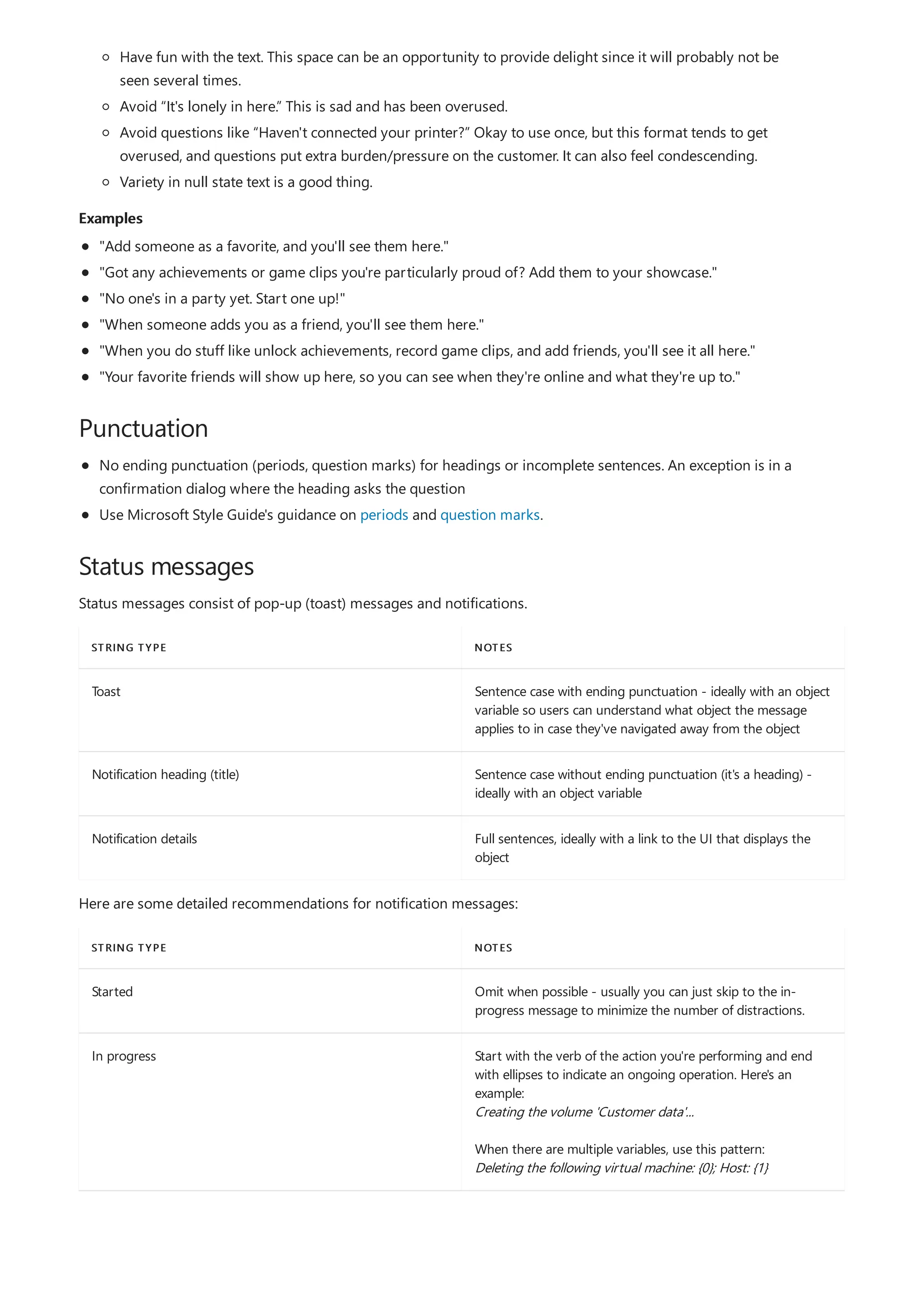

![Using PowerShell in your extension
10/19/2020 • 4 minutes to read • Edit Online
PowerShell in TypeScript
NOTE
Running a PowerShell Script
IMPORTANT
Param
(
[String] $stringFormat
)
$nodeName = [string]::Format($stringFormat,$env:COMPUTERNAME)
Write-Output $nodeName
const session = this.appContextService.powerShell.createSession('{!TargetNode}');
const script = PowerShell.createScript(PowerShellScripts.Get_NodeName, {stringFormat: 'The name of the node is
{0}!'});
Applies To: Windows Admin Center, Windows Admin Center Preview
Let's go more in-depth into the Windows Admin Center Extensions SDK - let's talk about adding PowerShell
commands to your extension.
The gulp build process has a generate step that will take any {!ScriptName}.ps1 that is placed in the
srcresourcesscripts folder and build them into the powershell-scripts class under the srcgenerated folder.
Don't manually update the powershell-scripts.ts nor the strings.ts files. Any change you make will be overwritten
on the next generate.
Any scripts that you want to run on a node can be placed in srcresourcesscripts{!ScriptName}.ps1 .
Any changes make in a {!ScriptName}.ps1 file will not be reflected in your project until gulp generate has been run.
The API works by first creating a PowerShell session on the nodes you are targeting, creating the PowerShell script
with any parameters that need to be passed in, and then running the script on the sessions that were created.
For example, we have this script srcresourcesscriptsGet-NodeName.ps1 :
We will create a PowerShell session for our target node :
Then we will create the PowerShell script with an input parameter:
Lastly, we need to run that script in the session we created:](https://image.slidesharecdn.com/admincenter-201105101733/75/Admincenter-199-2048.jpg)


![WorkItem Options
FUNCTION EXPLANATION
submit() Submits the work item
submitAndWait() Submit the work item and wait for the completion of its
execution
wait() Wait for existing work item to complete
query() Query for an existing work item by id
find() Find and existing work item by the TargetNodeName,
ModuleName, or typeId.
PowerShell Batch APIs
const batchSession = this.appContextService.powerShell.createBatchSession(
['{!TargetNode1}', '{!TargetNode2}', sessionKey);
this.appContextService.powerShell.runBatchSingleCommand(batchSession, command).subscribe((responses:
PowerShellBatchResponseItem[]) => {
for (const response of responses) {
if (response.error || response.errors) {
//handle error
} else {
const results = response.properties && response.properties.results;
//response.nodeName
//results[0]
}
}
},
Error => { /* handle error */ });
PowerShellBatch options
OPTION EXPLANATION
runSingleCommand Run a single command against all the nodes in the array
run Run corresponding command on paired node
cancel Cancel the command on all nodes in the array
If you need to run the same script on multiple nodes, then a batch PowerShell session can be used. For example:](https://image.slidesharecdn.com/admincenter-201105101733/75/Admincenter-202-2048.jpg)



![Enabling the extension discovery banner
10/19/2020 • 3 minutes to read • Edit Online
How the extension discovery banner works
How to implement the extension discovery banner
Example
Applies To: Windows Admin Center, Windows Admin Center Preview
The extension discovery banner feature was introduced in the Windows Admin Center Preview 1903 release. This
feature allows an extension to declare the server hardware manufacturer and models it supports, and when a user
connects to a server or cluster for which an extension is available, a notification banner will be displayed to easily
install the extension. Extension developers will be able to get more visibility for their extensions and users will be
able to easily discover more management capabilities for their servers.
When Windows Admin Center is launched, it will connect to the registered extension feeds and fetch the metadata
for the available extension packages. Then when a user connects to a server or cluster in Windows Admin Center,
we read the server hardware manufacturer and model to display in the Overview tool. If we find an extension that
declares that it supports the current server's manufacturer and/or model, we'll display a banner to let the user
know. Clicking on the "Set up now" link will take the user to Extension Manager where they can install the
extension.
The "tags" metadata in the .nuspec file is used to declare which hardware manufacturer and/or models your
extension supports. Tags are delimited by spaces and you can add either a manufacturer or model tag, or both to
declare the supported manufacturer and/or models. The tag format is "[value type]_[value condition]" where
[value type] is either "Manufacturer" or "Model" (case sensitive), and [value condition] is a Javascript regular
expression defining the manufacturer or model string, and [value type] and [value condition] are separated by an
underscore. This string is then encoded using URI encoding and added to the .nuspec "tags" metadata string.
Let's say I've developed an extension that supports servers from a company named Contoso Inc., with model name
R3xx and R4xx.
1. The tag for the manufacturer would be "Manufacturer_/Contoso Inc./" . The tag for the models could be
"Model_/^R[34][0-9]{2}$/" . Depending on how strictly you want to define the matching condition, there will
be different ways to define your regular expression. You can also separate the Manufacturer or Model tags](https://image.slidesharecdn.com/admincenter-201105101733/75/Admincenter-206-2048.jpg)
![TIP
var regex = /^R[34][0-9]{2}$/
regex.test('R300')
regex.test('R500')
encodeURI(/^R[34][0-9]{2}$/)
<tags>Manufacturer_/Contoso%20Inc./ Model_/%5ER%5B34%5D%5B0-9%5D%7B2%7D$/</tags>
into multiple tags, for example, the Model tag could also be "Model_/R3../ Model_/R4../" .
2. You can test the regular expression with your web browser's DevTools Console. In Edge or Chrome, hit F12 to
open the DevTools window, and in the Console tab, type the following and hit Enter:
Then if you type and run the following, it will return 'true'.
And if you run the following, it will return 'false'.
3. Once you've verified the regular expression, you can encode it in the DevTools Console as well, using the
following Javascript method:
The final format of the tag string to add to your .nuspec file would be:
We understand that a hardware manufacturer may have a very wide range of model names of which some may be
supported while some are not. Keep in mind that this feature is meant to help with the discovery of your extension, but it
does not have to be a perfectly up-to-date inventory of all your models. You can define your regular expression to be a
simpler expression that matches a subset of your models. A user might not see the discovery banner if they first connect to a
server model that doesn't match the condition, but sooner or later they will connect to another server that does and will
discover and install the extension. You can also consider defining a simple regular expression that only matches your
manufacturer name. In some cases, your extension may not actually support a specific model, but you can use the dynamic
tool display feature to define a custom PowerShell script to check model support and only show your extension when
applicable, or provide limited functionality in your extension for models that don't support all capabilities.](https://image.slidesharecdn.com/admincenter-201105101733/75/Admincenter-207-2048.jpg)

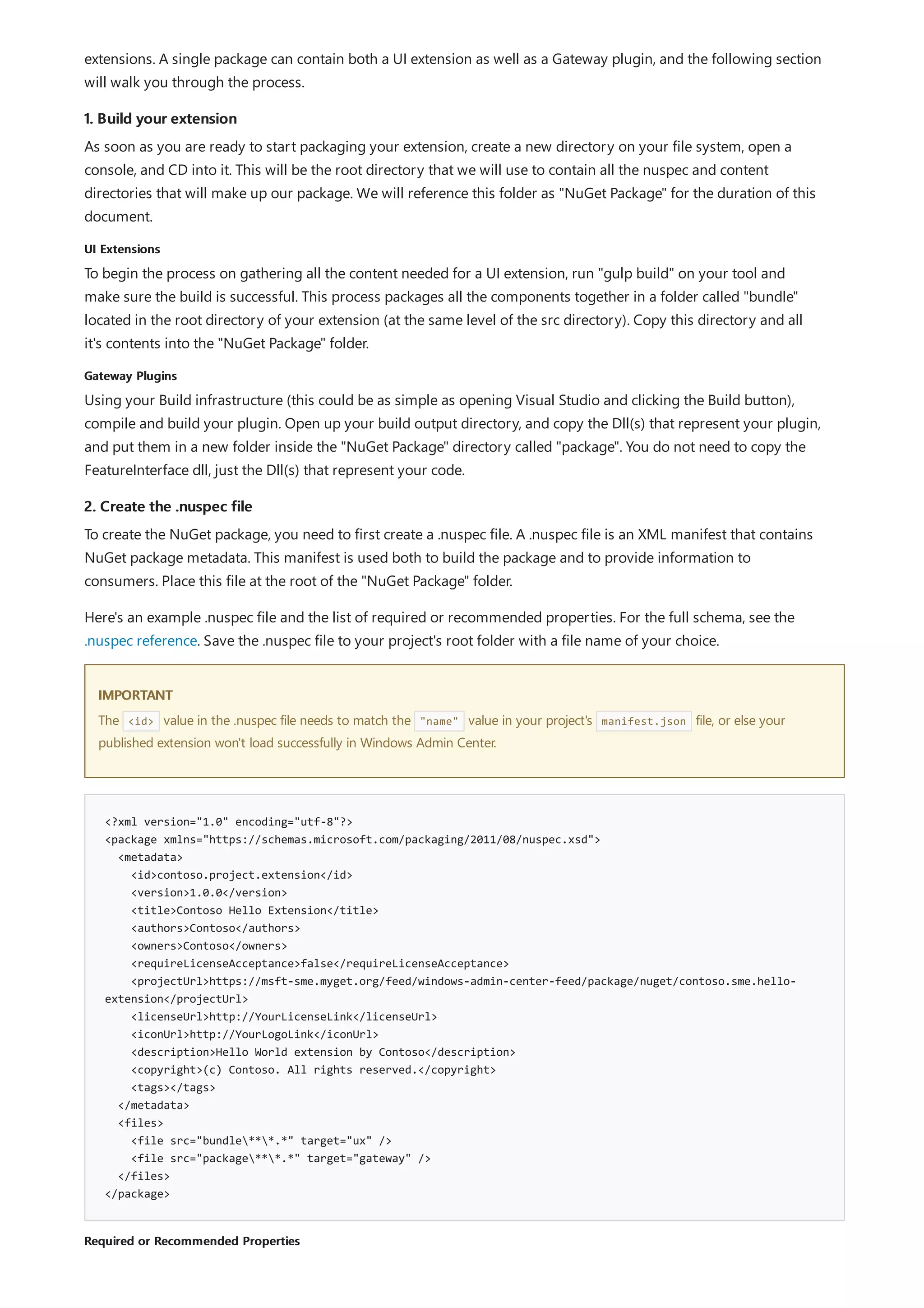
![PROPERTY NAME REQUIRED / RECOMMENDED DESCRIPTION
packageType Required Use "WindowsAdminCenterExtension"
which is the NuGet package type
defined for Windows Admin Center
extensions.
id Required Unique Package identifier within the
feed. This value needs to match the
"name" value in your project's
manifest.json file. See Choosing a
unique package identifier for guidance.
title Required for publishing to the Windows
Admin Center feed
Friendly name for the package that is
displayed in Windows Admin Center
Extension Manager.
version Required Extension version. Using Semantic
Versioning (SemVer convention) is
recommended but not required.
authors Required If publishing on behalf of your
company, use your company name.
description Required Provide a description of the extension's
functionality.
iconUrl Recommended when publishing to the
Windows Admin Center feed
URL for icon to display in the Extension
Manager.
projectUrl Required for publishing to the Windows
Admin Center feed
URL to your extension's website. If you
do not have a separate website, use the
URL for the package webpage on the
NuGet feed.
licenseUrl Required for publishing to the Windows
Admin Center feed
URL to your extension's end user license
agreement.
files Required These two settings set up the folder
structure that Windows Admin Center
expects for UI extensions and Gateway
plugins.
3. Build the extension NuGet package
4. Signing your extension NuGet package
Using the .nuspec file you created above, you will now create the NuGet package .nupkg file which you can upload
and publish to the NuGet feed.
1. Download the nuget.exe CLI tool from the NuGet client tools website.
2. Run "nuget.exe pack [.nuspec file name]" to create the .nupkg file.
Any .dll files included in your extension are required to be signed with a certificate from a trusted Certificate
Authority (CA). By default, unsigned .dll files will be blocked from being executed when Windows Admin Center is
running in Production Mode.
We also highly recommend that you sign the extension NuGet package to ensure the integrity of the package, but
this is not a required step.](https://image.slidesharecdn.com/admincenter-201105101733/75/Admincenter-210-2048.jpg)







